Brecon is a market town in mid Wales and is the county town of the old historic county of Brecknockshire, or Breconshire. The town is the second largest in the county, after Ystradgynlais, and the third largest in the modern county of Powys, which it now lies within. The town of Brecon is synonymous with the famous army regiment, the South Wales Borderers, and the old regimental depot houses the regimental museum, which now incorporates the Welch Regiment and Royal Welch Fusiliers. As a result, many of the young men of Brecon served with the South Wales Borderers during both World Wars and earlier, even during the later post war conflict in Aden. The men of Brecon who died during the Great War of 1914-1918 are commemorated on the town war memorial, which is situated within the grounds of St. Mary’s Church. Additional names were added to the memorial following the end of World War Two, to commemorate the towns fallen from the latter war also.
This page commemorates the men of Brecon who fell during the Great War. The town suffered no female casualties during the conflict. The memorial was unveiled in November 1920 by Mrs Best, who had suffered the terrible loss of three sons during the war.
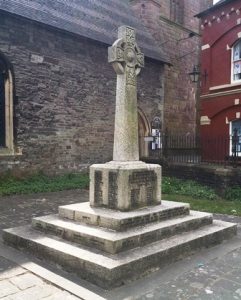
The Great War, 1914-1918
James Robert Angus, Lieutenant-Colonel, Welsh Regiment. James was born in Dumfries on 6 December 1871, the son of James Angus and Emma Angus (nee Hopkins). His father was a Sergeant Major with the 24th Regiment of Foot, South Wales Borderers, and had moved to the Depot at Brecon, where he had married Emma. James had served with the Grenadier Guards during the Boer War of 1899-1901 and upon his return married Edith Prosser, the daughter of Alderman Prosser, of Treharris, in 1903. He had joined the Barry Constabulary in 1893 and by the outbreak of war was serving as a Police Inspector, No PS 310, at Abercynon, and was living with his wife at Vaynor House, Edwardsville. James was commissioned into the 16th Battalion, Welsh Regiment following its formation at Cardiff, and rose through the ranks, being promoted Lieutenant Colonel and being given command of the 11th Battalion, South Wales Borderers on 6 August 1917. Both his former and latter battalions served with 115 Brigade, 38th (Welsh) Division, and James took part in the brigade’s assault on Mametz Wood in July 1916. James commanded the 11th Battalion, South Wales Borderers with distinction during the famed assault of the 38th (Welsh) Division at Pilckem Ridge on 31 July 1917 and in the continued fighting there over the coming weeks until the division was withdrawn to a quieter sector on the Lys to rest and rebuild and for his work was mentioned in despatches by Sir Douglas Haig. On 17 September 1917 James decided to take a swim in the River Lys where it flows through the village of Erquinghem, and tragically drowned. The 45-year-old was buried by his men in grave II.F.8. in the nearby Erquinghem-Lys Churchyard Extension, France. James is not commemorated at Brecon.
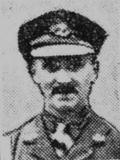
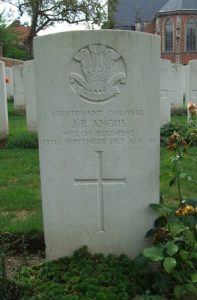
Arthur Waters Barratt, Private, 1668, Australian Infantry. Arthur was born on 26 May 1893, the son of Thomas James Barratt and Mary Ann Barratt (nee Davies), of 12, Postern, Brecon. His mother died later that year, and Arthur was raised with his grandparents, David and Catherine Davies, at Coed Farm, Llandefaelog Fach. By the time of the 1911 Census, Arthur was living in Abercynon, where he worked as an assistant draper in Thomas George’s Emporium. He emigrated to Australia in October 1914 aboard the SS Indrapura and went to live with his uncle Edwin Barratt in Melbourne, where he found work as a book-keeper. He enlisted at Melbourne in the 2nd Reinforcements for the 23rd Battalion, Australian Infantry on 18 May 1915 and soon embarked for Egypt to join the battalion, which was attached to the 6th Brigade, 2nd Australian Division. The battalion was still training in Egypt to join the great fighting at Gallipoli when Arthur arrived. The 6th Brigade then embarked for Lemnos Island before landing at Gallipoli on 4 September 1915 and the men were allowed a day of familiarisation before taking over defensive positions at Lone Pine, which had been the scene of terrible fighting the previous month. The Brigade remained here until the evacuation of the Gallipoli Peninsula on the night of 19/20 December 1915 and moved to Lemnos Island before returning to Egypt in January 1916. The AIF was then re-organised and doubled in strength, by splitting the original battalions and bringing each one up to strength with new recruits, before continuing training before moving to France in March 1916. The AIF initially took over positions in Northern France near Armentieres, for trench initiation, before being transferred to the Somme in the middle of July, following the launching of the great Allied offensive. By now Arthur had transferred to the battalions machine-gun section. The task given to the Australians on the Somme was the capture of Pozieres Ridge, a formidable, heavily fortified, obstacle. The 1st Australian Division began the attack on 23 July 1916, in conjunction with an attack by the 48th Division of the British Army to its south, and during a day of terrible fighting captured much of the village. The fighting then intensified as the Germans counter-attacked. The 2nd Australian Division relieved the survivors of the 1st Division on 27 July and prepared to another attack. Arthur was killed by a German shell at around 00.30 on the following morning, 29 July 1916, just after going ‘Over the Top’. The 24-year-old has no known grave and is commemorated on the Villers-Bretonneux Memorial, France.
Percy Thomas Bate, Gunner, 75834, Royal Field Artillery. Percy was born on 24 June 1896, the son of Richard Bate and Martha Bate (nee Tipton), of 50, Newton Green, Llanfaes, Brecon. Percy enlisted at Merthyr into the Royal Field Artillery prior to the war and was then posted to the 44th Brigade, Royal Field Artillery, which was attached to the 2nd Division. The division embarked for France on 16 August 1914 as part of the BEF, moving to the Belgian frontier town of Mons. On 23 August the Germans attacked and the BEF was forced to withdraw south, bypassing the Forest of Mormal, before making a stand at Le Cateau. In danger of being overwhelmed, the BEF continued to withdraw south, finally crossing the River Marne, east of Paris, on 6 September, where the Germans were stopped. The Germans then withdrew north to the Chemins-des-Dames Ridge, north of the River Aisne, and the BEF and French launched a furious attack, the Battle of the Aisne, on 13 September. The fighting raged for two weeks, with severe casualties suffered by both sides. Percy was wounded during the fighting on the Aisne and died of his wounds as a Casualty Clearing Station there on 27 September 1914. The 18-year-old was buried in Vendresse British Cemetery, Aisne, France.
Benjamin Morris Bather, Private, G/87008, Middlesex Regiment. Benjamin was born in Sydenham, London in 1887, the son of John Morris Bather and Annie Bather (nee Rees). His father died in 1908, so Annie moved her young family back to their native Brecon, to 73, The Struet. Benjamin remained in London, where he worked as a gas fitter, but was a regular visitor to his family at Brecon. He married Mary Roberts, of the Rock and Castle, Brecon, in August 1915, and the couple had a daughter, Florence Olwen Bather, born at Brecon the following year. Benjamin enlisted at Croydon into the army and was posted to Egypt, joining the 2/10th Battalion, Middlesex Regiment, which was in Palestine attached to 160 Brigade, 53rd (Welsh) Division. Benjamin probably arrived in Palestine in time to take part in the Third Battle of Gaza, following two failed earlier attempts. This third offensive was launched against a wider front from Beersheba to Gaza on 31 October 1917. This time the Turkish defences were breached, and the road to Jerusalem now lay open and the EEF began to advance north. On 6 November 1917, 158 Brigade launched an attack on the Khuweilfeh Heights, and once secured, the EEF continued its advance into the Judean Hills, the 53rd Division capturing Hebron and Bethlehem, before securing the Jerusalem to Jericho Road. Allenby finally made his triumphant entry into Jerusalem on 11 December. The Division continued its advance north soon afterwards, capturing Jericho in January 1918, then tell Asur soon afterwards, before continuing its advance into the Valley of the Jordan. Benjamin was killed during this advance, on 23 May 1918. The 30-year-old has no known grave and is commemorated on the Jerusalem Memorial, Israel. His brother, Charles Bather, had been killed in Mesopotamia in 1917, whilst their step-brother, Charles Edward George Phillips, died in 1920. Benjamin is not commemorated on the Brecon war memorial, whilst his brother is.
Charles Edward Bather, Private, 27745, South Wales Borderers. Charles was born in Sydenham, London in 1893, the son of John Morris Bather and Annie Bather (nee Rees). His father died in 1908, so Annie moved her young family back to their native Brecon, to 73, The Struet. He enlisted at Brecon into the Brecknockshire Battalion, South Wales Borderers soon after the outbreak of war. The battalion was attached to the Welsh Division and moved to Pembroke Dock upon mobilisation. It was then withdrawn from the Division and on 29 October 1914 sailed from Southampton for Bombay, where the battalion transhipped and sailed for Aden, arriving on 16 December 1914. The battalion endured a torrid time in the heat of Aden, losing several men to heatstroke. In August 1915 the battalion moved to India on garrison duties. Charles then briefly transferred to the Devonshire Regiment, before being posted to Egypt to join the 4th Battalion, South Wales Borderers, which was attached to 40 Brigade, 13th (Western) Division. The Division had been evacuated from Gallipoli in January 1916 before moving to Egypt, then on 15 February 1916 embarked at Suez, arriving at Basra on 4 March to join the forces being assembled to attempt to relieve the besieged garrison of Kut-al-Amara. Charles was killed in Mesopotamia on 30 April 1917, during the advance to Baghdad. The 21-year-old has no known grave and is commemorated on the Basra War Memorial, Iraq. His brother, Benjamin Morris Bather, was killed in France in 1918, whilst their step-brother, Charles Edward George Phillips, died in 1920.
Arthur Stephen Middleton Best, Lieutenant, Royal Engineers. Arthur was born at Fulham on 25 May 1885, the son of Charles William Best and Julia Martha Diana Best (nee Maybery). By 1889 the family had moved to Penbryn, Brecon, after his father had gained the position as County Surveyor for Breconshire. Arthur was educated at Christ College, together with his brothers Charles, Stephen and Frank, and for a short while after leaving school he studied civil engineering under his father. Arthur then went to the University of London, becoming a Batchelor of Science in Civil Engineering and upon returning home to Brecon enlisted into the Brecknockshire Battalion, South Wales Borderers. In 1913 Arthur left Britain to take up a post in Malaya, but following the outbreak of war, returned to Britain to take up a commission as Second Lieutenant into the Royal Engineers in April 1915. He embarked for the Middle East with the 71st Field Company, Royal Engineers in 1916 and was posted with the company from Egypt to Mesopotamia, following the opening of a campaign intended to relieve the besieged troops in the town of Kut. Arthur was killed in Mesopotamia on 23 February 1917. The 32-year-old is buried in Amara War Cemetery, Iraq. His two younger brothers, Frank Harrington Best and Stephen Wriothesley Best, were also both killed in Mesopotamia. Their only surviving brother, Walter Maybery Best, designed the War Memorial Cross in the school Chapel Yard and the memorial tablet in the school Chapel.
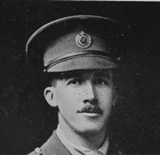
Frank Herrington Best, Lieutenant, South Wales Borderers. Frank was born on 27 June 1894, the son of Charles William Best and Julia Martha Diana Best (nee Maybery), of Penbryn, Brecon. His father had moved the family to the town after gaining the position as County Surveyor for Breconshire prior to Frank’s birth. Frank, as were his brothers, was educated at Christ College. Upon leaving school in 1910 he joined the Central Technical College for Engineering at the University of London, and graduated Batchelor of Science in Civil Engineering. Following the outbreak of war, Frank was commissioned as Second Lieutenant into the Brecknockshire Battalion, South Wales Borderers on 16 August 1914. The battalion was attached to the Welsh Division and moved to Pembroke Dock upon mobilisation. It was then withdrawn from the Division and on 29 October 1914 sailed from Southampton for Bombay, where the battalion transhipped and sailed for Aden, arriving on 16 December 1914. The battalion endured a torrid time in the heat of Aden, losing several men to heatstroke. In August 1915 the battalion moved to India on garrison duties. Frank and his brother Stephen later transferred to the 4th Battalion, South Wales Borderers, which was in Mesopotamia, attached to 40 Brigade, 13th (Western) Division. The Division had been evacuated from Gallipoli to Mudros on 8 January 1916 before moving to Egypt, then on 15 February 1916 embarked at Suez, arriving at Basra on 4 March to join the forces being assembled to attempt to relieve the besieged garrison of Kut-al-Amara. Following the fall of Kut, the 13th Division then took part in an arduous campaign against the Turkish occupiers of Mesopotamia over the coming months. By the time Frank and his brother Stephen arrived in Mesopotamia on 7 February 1917, the 13th Division was preparing to launch an assault upon the Hai Triangle and over the coming days drove the Turks back over the Dahra Bend. Frank was killed whilst holding a poorly constructed section of trench facing the Dahra Bend on 13 February 1917. The 22-year-old has no known grave and is commemorated on the Basra Memorial, Iraq. He was the first of the three Best brothers to be killed in Mesopotamia during the war, as his brothers Arthur and Frank were killed soon afterwards. Their only surviving brother, Walter Maybery Best, designed the War Memorial Cross in the school Chapel Yard and the memorial tablet in the school Chapel.
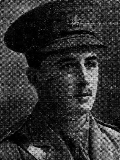
Stephen Wriothesley Best, Lieutenant, South Wales Borderers. Stephen was born on 16 January 1889, the son of Charles William Best and Julia Martha Diana Best (nee Maybery), of Penbryn, Brecon. His father had moved the family to the town after gaining the position as County Surveyor for Breconshire prior to Stephen’s birth. Stephen followed his elder brothers into Christ College and after leaving school in 1906 went to the University of London to study law. He then gained an appointment with the Civil Service in Edinburgh, and lodged at 41, Jordan Lane, Morningside, Edinburgh, where he continued his studies at Edinburgh University. He returned home when war broke out and was commissioned as Second Lieutenant into the Brecknockshire Battalion, South Wales Borderers, together with his brother Frank. The battalion was attached to the Welsh Division and moved to Pembroke Dock upon mobilisation. It was then withdrawn from the Division and on 29 October 1914 sailed from Southampton for Bombay, where the battalion transhipped and sailed for Aden, arriving on 16 December 1914. The battalion endured a torrid time in the heat of Aden, losing several men to heatstroke. In August 1915 the battalion moved to India on garrison duties. Stephen and his brother Frank later transferred to the 4th Battalion, South Wales Borderers, which was in Mesopotamia, attached to 40 Brigade, 13th (Western) Division. The Division had been evacuated from Gallipoli to Mudros on 8 January 1916 before moving to Egypt, then on 15 February 1916 embarked at Suez, arriving at Basra on 4 March to join the forces being assembled to attempt to relieve the besieged garrison of Kut-al-Amara. Following the fall of Kut, the 13th Division then took part in an arduous campaign against the Turkish occupiers of Mesopotamia over the coming months. By the time Stephen and Frank arrived in Mesopotamia on 7 February 1917, the 13th Division was preparing to launch an assault upon the Hai Triangle and over the coming days drove the Turks back over the Dahra Bend. Frank was killed at the Dahra Bend soon after their arrival, and Stephen was wounded soon afterwards. He returned to duty on 21 April and was killed in action soon afterwards, during an assault on the village of Adhaim on 30 April 1917. The 28-year-old has no known grave and is commemorated on the Basra Memorial, Iraq. Two of his brothers, Frank and Arthur, were also killed in Mesopotamia. Their only surviving brother, Walter Maybery Best, designed the War Memorial Cross in the school Chapel Yard and the memorial tablet in the school Chapel.
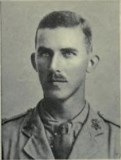
John Bevan, Lance Corporal, 267423, Monmouthshire Regiment. John was the son of James Bevan and Mary Bevan, of 1, Usk Terrace, Brecon. He had worked at the Castle Hotel, Brecon, The Gwalia in Llandrindod Wells and at the Royal Gatehouse, Tenby prior to the war. John enlisted into the Brecknockshire Battalion, South Wales Borderers at Brecon on 9 November 1914 and was initially posted to the 3/1st Brecknocks at Milford Haven. On 2 January 1916 he was posted to the 2/1st Brecknocks at Southwold, before embarking for France at Southampton on 30 July 1916. John joined the Infantry Base Depot at Rouen initially, destined to join the 1/2nd Battalion, Monmouthshire Regiment, but suffered a bout of tonsilitis whilst still at Rouen. The 2nd Battalion, Monmouthshire Regiment was by then the Pioneer Battalion to the 29th Division. John joined the battalion while the Division was rebuilding at Ypres, following heavy losses on the Somme. He returned to action in time to join the 2nd Monmouth’s following the Divisions return to the Somme, where it took part in the latter stages of the Somme offensive. The Division wintered on the Somme, taking part in the advance which followed the German withdrawal to the Hindenburg Line. At the beginning of April, the entire 29th Division moved out of the Somme sector to the Arras sector, and by 9 April took over a section of the line facing Monchy-le-Preux. The Division then began to prepare for the forthcoming Battle of Arras. John was wounded here on 21 May 1917, then returned to action again prior to the divisions transfer to Ypres, where it initially held the line whilst other units had been withdrawn for specialist training, in readiness for the Third Battle of Ypres, which was due to open on 31 July 1917. The 29th Division went into reserve whilst the first attacks, the Battle of Pilckem Ridge, took place, then took part in the Battle of Langemarck. The Division then had another period out of the line to rest and refit before taking part in further fighting near Poelcapelle. Early in October 1917 the Division was relieved from the line at Ypres, and moved south to the Bellacourt area, to prepare to take part in the forthcoming Battle of Cambrai, suffering heavy casualties whilst attacking Masnières, on the Hindenburg Line. After wintering in the Cambrai sector, in January 1918 the 29th Division moved back to Ypres, taking up positions at Passchendaele Ridge again. To the south, the Germans launched the opening phase of their great offensive along the Somme front on 21 March 1918, then on 9 April launched the second phase along the Lys Valley. The 29th Division was relieved by the 41st Division that day and moved out of the line, before being rushed to positions at Les Haies Basses on the evening of 10 April. On the following morning the Division was hit by the Germans and the 29th Division was forced to withdraw, as they were flanked on the left. Heavy fighting raged for the coming weeks, before the Germans switched their focus to the Champagne region in May. John had survived this terrible period, but was wounded during a routine spell working in the line at the beginning of June and died of his wounds on 4 June 1918. The 20-year-old is buried in Ebblinghem Military Cemetery, France.
William Bowen, Able Seaman, J/19493, Royal Navy. William was born on 7 November 1895, the son of Mary Anne Bowen, of 4, London Row, Brecon. His mother was a single 18-year-old, so William was raised by his grandparents, William and Martha Bowen. Upon leaving school, William initially found work as a colliers boy, but left Brecon to enlist into the Royal Navy on 7 November 1913, signing up for 12 years. William trained at HMS Vivid II at Devonport and on 8 January 1914 was posted aboard HMS Prince of Wales, then on 7 May was transferred to HMS Lancaster for two months, before being sent to HMS Vivid I for further training. After furthers spells aboard HMS Lancaster, HMS Temerare and HMS Agincourt, on 27 January 1915 William was posted aboard Minotaur-class armoured cruiser, HMS Defence. Defence had been built at Pembroke Dockyard, and launched on 24 April 1907, and was in the China Station when war erupted. Defence returned to Britain and saw action during the pursuit of the German warships Goeben and Breslau. She then blockaded the German ships inside the Dardanelles until being ordered to the South Atlantic to take part in the hunt for Admiral Graf von Spee’s East Asia Squadron. She then took part in some minor work before re-joining the 1st Cruiser Squadron of the Grand Fleet as its flagship, under the command of Rear-Admiral Sir Robert Arbuthnot. Following reports that the German High Seas Fleet had put to sea in May 1916, the Grand Fleet steamed into the North Sea to locate the Germans. The First Cruiser Squadron formed the starboard flank of the cruiser screen, ahead of the main body of the Grand Fleet, with Defence to the right of the centre of the line. At 17:47 on 31 May 1916 Defence and HMS Warrior, the leading two ships of the squadron, spotted some German ships and opened fire. Shortly afterwards, they spotted the disabled German light cruiser SMS Wiesbaden and closed to engage, however both ships were spotted by the German battlecruiser SMS Derfflinger and four other battleships, which opened fire upon Defence and Warrior. Defence was hit in the magazine which exploded and sent her to the bottom of the North Sea, with all her crew of some 900 men. William was 20 years old when he was killed in the sinking of Defence and is commemorated on the Plymouth Naval Memorial, Devon.
Cecil Hoyle Broadbent, Second Lieutenant, Kings Own Yorkshire Light Infantry. Cecil was born at Cannock on 25 October 1881, the son of James Broadbent and Eliza Broadbent (nee Jennings). His father was a bank manager, and moved the family to Broadbent, Old Colwyn after his retirement. Cecil was educated at Oundle School, before going to Trinity College, Cambridge, where he gained a First in the Classical Tripos. He joined Christ College, Brecon as a Classical Master in 1903 and spent three years there before leaving to take up the post of Classical master at Bradford Grammar School, where he joined the Officer Training Corps. Cecil was commissioned as Second Lieutenant into the 2/4th Battalion, King’s Own Yorkshire Light Infantry in August 1915 and after training with the battalion at Beverley, embarked for France on 19 September 1915 to join the 1/4th Battalion, King’s Own Yorkshire Light Infantry. The battalion was a Territorial Army unit which had mobilised at Wakefield attached to the 3rd West Riding Brigade, West Riding Division and had been in France since 12 April 1915, where its formation became renumbered to 148 Brigade, 49th (West Riding) Division. Cecil joined the battalion at Ypres, where the 49th Division was holding the Canal Bank sector at Boesinghe. After three months in the waterlogged trenches here, the Division was relieved just after Christmas 1915 and after a brief rest at Calais, entrained for the Somme valley, moving to positions near Authille, to the north of Albert, taking over the Authille village defences. Upon their arrival, Cecil was appointed to command the Brigade Bombing School near Albert. Sadly, Cecil was badly wounded following the premature explosion of a bomb whilst he was acting as instructor at Albert. He was evacuated to the nearby Casualty Clearing Station at Warloy-Baillon, where he died of his injuries on 1 March 1916. The 34-year-old is buried in Warloy-Baillon Communal Cemetery, France. Cecil is not commemorated at Brecon.
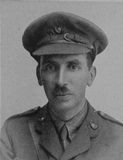
Bernard Pitt Bryant, Private, 7079, King’s Shropshire Light Infantry. Bernard was born in Brecon in 1896 the son of Samuel Pitt Bryant and Mary Pitt Bryant (nee Fury), of 39, The Struet, Brecon. He was raised by his cousin, George Lodge, at White Lion Terrace before moving to the Rhondda to find work as a coalminer and lodged with his sister Mary and her husband John Manning, at 43, Brook Street, Williamstown. Bernard enlisted into the 3rd Battalion, King’s Shropshire Light Infantry at Tonypandy on 26 August 1914 and was posted to Pembroke Dock to join the battalion. On 15 September he was posted to the 6th Battalion, King’s Shropshire Light Infantry, which was at Aldershot attached to 60 Brigade, 20th (Light) Division. In April 1915 the division moved to Larkhill to complete its training, before embarking for France on 22 July 1915, moving to the Fleurbaix Sector for trench familiarisation and training. When the Battle of Loos was launched on 25 September 1915 the Division fought a diversionary attack towards Fromelles and later that year they moved north, and fought at the Battle of Mount Sorrel alongside the Canadian Corps in June 1916. The division was still at Ypres the following month when Bernard suffered an accidental bayonet wound in his right thigh on 10 July and he was evacuated to the 3rd Canadian General Hospital at Boulogne for treatment, before embarking aboard the Hospital Ship St. Denis on 13 July 1916 and returning to Britain for further treatment. Upon his recovery, Bernard embarked for France again on 25 November 1916 and was posted from the Infantry Base Depot to the 7th Battalion, King’s Shropshire Light Infantry, which was on the Somme attached to 8 Brigade, 3rd Division. The division wintered on the Somme and after moving to the Arras sector the following spring took part in the First and Second Battles of the Scarpe, then at the Battle of Arleux and the Third Battle of the Scarpe, where the division captured Roeux. Bernard was hospitalised with pneumonia on 10 August 1917 and after treatment in the 3rd Field Ambulance entrained for hospital at Etretat. He returned to Britain on 7 September 1917 after his health continued to fail and was sent to the 1st Southern General Hospital at Birmingham, where he was diagnosed as having contracted tuberculosis. Bernard was discharged from the army as medically unfit on 17 November 1917 and returned to his sisters home at Williamstown. His health continued to wane, and Bernard died of tuberculosis at home on 27 March 1918. The 27-year-old was buried in Trealaw Cemetery, Rhondda. Bernard is not commemorated at Brecon.
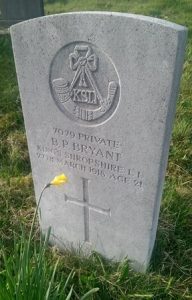
Ernest Butterworth, Private, 244618, The King’s (Liverpool Regiment). Ernest was born in Colne, Lancashire in 1889, the son of Abraham Butterworth and Sarah Butterworth (nee Heap). The family lived in Colne until about 1912, when they moved to nearby Nelson. Ernest enlisted at Colne into the 13th Battalion, The King’s (Liverpool Regiment), which was attached to 76 Brigade, 25th Division. In May 1915 the division moved to Aldershot, then on 27 September 1915 landed at Le Havre, before moving to the Vimy area, where it defended Vimy Ridge against a German attack in May 1916. The division then moved to the Warloy area and attacked on 3 July near Thiepval. It fought throughout the Battle of the Somme, and then moved to Ploegsteert, where it held the line for the months leading up the Battle of Messines in June 1917. After fighting at Messines, the Division took part in the Battle of Pilckem on 31 July, before moving south again, taking up positions around Bullecourt in reserve. Ernest must have been wounded or invalided through sickness at some time, as he transferred to the 2/7th Battalion, Liverpool Regiment, before being posted to the Labour Corps. He was due for discharge from the army and was living at 13, The Watton, Brecon early in 1918 and he married Minnie Garner Jones, the daughter of William Jones, of 1, Newmarch Street, on 18 May 1918. Ernest took ill during the late summer of 1918, contracting influenza, and died at home at Brecon of influenza and pneumonia on 30 October 1918. The 29-year-old was buried with full military honours in Brecon Cemetery. His only child, Ernest William Butterworth, was born the following year.
Charles Guest Campion, Lance Corporal, 619, Australian Infantry. Charles was born in 1882, the son of Thomas Campion and Jane Campion (nee Guest), of 4, Harp Terrace, Brecon. His father, an Irish railway worker, died in 1886. By 1901 Charles was working as a footman in Brecon, before leaving home to join the Mercantile Marine, and by 1911 was living in New Zealand. At least two of his siblings, his sisters Helena and Florence, had emigrated to Australia prior to the war and Charles joined them at sometime after 1911, whilst still working at sea as a Ships Steward. He enlisted at Sydney into the newly raised 4th Battalion, Australian Infantry on 26 August 1914. The battalion trained at Randwick Racecourse, as part of the newly formed 1st Australian Division, before embarking aboard the Troopship Euripides on 20 October 1914, bound for Alexandria via the Suez Canal. The Australians were initially destined for the Western Front, but whilst training in Egypt, plans were drawn up to open a second front at Gallipoli, so on 25 April 1915 the Australians landed at Anzac Cove as part of a huge invasion force. The Australians saw heavy fighting throughout the Gallipoli campaign, before the evacuation of the peninsula in December 1915, and returned to Egypt. On 29 March 1916, the 4th Battalion boarded the troopship Transylvania and sailed from Alexandria to join the BEF in France, landing at Marseilles on 6 April 1916. After a quiet period of trench initiation in the Fleurbaix Sector, the Australians were moved to the Somme, being billeted around Warloy Baillon. The Australians were sent into action on 23 July 1916, tasked with the capture of the strongly defended Poziéres Ridge. The village of Poziéres was taken by the Australians at a huge cost in lives and remains one of the greatest feats of arms of WW1. After taking Poziéres, the front that the Australians now occupied was facing the renowned German Stronghold of Mouquet Farm. Despite their best efforts, the Australians failed to take the farm, suffering terrible casualties before being relieved by the Canadians. Charles survived the terrible fighting on the Somme, but in September took ill and was hospitalised for a while before returning home to Brecon on leave. By the time he returned to France the Australians were following the German withdrawal to the Hindenburg Line. The 4th Battalion was in the line near Demicourt on 15 April 1917 when Charles was posted as missing. A subsequent court of enquiry later found that the 34-year-old had been killed by a shell that day. He has no known grave and is commemorated on the Villers-Bretonneux Memorial, France. (His name is in fact just above that of my great grandfather, David Thomas John, who served alongside Charles).
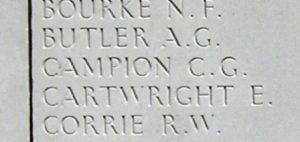
David James Charles, Private, 52450, Lancashire Fusiliers. David was born in Machen in 1883, the son of Rees Charles and Sarah Charles (nee Prosser). His father was a railway inspector, so the family moved around quite often. They had moved to Oswestry by 1901, but by 1911 had moved to 4, St. John’s Road, Brecon, where David worked as an Ironmongers assistant. David was possibly living in North Wales by the time war broke out, as he enlisted at Colwyn Bay into the 20th Battalion, King’s (Liverpool Regiment). The battalion was raised in Liverpool by Lord Derby, before moving to Belton Park, Grantham to join 89 Brigade, 30th Division. The Division moved to Larkhill in September 1915 to complete its training, before embarking for France in November 1915. The division took part in its first major action during the Somme Offensive, at the Battle of Albert, where it captured Montauban. It then fought during the latter stages of the offensive, during the Battle of Le Transloy, before wintering on the Somme. At some time during the war, David was transferred to the 1/5th Battalion, Lancashire Fusiliers, which had landed in France from Egypt in February 1917, attached to 125 Brigade, 42nd (East Lancs) Division. The division initially took over the line near Épehy then Havrincourt. In September it moved north to Ypres, where it fought during the early stages of the Passchendaele offensive, until moving to the Coast in September to refit. November 1917 saw the division moving to positions at Givenchy, where it remained until moving back south in early 1918. Here the division faced the German Spring Offensive of 21 March on the Somme and took part in an epic withdrawal towards Arras over the coming weeks. The Germans switched their attention elsewhere in April and the 42nd Division took the opportunity to rebuild. Following the Australian, British and Canadian victory at Villers Bretonneux on 8 August, the Allies went on the offensive and attacked the German lines on the Somme on 21 August. The 42nd Division was in the line west of the Beaucourt to Puisieux road when it launched its assault that day, and began the great offensive that was eventually to end the war. David was killed in action during a German counterattack on the following day, 22 August 1918. The 35-year-old is buried in Sucrerie Military Cemetery, Colincamps, France.
James Clark, Private, 14639, Gloucestershire Regiment. James was born on 28 October 1891, the son of Thomas William Clark and Martha Clark (nee Davies), of Cradoc Cottage, Brecon. His father worked as a gardener at Penoyre House. James left home by 1911 and was lodging at Dowlais, where he worked as a grocer’s assistant. James enlisted into the 12th (Bristol) Battalion, Gloucestershire Regiment at Bristol soon after the outbreak of war. The battalion had been raised in the city, then in June 1915 moved to Wensleydale joining 95 Brigade, 32nd Division. The division moved to Salisbury Plain to complete its training in August 1915 before landing in France on 21 November 1915. Soon afterwards, 95 Brigade transferred to the 5th Division, which was holding the line near Suzanne, in the Somme valley. The brigade then began trench initiation in the line near Maricourt over the coming weeks, before the 5th Division transferred to the Arras sector, taking over positions east of the city at the beginning of March. The division endured a trying few months here, with trench raids, sniping and mining activity almost incessantly. The division was moved out of the line for a brief rest at the end of June, before moving back to the Somme sector, moving into trenches at Caterpillar Valley by 20 July before taking over the line at Longueval, where 95 Brigade took part in an assault upon some heavily defended orchards. The brigade then endured several days of heavy shelling before completing the capture of Longueval. The 12th Gloucester’s were relieved on 29 July, moving back into reserve. In the meantime a series of attacks were carried out in the direction of Guillemont, before the 5th Division took the line again, ready to take part in an assault upon the heavily defended village. The men advanced at dawn on 3 September 1916 behind a rolling artillery barrage, before 95 Brigade came under fire from its flank, suffering heavy casualties. The village of Guillemont was captured during the day, but the 12th Gloucester’s had suffered severe casualties, with over 300 men killed, wounded or missing. James had been killed in action during the day. The 24-year-old has no known grave and is commemorated on the Thiepval Memorial, France. James is not commemorated at Brecon.
Thomas John Clark, Lance Corporal, 8114, South Wales Borderers. Thomas was the son of Frederick and Louisa Clark, of 9, Victoria Buildings, Westbury-on-Trym, Bristol. He enlisted into the South Wales Borderers at Devonport as a young man and came to live at the Depot at Brecon. Thomas married Edith Beatrice Williams, the daughter of Philip and Mary Anne Williams, on 2 September 1910 and the couple set up home at 19, Newgate Street, Llanfaes, Brecon. By the time war erupted, Thomas was serving with the 1st Battalion, South Wales Borderers at Bordon. The battalion moved to France at the outbreak of war, attached to 3 Brigade, 1st Division, moving to the Belgian frontier near Mons to join the BEF. The division then took part in the Battle of Mons on 23 August 1914, before being forced to withdraw south with the rest of the BEF, skirting the Forest of Mormal before continuing the great retreat from Mons over the coming days. The BEF reached the River Marne, east of Paris, by 5 September, before a combined French and British attack forced the Germans to withdraw north to the heights of the Chemin-des-Dames Ridge, north of the River Aisne. On 10 September the Allies attacked the ridge and heavy fighting raged over the coming days as both sides battled for superiority. Thomas was killed in action here on 26 September 1914, during a day in which the author of the battalion war diary called ‘The most ghastly day of my life…’ The 28-year-old has no known grave and is commemorated on the La Ferté-Sous-Jouarre Memorial, Seine-et-Marne, France.
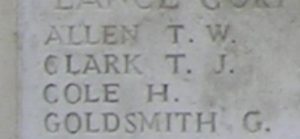
William Henry Clarke, Private, 11135, South Wales Borderers. William was the son of Samuel Clarke and Elizabeth Clarke (nee Jones), of 15, Newgate Street, Llanfaes, Brecon. He worked as a cowboy at Llwyncynog Farm as a young man, before gaining work for Messrs Tyler and Sons at Brecon. William enlisted at Manchester into the South Wales Borderers at sometime prior to the war. He was drafted out to France on 13 November 1914 to join the 1st Battalion, South Wales Borderers, which was at Ypres attached to 3 Brigade, 1st Division. The Division was by then a shadow of its former self, having been virtually annihilated during the First Battle of Ypres, when 3 Brigade held on at Gheluvelt despite overwhelming odds. The Division then moved to positions north-east of Bethune, near Richebourg for the winter and took part in its first major action of 1915 here on 9 May 1915, during the Battle of Aubers Ridge, when it attacked alongside the Meerut Division. Heavy casualties were suffered again when the Division attacked over the flooded and boggy ground and the battle ended in failure. The Division then moved further South to Loos, and saw heavy fighting during the Battle of Loos, and the action at the Hohenzollern redoubt. During July 1916 the Division moved south, to join the great Somme offensive, and reached Albert by 11 July, taking up billets in the town. On the morning of 15 July, 3 Brigade received orders to proceed via the recently captured Mametz Wood to the new front line, facing Bazentin Ridge, and took over positions near Bazentin-le-Petit Wood. On the following morning the brigade took part in its first assault on the Somme, but came under intense machine-gun fire, forcing the battalion to withdraw. On 19 July, after a torrid spell in the line, the brigade was relieved and moved into reserve for a rest. The division saw further fighting on the Somme during the later battles of Pozieres, Flers-Courcelette and Morval, before wintering on the Somme. The 1st SWB was in support in the Flaucourt area on 22 February 1917, in ‘conditions far from cheerful…’, when William was killed by a German shell whilst on a working party. The 20-year-old has no known grave and is commemorated on the Thiepval Memorial, France. He had been wounded three times prior to his death.
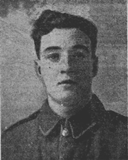
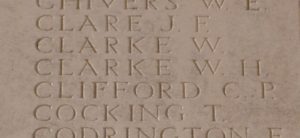
William Thomas Clifford, Lance Sergeant, 7975, South Wales Borderers. William was born in Cheltenham in 1886, the son of Henry and Annie Clifford. The family moved to Brecon in about 1893, where Henry kept his own butchers shop. William enlisted into the South Wales Borderers in 1903 and served in South Africa until contracting enteric fever and was hospitalised at Bloemfontein before being sent home. He spent three years at Brecon before leaving the army early in 1911 and lived with his brother Robert at Church Terrace, Ystradgynlais after finding work as a coal picker. He married Daisy Olive Dugdale in 1912. William re-joined the colours when war erupted and he embarked for France with the 1st Battalion, South Wales Borderers, which was attached to 3 Brigade, 1st Division. The division landed in France on 12 August 1914 and moved to Mons with the BEF, taking part in the subsequent retreat from Mons to the Marne and from 12 September fought in the Battle of the Aisne. Conditions during the retreat were terrible, the war diary of the 1st SWB for 16 September states: ‘I have never spent and can imagine that I will never spend a more ghastly and more heart-tearing forty eight hours than the last…’ The day was one of incessant fighting, which continued over the coming days. William was killed in action on 18 September 1914 when he was shot through the lungs. The 28-year-old was buried on the battlefield by a comrade who had been in school with him in Brecon, but his grave was lost, so he is now commemorated on the La Ferté-Sous-Jouarre Memorial, France.
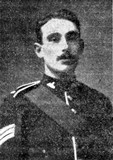
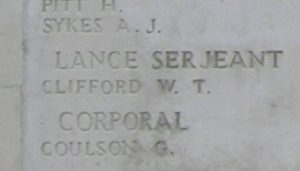
Percy Alexander Coombe, Private, 1781, South Wales Borderers. Percy was born in Exeter on 15 May 1895, the son of John Coombe and Ellen Elizabeth Coombe (nee De Viell). His father was a gas fitter, and former soldier, and had moved the family to Swansea by 1901, before moving to 10, Dainter Street, Brecon. Percy, together with two of his brothers and their father, enlisted at Brecon into the Brecknockshire Battalion, South Wales Borderers. The battalion was attached to the Welsh Division and moved to Pembroke Dock upon mobilisation. It was then withdrawn from the Division and on 29 October 1914 sailed from Southampton for Bombay, where the battalion transhipped and sailed for Aden, arriving on 16 December 1914. The climate in Aden was fearsome, with scorching heat during the day, and with little to do, the men spent much of their free time playing football. By June 1915 the Turks had become overconfident due to the lack of any incursions by the British into Yemen and moved forward to reoccupy fortifications at Sheikh Saad. They then began to shell the island of Perim, so the Allied troops in Aden were mobilised into the Aden Movable Company and ordered to prepare to join with local troops. 400 men of the Brecknocks were allocated to the column, the remainder stayed in Aden. A small artillery column was built up to join it and on 3 July the force moved out to Sheikh Othman. Many men collapsed on the march, which was carried out during the full heat of the day, but by 7.30 pm the column had completed its six mile advance. Percy was among thirteen men who died of heatstroke during the following day, 4 July 1915, during an even longer march. The 20-year-old has no known grave and is commemorated on the Heliopolis (Aden) Memorial, Egypt.
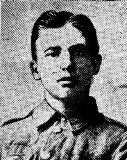
Albert Alfred Cornish, Regimental Sergeant Major, 4/12752, South Wales Borderers. Albert was born at Islington, London on 1 March 1877, the son of Alfred William Cornish and Elizabeth Ann Cornish (nee Taft). His father was a musician and professor of music and Albert followed in his profession, listing his profession as a musician when he enlisted into the South Wales Borderers in London on 26 April 1893 and within two days was at the Depot in Brecon. Due to his tender age, Albert initially served as a drummer with the regiment, but by the time he embarked for South Africa with the 2nd Battalion, South Wales Borderers in October 1899, he had been promoted to corporal. Albert saw extensive service in South Africa during the Boer War, earning the Queen’s South Africa Medal with four clasps. The 2nd SWB returned to Brecon in 1904 and during the following years, Albert met Elizabeth Dowdeswell, of 6, High Street, who he married at Brecon on 4 February 1909. He then embarked overseas for South Africa again with the 2nd SWB, but decided to retire in 1912, returning home to his young family in Brecon. Following the outbreak of war, Albert re-enlisted into his old regiment, and was posted as RSM to the 4th Battalion, South Wales Borderers. The battalion formed at Brecon, before moving to Park House Camp, near Tidworth to join 40 Brigade, 13th (Western) Division, then moved to billets in Cirencester before moving to Woking in March 1915 for final training. On 29 June 1915 the Division sailed from Avonmouth for Mudros, before landing at Cape Helles, Gallipoli on 15 July 1915. Two weeks later the Division was moved to Anzac, to reinforce the Australian and New Zealand troops there, in readiness for a great assault on the Sari Bair Ridge, in conjunction with fresh Allied landings at Suvla Bay. The assault began on 6 August 1915 and raged over the coming days. The 4th SWB reached the Achyl Dere before assaulting, and seizing Damakjelik Bair, one of the ridges held by the Turks. The Turks counter-attacked on 9 August and terrible fighting raged throughout the day. The Division remained at Gallipoli over the coming months, as the fighting drew to a close, and suffered terribly when winter hit the peninsula, bringing floods and disease. The Division was finally evacuated to Mudros on 8 January 1916 before moving to Egypt, then on 15 February 1916 embarked at Suez, arriving at Basra on 4 March to join the forces being assembled to attempt to relieve the besieged garrison of Kut-al-Amara. Albert had not been in Mesopotamia long before he contracted dysentery and was evacuated to the 3rd British General Hospital at Basra. He died there of dysentery on 22 June 1916, aged 39. Albert is buried in Basra War Cemetery, Iraq. His widow, Elizabeth, also lost her brother William during the war. Albert is not commemorated at Brecon.
Ernest Cripps, Private, 16250, Grenadier Guards. Ernest was born on 5 October 1894, the son of William George Cripps and Elizabeth Ann Cripps (nee Perrott), of 2, Harp Terrace, Brecon. Ernest was educated at Mount Street School, then left Brecon to enlist into the Grenadier Guards. Upon completing his training, Ernest joined the 2nd Battalion, Grenadier Guards, which was at Chelsea, attached to the 4th (Guards) Brigade, 2nd Division. On 15 August 1914 the battalion landed at Le Havre, and moved to positions on the Belgian frontier, near Mons. When the Germans invaded Belgium on 23 August 1914, the 2nd Division saw heavy fighting during the Battle of Mons, before retreating southwards with the BEF, taking part in the Affair of Landrecies, the Rearguard Actions of Villers-Cotterets, and at the Battle of the Marne where the German offensive was finally stopped. The Germans retreated north to the Chemins des Dames ridge, and the BEF followed, seeing heavy fighting again during the Battle of the Aisne. The 2nd Division was then moved to Flanders with the rest of the BEF, taking part in the First Battle of Ypres, when the German sweep through Flanders was stopped. George had a miraculous escape at Ypres, when a German bullet hit his water bottle, which stopped the projectile. The 2nd Division then moved slightly south for the winter and in the spring of 1915 took part in the Battle of Festubert. On 20 August 1915 the 2nd Battalion, Grenadier Guards transferred to the newly formed 1st Guards Brigade, Guards Division. The division saw its first action during the Battle of Loos, which opened on 25 September 1915, and remained in the area during the coming weeks, taking part in the subsequent Action of Hohenzollern Redoubt. George returned home on leave just after the Battle of Loos and had not been back in France long when he was killed in action when the battalions lines at Vermelles were subjected to an intensive two-hour long artillery barrage on 11 October 1915. The 21-year-old was buried in St. Mary’s A.D.S. Cemetery, Haisnes, France.
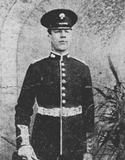
David Dacey, Private, 267449, Monmouthshire Regiment. David was born on 11 April 1880, the son of Cornelius Dacey and Ann Dacey (nee Price), of 4, Honddu View, Brecon. He worked as a plasterer and mason of John Griffiths, of Brecon. David married Alma Pryce in 1899 and after living with his parents for a while, the couple set up home at 10, Maendu Street, Brecon. David enlisted into the Brecknockshire Battalion, South Wales Borderers at Brecon on 1 January 1915 and joined the 2/1st Brecknocks in the barracks at Brecon. In April 1915 the battalion moved to Dale, on the Milford Haven Defences, then at the end of 1915 moved to Bedford to join the 68th (2nd Welsh) Division. David embarked for France on 30 July 1916 to join the 2nd Battalion, Monmouthshire Regiment, which was by then the Pioneer Battalion to the 29th Division. The Division had suffered terrible casualties at Beaumont Hamel, during its assault on Y-Ravine on 1 July 1916 and, although severely depleted, the Division remained in the line here over the coming weeks, in trying conditions. On 27 July the Division entrained for Flanders, detraining at Proven before relieving the 6th Division at Ypres. David joined the 2nd Monmouth’s at Ypres soon after its move. The Division held the line here over the coming weeks as it rebuilt its strength and the 2nd Monmouth’s worked hard on improving trenches and digging new communications trenches. The battalion then worked on the Menin Road, erecting elephant shelters, then on 4 October the Division was relieved and entrained south for the Somme once more, moving to Trônes Wood, before joining the latter stages of the Somme offensive. The Division wintered on the Somme, with the 2nd Monmouth’s working on road repairs around Montauban, then at Ginchy, Flers and Morval. The 2nd Monmouth’s moved into reserve at the end of December and moved to Fourdrinoy, where the men trained in infantry assault manoeuvres. On 12 January 1917 the battalion began marching back into the battle area, taking over positions near Morval, and began supplying working parties around Montauban once more. The Division followed the German withdrawal to the Hindenburg Line soon after, before transferring to the Arras Sector and took part in a gallant assault on Monchy-le-Preux during the opening of the Arras Offensive. The Division then moved north, to the Ypres Salient, initially to relieve the 38th (Welsh) Division at Boesinghe, so the division could train in readiness for the Passchendaele offensive. The 29th Division then moved into reserve whilst the 38th Division launched its assault, before taking over the line in August and taking part in the Battle of Langemarck. The Division saw further fighting throughout the Passchendaele offensive before moving south to take part in the Battle of Cambrai. After further heavy fighting, the division moved back to Flanders early in 1918. The German Spring Offensive hit the British on the Somme on 21 March 1918, and hit in Flanders just weeks later, on 9 April 1918. David survived the terrible fighting which followed over the coming weeks, but took ill whilst in camp and died of an internal haemorrhage on 24 April 1918. The 37-year-old was buried in La Kreule Military Cemetery, Hazebrouck, France. His youngest son, Frederick Verdun Dacey, was killed whilst serving with the RAF in 1942.
Charles Davies, Private, 3600, South Wales Borderers. Charles was born on 22 March 1892, the son of David Davies and Jane Davies (nee Griffiths), of 3, Rock and Castle, Brecon. He worked as a plasterer prior to the war. Charles married Margaret Jones of The Rectory, Llangynidr on 13 December 1913 and the couple lived at King Street, The Struet, Brecon. He enlisted into the Brecknockshire Battalion, South Wales Borderers in April 1916 and was posted to Bedford to join the 2/1st Brecknocks. As soon as he completed his training, Charles was drafted to India to join the 1st Brecknocks, which had moved there from Aden in August 1915 for garrison duties. Charles had sadly not long arrived in India, when he took ill and died of enteritis ulcerative on 3 August 1916. The 23-year-old was buried in Mhow New Cemetery, India. An elder brother, David James Davies, died in 1902 after returning home from serving with the Breconshire Volunteers in the South African War. His son, Vernon David Davies, died whilst serving with the South Wales Borderers in 1942. His widow, Margaret, was granted a grant from Brecon Council to train as a midwife and by the time of Vernon’s birth, was living at 30, Church Street, Cilgerran, in Pembrokeshire.
David Stanley Davies, Private, 8/4444, Otago Infantry Regiment. David was born on 2 January 1890, the son of William Davies and Margaret Gwen Davies (nee Williams), of The Bell Inn, Brecon. Stanley was educated at Brecon County School before moving to Aberystwyth to study agriculture. After completing his studies, he embarked for New Zealand aboard the SS Athenic on 5 February 1914 and after disembarking at Wellington found work as a shepherd for Mr James Bell, at Twyford, Hastings. Stanley enlisted into the reinforcements for the Otago Infantry Regiment at Wellington on 16 November 1915 and embarked aboard HMNZ troopship 49 on 2 April 1916 and disembarked at Suez on 3 May, joining the 1st Battalion, Otago Regiment. The battalion was formed from the splitting of the original Otago Infantry Battalion, which had been evacuated from Gallipoli and joined the newly formed 1st Infantry Brigade, New Zealand Division. On 20 May, David embarked at Alexandria for Marseilles with the battalion aboard HMT Ivernia and entrained for Étaples to join the Base Depot. He suffered a spell of enteritis soon after his arrival and was hospitalised for a while, before re-joining the 1st Battalion, Otago Regiment at Armentieres on 28 July 1916. The New Zealanders had moved here to the Nursery Sector to acclimatise to the Western Front, before moving south to the Somme in September 1916, taking part in the Battle of Flers-Courcelette. The New Zealanders also fought in the subsequent Battle of Le Transloy before moving out of the line to refit, moving back north to Flanders, to the Steenwerck sector. David was in the line here on 12 February 1917 when he was killed by a German shell which crashed into the battalions trenches. The 26-year-old was buried in Ration Farm Military Cemetery, La Chapelle-D‘Armentieres, France.
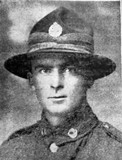
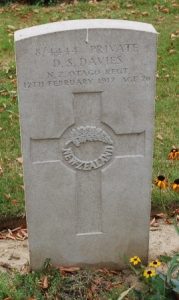
Ifor Garfield Davies, Second Lieutenant, Duke of Edinburgh’s (Wiltshire Regiment). Ifor was the son of David John Davies and Magdalene Davies (nee Moses), of The Green Dragon, High Street, Brecon. He was educated at Mount Street School and then at the Brecon County School, before becoming a clerk at Barclays Bank at Hay. Ifor enlisted into the 26th (Stockbroker’s) Battalion, Royal Fusiliers soon after the outbreak of war and served in France with the battalion from 27 May 1916 until 12 August 1917, when he returned to Britain for officer training. Ifor was commissioned as Second Lieutenant into the Duke of Edinburgh’s (Wiltshire Regiment) on 26 March 1918 and was posted to France, joining the 2nd Battalion, Wiltshire Regiment at Auchy au Bois on 22 July 1918. The battalion was by then attached to 58 Brigade, 19th (Western) Division and was still rebuilding following heavy losses suffered during the Third Battle of the Aisne from 27 May until being relieved on 6 June. The battalion embussed for Chocques on 6 August and on the following day took over positions in the front-line northeast of Hinges, for the first time in two months. Ifor was killed in action by a shell-burst here just two days later, on 8 August 1918. The 24-year-old was buried in Le Vertannoy British Cemetery, Hinges, France.

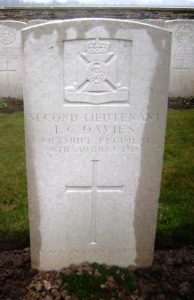
John Davies, Sergeant, 279219, Royal Engineers. John was born at Rhuddlan on 27 July 1883, the son of Edward and Hannah Davies. The family moved to 40, Cunliffe Street, Rhosddu, Wrexham soon after John’s birth, after his father had gained work in an iron foundry there. John was educated at Wrexham before entering the University College of North Wales in 1901 where he studied Pure and Applied Mathematics. After graduating from Brecon, John gained a position as a Maths teacher at Blandford School, in Dorset, but joined the staff of Brecon County School in 1908. He taught there for eight years until being drafted into the army in March 1916 and joined the Royal Engineers. As a mathematician, John was posted to the newly formed Anti-Gas Establishment in London, which had been set up to research and identify methods to deal with the now common use of poison gas, which had been introduced by the Germans at Ypres on 22 April 1915. John served with the Anti-Gas Establishment for the duration of the war, but contracted pneumonia after the Armistice and died of influenza at Sycamore Road Military Hospital, Nottingham on 27 November 1918. The 34-year-old was cremated at Nottingham, but his ashes were buried with his parents in Wrexham Cemetery, Denbighshire. John is not commemorated on the Brecon war memorial.
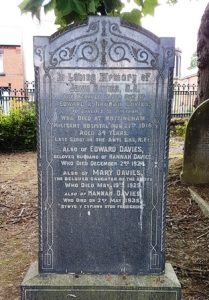
Wilfred John Davies, Lieutenant, Royal Field Artillery. Wilfred was born at Pontypool in 1876, the son of George and Annie Davies. The family had moved to 25, Church Street, Brecon by 1881, then by 1891 had moved to 1, Free Street. William was educated at Dr Coke’s Memorial School and upon leaving school enlisted into the Royal Field Artillery in 1893. Wilfred served continuously with the Royal Field Artillery over the coming years, having two spells in India and the North-West Frontier, and had married Margaret Bland Evans whilst stationed at Pembroke Dock in 1903. The couple had two children, a son, Clifford, born in 1908, and a daughter, Phillis, born in 1910. By the time that war erupted, Wilfred had risen to the rank of Sergeant Major. With his vast experience, he was commissioned as Second Lieutenant on 26 December 1914 and was posted to the 70th Brigade, Royal Field Artillery, which was attached to the 15th (Scottish) Division. The Division landed in France during July 1915, and soon gained a reputation as one of the most formidable in the British Army. The Division fought at the Battle of Loos from 25 September 1915, and in Spring 1916, the Division was involved in German gas attacks near Hulluch, and in the defence of the Kink position. In July it moved to the Somme, where it took part in the Battle of Pozieres. After a brief rest the division then fought at Battle of Flers-Courcelette, where it captured Martinpuich. The next major action for the division was in October, when it fought at the Battle of Le Transloy, and also in the Attacks on the Butte de Warlencourt. Wilfred was in action near Warlencourt when he was hit in the head and killed by a piece of shrapnel on 5 November 1916. The 39-year-old was buried in Warlencourt Military Cemetery, France. His nephew, James Philip Arthur James, had been killed earlier in the war.
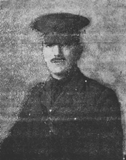
Harry Skeel Duncan Dempster, Lance Corporal, R/6328, Kings Royal Rifle Corps. Harry was born at Bromyard, Herefordshire in 1888, the son of Robert Dempster and Margaret Dempster (nee Evans). By 1891 the family had moved to Canal Bank Cottage, Brecon, where his father had gained a position as Huntsman. He was educated at Christs College and at Brecon Grammar School. Harry worked as a clerk prior to enlisting at Haverfordwest into the King’s Royal Rifle Corps on 2 November 1914 and was posted to their depot at Winchester, before joining the newly formed 7th Battalion, King’s Royal Rifle Corps, which was at Marlborough Lines, Aldershot, attached to 41 Brigade, 14th (Light) Division. In November 1914 the battalion moved to Grayshott, near Hindhead in billets, then in February 1915 to Bordon, before moving to Aldershot in March to complete its training. On 19 May 1915 the battalion landed at Boulogne and the entire division moved to the Ypres Salient, for trench initiation alongside the 5th Division. The Division was to see its first major action during the Action of Hooge in July 1915, where the Division became the first to be attacked by the German use of flamethrowers. The Division remained in the Hooge Sector, in terrible conditions after this horrific attack, suffered heavy casualties on a regular basis. Harry was shot in the head and badly wounded at the end of July 1915 and was evacuated to No 24 General Hospital at Étaples, where he died of his wounds on 2 August 1915. The 27-year-old was buried in Étaples Military Cemetery, France. His brother Robert George Duncan Dempster was killed in France in 1918. The brothers are commemorated on the war memorials at Wiston and Clarbeston Road, in Pembrokeshire, where their father was born and moved back to after retirement. Neither Harry nor his brother Robert are commemorated on the Brecon war memorial.
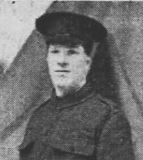
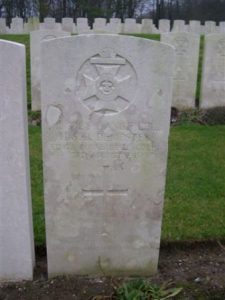
Robert George Duncan Dempster, Private, 227181, Monmouthshire Regiment. Robert was born at Fishguard in 1882, the son of Robert Dempster and Margaret Dempster (nee Evans). By 1891 the family had moved to Canal Bank Cottage, Brecon, where his father had gained a position as Huntsman. Robert lived with his uncle, Thomas Evans, at Dolgwili, Abergwili, and was the secretary of the Abergwili Show. Robert enlisted at Newport into the 2/1st Battalion, Monmouth Regiment soon after the outbreak of war. The Battalion formed at Newport on 20 February 1915 as part of the Welsh Border Brigade, Welsh Division. On 19 April they moved to form part of 205 Brigade, 68th Division, and remained on Home Service until the Division was disbanded on 31 March 1918. The men of the 2/1st Monmouth’s must have been sent to reinforce the 1/1st Battalion in France, who were the Pioneer Battalion to the 46th Division. By this time, the German Spring Offensive was at its height, and the Allied armies were suffering a terrible onslaught, with many Battalions being almost wiped out. The War turned in the Allies favour on 8 August 1918, the ‘Black Day of the German Army’, when Australian troops won a decisive battle at Villers Bretonneux, and from that day on the Allies held the upper hand. The 46th Division pushed the Germans back in Flanders, then moved southwards, forcing a crossing over the formidable Hindenburg Line at Riqueval Bridge, and pushing on toward Cambrai. Robert was badly wounded on 10 October 1918, and died of his wounds at No 12 Casualty Clearing Station that same day. The 36-year-old is buried in Tincourt New British Cemetery, France. His brother Harry Skeel Duncan Dempster died in France in 1915. The brothers are commemorated on the war memorials at Wiston and Clarbeston Road, in Pembrokeshire, where their father was born and moved back to after retirement. Neither Harry nor his brother Robert are commemorated on the Brecon war memorial.
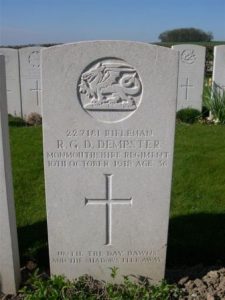
William Francis Trevor Dixon, Second Lieutenant, Sherwood Foresters (Notts. and Derby) Regiment. William was born in Brecon on 6 Jun 1897, the son of George Hutton Dixon and Gwenllian Blanche Dixon (née) Joseph. His father died soon afterwards, so his mother moved in with her parents at 100, The Struet, Brecon with William and his brother Donald. William was educated at Mount Street School in Brecon, before entering St. Cuthbert’s College at Worksop in 1910. By the time he left school, in 1915, his mother had remarried to Ernest Goslin and moved with her husband to Enfield in Middlesex. Whilst at Worksop, William was a member of the Officer Training Corps. He was commissioned as Second Lieutenant into the Sherwood Foresters on 3 May 1915 and was posted to the 15th Battalion, Sherwood Foresters (Notts & Derby Regiment). The battalion was attached to 105 Brigade, 35th Division and had landed in France on 1 February 1916, moving to the Laventie sector for trench initiation alongside the 19th (Western) Division. The Division had a relatively uneventful few months, until 30 May 1916 when its lines were hot by a German trench raid, which resulted in over 60 casualties to the 15th Sherwood Foresters alone. At the end of June the division was relieved and entrained at Chocques on 2 July, to begin its move south to the Somme sector, to join the great Somme offensive which was raging. The division reached Warloy by 11 July and over the coming days marched towards the battle area, taking over the front-line southeast of Trônes Wood on 16 July. William had by now taken command of the battalions bombers. On the morning of 20 July 1916 his battalion launched an assault against the enemy positions at Maltzhorn Farm, in conjunction with an attack by the French, on their right. The men were met with a devastating enemy artillery barrage and were forced to seek cover in shell holes and old trenches. William was killed by a shell during the attack that day. The 18-year-old was originally buried by his men in the trench and his grave marked by a wooden cross, but his grave was subsequently lost, so William is commemorated on the Thiepval Memorial, France.
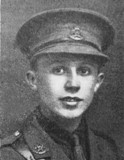
William John Dowdeswell, Private, MS/951, Royal Army Service Corps. William was born at Llanddewi’r Cwm, Builth Wells on 21 April 1877, the son of William Henry Dowdeswell and Mary Ann Dowdeswell (nee Jones). By 1911 the family was residing at 2, Lion Street, Brecon. William trained as a fitter, with his father, before leaving home to join the Royal Navy on 27 October 1899 and served for almost 14 years before leaving on 25 March 1913, by which time he had served on a multitude of different ships. On 10 August 1914 William enlisted at Portsmouth into the Army Service Corps and was posted to Avonmouth for training. He appears to have been a colourful character both during his service with the Royal Navy and with the Army Service Corps, as there are multiple offences recorded in his records, but nothing more serious than drinking, which resulted in several instances of being AWOL. On 30 September 1915 William was drafted to France, where he served until 4 November 1917 when he was posted back to Britain as a result of ill-health. On 18 May 1918 William was discharged from the army at Larkhill, after being diagnosed as suffering from chronic bronchitis, which had been contracted in France, and was posted to a discharge camp at Ripon. He then worked in a shipbuilding yard at Newcastle Upon Tyne before returning to Wales after gaining work at the Mond Nickel Works at Clydach, in the Swansea valley. William’s health had by now began to trouble him quite severely and he died of pneumonia at Clydach on 6 March 1919. The 40-year-old was buried in St John the Baptist Churchyard, Clydach-on-Tawe. William is not commemorated at Brecon.
Bertie Eldred, Private, 48757, South Lancashire Regiment. Bertie was born on 29 May 1886, the son of George Eldred and Elwina Waterloo Eldred (nee Price), of 2, John Street, The Watton, Brecon. He worked as a labourer prior to enlisting into the army and was posted to the Prince of Wales’s South Lancashire Regiment. Bertie does not appear to have served overseas during the war, as he was diagnosed as suffering from tuberculosis and was discharged from the army. Bertie’s health continued to wane after being discharged and he died of tuberculosis at Brecon on 6 May 1920. The 33-year-old was buried in Brecon Cemetery. His brother-in-law, Samuel Robert Nesbitt, the husband of his sister Lilian Rose, died at Brecon on 15 January 1921. Bertie is not commemorated on the Brecon war memorial.
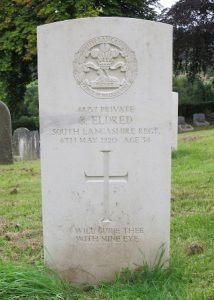
William Burt Elston, Company Quartermaster Sergeant, 230006, King’s Shropshire Light Infantry. William was born in Birmingham on 20 June 1884, the son of William Burt Elston and Mary Elizabeth Elston (nee Pearsall). The family had moved to 45, High Street, Brecon by 1891, where William’s father ran his own butchers shop. William was educated at Pendre School and at Brecon County School but followed his father into the business and ran the shop along with his mother after his fathers death in 1900. William was a member of the Shropshire Yeomanry for many years prior to the war. The Shropshire Yeomanry mobilised at Shrewsbury on 4 August 1915, attached to the Welsh Border Mounted Brigade, before moving to Oswestry. The brigade then joined the 1st Mounted Division in East Anglia. In November 1915 the regiment dismounted and on 4 March 1916 embarked at Devonport aboard the SS Arcadian, bound for Egypt. Upon its arrival in Alexandria, the Welsh Border Mounted Brigade was absorbed in the 4th Dismounted Brigade, in the Western Frontier Force and began operations guarding the Suez Canal. On 2 March 1917 the Shropshire Yeomanry merged with the Cheshire Yeomanry to form the 10th (Shropshire and Cheshire Yeomanry) Battalion, King’s Shropshire Light Infantry, joining 231 Brigade, 74th (Yeomanry) Division. The Division assembled in Egypt as part of the EEF, before crossing the Suez Canal into the Sinai, and saw its first major action during the Second Battle of Gaza. The battle was a failure, and the EEF was re-organised under a new commander, Sir Edmund Allenby, before launching the Third Battle of Gaza on the night of 31 October 1917. This assault was launched along a winder front, running from Gaza to Beersheba, and this time the EEF prevailed, opening the door to Jerusalem. William was wounded during the advance to the Sheria Heights and died of his wounds on 6 November 1917. The 33-year-old was buried in Beersheba War Cemetery, Palestine.
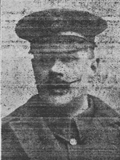
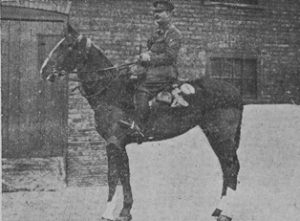
Alfred Edward Evans, Private, 9997, Somerset Light Infantry. Alfred was born on 30 July 1890, the son of Charles Evans and Jane Evans, of 4, Market Street, Brecon. He served his apprenticeship as a draper with Messrs. Thomas and Adcock, before going to work at Reynolds Department Store, at Newport. Alfred lodged at 44, Llanwern Street, Newport prior to enlisting into the 6th Battalion, Somerset Light Infantry at Newport. The battalion formed at Taunton in August 1914, moving to Aldershot to join 43 Brigade, 14th (Light) Division. The battalion landed in France on 21 May 1915 and moved to the Ypres Salient with the division. The Division was to see its first action during the Action of Hooge, where the Division infamously became the first to be attacked by the German use of flamethrowers on 30 July 1915. It then fought at the Second attack on Bellewaarde on 25 September 1915, a diversionary attack aimed at drawing German attention away from the main offensive at Loos. Alfred appears to have suffered from gas inhalation around this time, as on 19 April 1916 he was discharged as medically unfit, being diagnosed as suffering from phthisis. He returned home to Brecon and upon his recovery went to live at Cheltenham after gaining a position as a draper at Cavendish House, Cheltenham. Alfred’s health had been damaged by his phthisis and he took ill in October 1918, returning home again. He died at Brecon of influenza on 30 October 1918. The 28-year-old was buried in Brecon Cemetery.
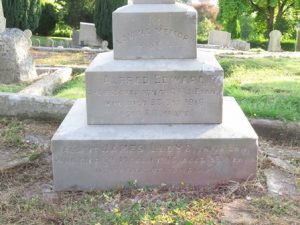
Frederick Evans, Private, 267451, Monmouthshire Regiment. Frederick was born on 14 December 1877, the son of Thomas Evans and Elizabeth Evans, of 36, Church Street, Llanfaes, Brecon. He worked as a labourer prior to the war. Frederick enlisted at Brecon into the Monmouthshire Regiment and after completing his training was drafted to France, joining the 2nd Battalion, Monmouthshire Regiment, which was the Pioneer Battalion to the 29th Division. Soon after joining the battalion, Frederick was attached to the 182nd Tunnelling Company, Royal Engineers, which was at work in the Vimy Ridge sector. Frederick was then posted back to the 2nd Monmouth’s, before being transferred again, this time to the 1st Monmouth’s, which was the Pioneer Battalion to the 46th (North Midland) Division. Both the 2nd Monmouth’s and the 1st Monmouth’s had been involved in the Somme offensive with their respective divisions in the summer of 1916. Frederick probably joined the 1st Monmouth’s by the time that the 46th Division had followed the German Retreat to the Hindenburg Line in March 1917 and on the following month fought in the Battle of Arras, taking part in the Battle of Hill 70. The Division remained in this part of Flanders over the summer, near Sailly Labourse. Frederick was wounded here during a working party during the first days of October and was evacuated to hospital in Bethune, where he died of his wounds on 5 October 1917. The 40-year-old is buried in Bethune Town Cemetery, France.
Wilfred Easthope Evans, Private, 235394, Royal Welsh Fusiliers. Wilfred was born at Cleobury Mortimer in 1899, the son of Arthur John Johnson Evans and Emma Barrett Evans (nee Coates). The family had moved to The Common, Cathedine, Bwlch by 1911. By the time war broke out, the family was residing at 14, Struet, Brecon. Wilfred enlisted in Brecon into the Brecknockshire Battalion, South Wales Borderers on 19 October 1914 and was posted to Pembroke Dock to join the 2/1st Battalion. The battalion was stationed at Pembroke Dock and Dale until April 1915 when it moved to Bedford to join the 68th (2nd Welsh) Division. Wilfred embarked for France at Southampton on 16 June 1917 and disembarked at Rouen, where he was transferred to the 4th (Reserve) Battalion, Royal Welsh Fusiliers. On 8 July 1917 Wilfred was posted to Ypres, joining the 14th Battalion, Royal Welsh Fusiliers, which was attached to 113 Brigade, 38th (Welsh) Division and was holding the Boesinghe sector. Wilfred was wounded by gas shell whilst the 14th RWF was in the front line at Boesinghe on 23 July, preparing for the forthcoming assault on Pilckem Ridge, and was evacuated via the 131st Field Ambulance to the 12th Casualty Clearing Station. He was then transferred to the 2nd Canadian General Hospital, where he received further treatment. Upon his recovery he was sent back to Étaples, before being posted back to the 14th Battalion, Royal Welsh Fusiliers on 27 August, by which time the 38th (Welsh) Division had seized Pilckem Ridge and was assisting in the further assault on Langemarck. Wilfred was killed near Iron Cross whilst the 14th RWF was carrying out salvaging work on 2 September 1917. The 17-year-old has no known grave and is commemorated on the Tyne Cot Memorial, Belgium. His brother Percy had been killed during the early months of the war.
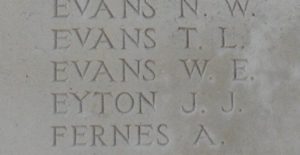
William Evans, Private, 12008, South Wales Borderers. William was the son of William and Mary Evans, of 13, Silver Street, Llanfaes. He married Winifred Price, of 13, The Struet, Brecon on 31 August 1911. William worked as a bicycle mechanic and blacksmith prior to the war. William enlisted at Brecon into the South Wales Borderers soon after the outbreak of war. He was drafted to France at some time in 1916, joining the 1st Battalion, South Wales Borderers, which was attached to 3 Brigade, 1st Division, and possibly saw action with the battalion during the Somme offensive later that year. William came home on leave early in 1917 and upon his return was attached to the 2nd Australian Tunnelling Company, which was working on dugouts in the Nieuport Bains area, in preparation for Operation Hush, a Top Secret offensive which had been planned along the Flanders coast, if the Passchendaele offensive made a breakthrough. (This ultimately did not happen, and Operation Hush was called off). The 2nd Australian Tunnelling Company was at work on the extreme edge of the Western Front, near to the coast, and 200 yards from the River Yser. On 10 July 1917 a large number of men of the Company were working in deep dugouts when the Germans attacked and over-ran their positions, trapping them behind enemy lines. A fierce fight broke out, with the Germans lobbing grenades into the dugouts and heavy casualties were suffered, with some 170 men posted as missing immediately after the incident. William was later declared to have been killed in action during the previous day, 9 July 1917. The 38-year-old has no known grave and is commemorated on the Nieuport Memorial, West Vlaanderen, Belgium.
William Evans, Private, 98927, Northumberland Fusiliers. William was born at Bassaleg in about 1871. He had enlisted into the South Wales Borderers as a young man, and served for many years with the regiment. He married Emma Louise Gillard in 1908 and by 1911 the family was residing at Chatham Barracks, where their son John Francis Evans was born. The family had moved to 11, Charles Street, Brecon prior to the war. William served throughout the war with the South Wales Borderers, and volunteered to remain in the army after the Armistice, transferring to the 40th Battalion, Northumberland Fusiliers. He was stationed near Ypres after the war, and died there following a heart attack on 18 May 1920. The 49-year-old was buried in Lijssenthoek Military Cemetery, Belgium. William is not commemorated on the Brecon war memorial, although his son, John Francis Evans, who was killed in 1944, is.
Harry William Finch, Private, 9095, South Wales Borderers. Harry was born at Bermondsey, London on 18 March 1888, the son of Henry Finch and Margaret Bertha Finch (née Jackson). Harry enlisted into the 5th Battalion, The Rifle Brigade in 1905 and on the following year transferred to the 4th (Volunteer) Battalion, South Wales Borderers. Harry married Amy Esther Church in Southwark on 9 August 1909 and soon afterwards the couple moved to Brecon, following Harry’s posting to the Depot. Their first daughter, Amy Bertha Myfanwy Finch was born there at John Street on 28 November 1910, whilst their second daughter, Millicent Iris Finch, was born there in 1916. Harry spent the early months of the war training recruits in Brecon, before sailing for Mesopotamia in April 1916 to join the 4th Battalion, South Wales Borderers, which was attached to 40 Brigade, 13th (Western) Division. The division had been moved to Mesopotamia from Egypt, following an arduous campaign at Gallipoli, in February 1916, to join the forces being assembled to attempt to relieve the besieged garrison of Kut-al-Amara. Harry was a capable boxer, and took part in an army boxing tournament in Mesopotamia in August 1916, losing on points in the middleweight final to another Brecon man, Sergeant Major Hoddinott. The campaign in Mesopotamia was a difficult one, with the British losing as many men to sickness as to battle wounds, yet there was a hard campaign against a stubborn enemy over the coming months. Harry was posted as missing during an engagement against the Turks on 30 April 1917. He died of dysentery in captivity at Ras al-Ain on 31 December 1917. The 30-year-old is buried in Baghdad (North Gate) Cemetery, Iraq.
James Flaherty, Private, 60450, South Wales Borderers. James was born in Wigan in 1899, the son of James Flaherty and Norah Flaherty (nee King), who were Irish immigrants. His father had died by 1911 and James was living with his mother, Norah, at 59, Bower Street, Wigan, where he was still in school. James enlisted into the army as soon as he turned 18 and joined the 53rd Training Reserve Battalion, which was affiliated to the South Wales Borderers. He was posted to Brecon Barracks, where he became attached to the 569th Agricultural Company, Labour Corps, with the service number 588387. James must have been deemed to have been unfit for infantry service to have received this posting, as the situation on the Western Front was dire, with the army desperately short of troops. He became ill during the time of the Armistice and died of pneumonia at Brecon Military Hospital on 21 November 1918. The 19-year-old was buried in Brecon Cemetery. Probate was granted to his mother, Norah, who by then was residing at 24, Thompson Street, Blackburn. James is not commemorated on the Brecon war memorial.
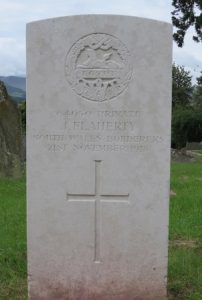
Michael Fury, Lance Corporal, 10358, South Wales Borderers. Michael was born in 1891, the son of Michael Fury and Mary Fury (nee MacDonough), of The Struet, Brecon. His mother died in 1895 and his father remarried to Emily Jane Probert in 1901, but himself died in 1902. Michael then left home to work as a pit boy at Merthyr Tydfil, but as soon as he was old enough, he enlisted at Brecon into the 2nd Battalion, South Wales Borderers. By 1911 Michael was stationed at Fort Pitt, Kent with the battalion, but prior to the outbreak of war the battalion was stationed at Tientsin, China. The battalion took part in a famous operation with the Japanese against the German held port of Tsingtao on 23 September, capturing the port. On 4 December the battalion embarked at Hong Kong and landed at Plymouth on 12 January 1915, entraining for Rugby to join 87 Brigade, 29th Division. On 17 March 1915 the battalion sailed from Avonmouth with the Division, arriving at Alexandria on 29 March, before moving to Mudros. On 25 April 1915 the Division landed at Cape Helles, Gallipoli, as part of the original landing force which had been despatched to try and seize the Dardanelles Straits and force Turkey out of the war. The invasion forces failed to break the Turkish defences and the campaign became bogged down. Michael was wounded whilst the battalion was holding the line in Turkey Trench at the beginning of July and was evacuated aboard the Hospital Ship Dungala, where he died of his wounds on 11 July 1915. The 24-year-old was buried at sea, so is commemorated on the Helles Memorial, Gallipoli. Michael is not commemorated on the Brecon war memorial.
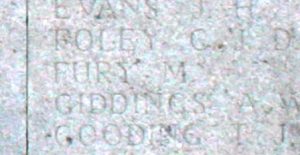
Richard Davies Garnons Williams, Lieutenant-Colonel, Royal Fusiliers (City of London Regiment). Richard was born at Llowes, Radnorshire on 15 June 1856, the son of Reverend Garnons Williams and Catherine Francis Williams (nee Hort). His father later became Vicar of St. John’s, Brecon. Richard was educated at Magdalen College School, Oxford and at Trinity College, Cambridge. Richard became known as a talented rugby player and upon leaving Cambridge, was accepted into the Royal Military Academy at Sandhurst, where he played rugby for the Sandhurst Rugby Team. Richard completed his officer training in 1876 and was commissioned as a sub-lieutenant into the 38th Regiment of Foot, before transferring to the 7th Regiment of Foot the following year. He continued to play rugby and during his first years in the army played for Brecon and for Newport RFC, where he became selected for Wales for its first ever rugby international against England in 1881. Richard married Alice Jessie Bircham at Chelsea on 8 January 1885, and the couple had one child, a daughter, Barbara, who later married Captain Hume Buckley Roderick of the Welsh Guards. By February 1885 Richard had been promoted to captain, and his unit had been renamed the Royal Fusiliers (City of London Regiment). Upon retiring from the army on 4 May 1892, Richard was commissioned as major in the 1st (Brecknockshire) Volunteer Battalion, South Wales Borderers, before being appointed Brigade Major for the South Wales Brigade of the Volunteer Force and became a well-known figure in Brecon. By the time that Richard resigned his commission in 1906 he had been promoted to Lieutenant-Colonel. He re-joined the Army shortly after the outbreak of war and re-joined his original regiment after being posted to the 12th Battalion, Royal Fusiliers. He was then given temporary command of the Brecknock Battalion, South Wales Borderers for a while, before assuming command of the 12th Battalion, Royal Fusiliers. He joined the battalion at Pirbright, where it was attached to 73 Brigade, 24th Division, and on 1 September 1915 took his battalion to France. The battalion disembarked at Boulogne on the following day, before entraining for Montreuil and the men then marched to billets at Embry. Over the coming days the battalion trained and carried out practise attacks, as the 24th Division had received orders to move to the Loos sector. On 25 September the British launched a large-scale assault upon the German defences around the town of Loos, but suffered terrible casualties in doing so. As a result the inexperienced 24th Division was thrown into the fight, and moved to Vermelles later that day. The division moved into position that night and on the following morning, 26 September 1915, launched an assault on the German lines north-east of Vermelles. Richard was posted as wounded and missing during the early stages of the attack. It appears that he had been shot in the head and killed whilst trying to withdraw his men. No trace of the 59-year-old was ever found, so he is commemorated on the Loos Memorial, France. Richard was the eldest of thirteen former Welsh international rugby players to be killed during the war. He is not commemorated on the Brecon war memorial, but at nearby Hay-on-Wye. His son-in-law, Hume Buckley Roderick, was also killed during the war.
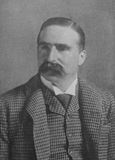
Harold John Gibble, Lance Corporal, A/201705, King’s Royal Rifle Corps. Harold was born at Talgarth in 1898, the son of John William Gibble and Minnie Gibble (nee Freebury). His mother died in 1901 and his father remarried to Harriet Agnes Morgan on 20 September 1902, before the family moved to Elms Cottage, 11, The Struet, Brecon by 1911. After leaving school, Harold found work at the printing works of the Brecon and Radnor Express. He enlisted into the King’s Royal Rifle Corps at Canning Town, London soon after the outbreak of war. Upon completing his training, Harold was drafted to France, joining the 10th Battalion, King’s Royal Rifle Corps, which was attached to 59 Brigade, 20th (Light) Division. Harold probably joined the battalion in France after the 20th Division had taken part in the terrible fighting for Mount Sorrel in June 1916. The division then moved south and fought through the Somme Offensive, at the Battles of Delville Wood, Guillemont, Flers-Courcelette, Morval and Le Transloy, before wintering on the Somme and took part in the advance to the Hindenburg Line in March 1917. Later that year the division moved to the Ypres Salient, taking over positions in support of the 38th (Welsh) Division for their opening assault on Pilckem Ridge on 31 July 1917. The 10th KRRC, based at Canada Farm, was put to work clearing debris on the local roads and tracks as the battle raged in front of them, then on 7 August moved into the old front line positions on the Canal Bank, before relieving the battered 38th Division. On 11 August the 10th KRRC took part in an attack against the German lines on the Steenbeek in front of Langemarck, suffering heavy casualties whilst attempting to attack through thick mud. Harold was among 85 men posted as missing during the attack that day. He was later found to have been wounded and taken prisoner by the Germans, and died of his wounds in a German Hospital at Harlebeke on 14 August 1917. The 18-year-old is buried in Harlebeke New British Cemetery, Belgium.
Franklin Macaulay Gillespie, Lieutenant-Colonel, South Wales Borderers. Franklin was born at Colchester on 19 August 1872, the son of Lieutenant Colonel Franklin Gillespie and Mrs Harriet Eliza Phillis Gillespie (nee Freeth). He was educated at Dover College and at Sandhurst before being commissioned as Second Lieutenant into the South Wales Borderers on 25 July 1891. Over the coming years Franklin rose through the ranks, seeing active service with the West African Frontier Force and in Niger, before fighting in the Boer War. Upon his return from South Africa, he became Adjutant of the 5th Volunteer Battalion, South Wales Borderers at Newtown. He married Agnes Rose Pryce-Jones, the daughter of Sir Pryce Pryce-Jones, of Newtown, at Newtown on 27 July 1905 and in July 1908 he was posted to the 2nd Battalion, South Wales Borderers at Aldershot, embarking for South Africa again with the battalion soon afterwards. Franklin was transferred to the 1st Battalion, South Wales Borderers at Chatham, before being appointed to the Command of the Regimental Depot at Brecon. Following the outbreak of war he gained command of the newly raised 4th Battalion, South Wales Borderers. The battalion formed at Brecon before moving to Park House Camp, near Tidworth to join 40 Brigade, 13th (Western) Division. The Division embarked at Avonmouth on 29 June 1915 and sailed for Gallipoli, arriving at Mudros on 12 July before landing on the shores of Gallipoli on 15 July. He gallantly led the battalion’s assault on Sari Bair on 6 August but was killed in action during the Turkish counterattack on 9 August 1915. The 42-year-old was buried in the 39th Field Ambulance Cemetery, however his grave was subsequently lost, and he is now commemorated on the Helles Memorial, Gallipoli. Franklin was posthumously mentioned in despatches.
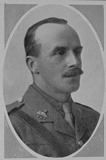
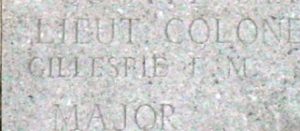
Ernest Green, Private, 2308, South Wales Borderers. Ernest was born on 14 January 1887, the son of Joseph Green and Mary Ann Green (nee Silk), of 77, The Watton, Brecon. His father was from Birmingham and had come to Brecon as a quartermaster with the 24th Regiment. Ernest worked as a painter and decorator prior to the war and was a well known local footballer. Ernest enlisted at Brecon into the Brecknockshire Battalion, South Wales Borderers. The battalion was attached to the Welsh Division and moved to Pembroke Dock upon mobilisation. It was then withdrawn from the Division and on 29 October 1914 sailed from Southampton for Bombay, where the battalion transhipped and sailed for Aden, arriving on 16 December 1914. The climate in Aden was fearsome, with scorching heat during the day, and with little to do, the men spent much of their free time playing football. By June 1915 the Turks had become overconfident due to the lack of any incursions by the British into Yemen and moved forward to reoccupy fortifications at Sheikh Saad. They then began to shell the island of Perim, so the Allied troops in Aden were mobilised into the Aden Movable Company and ordered to prepare to join with local troops. 400 men of the Brecknocks were allocated to the column, the remainder stayed in Aden. A small artillery column was built up to join it and on 3 July the force moved out to Sheikh Othman. Many men collapsed on the march, which was carried out during the full heat of the day, but by 7.30 pm the column had completed its six mile advance. Ernest was among thirteen men who died of heatstroke during the following day, 4 July 1915, during an even longer march. The 28-year-old has no known grave and is commemorated on the Heliopolis (Aden) Memorial, Egypt.
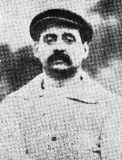
Joseph Groom, DCM, Colour Sergeant, 9865, Kings Shropshire Light Infantry. Joseph was born in Norbury, Cheshire, in 1895, the son of Charles Groom and Mary Ann Groom (nee Povah). His father died in 1900, so Joseph and a sister, Nellie, went to live with Thomas and Mary Hopley, at Marbury. By 1911, Joseph was working as a groom at Bickley Hall in Cheshire. He enlisted into the King’s Shropshire Light Infantry as soon as he turned sixteen and was posted to Tipperary with the 1st Battalion, King’s Shropshire Light Infantry. The battalion was attached to 16 Brigade, 6th Division and at the outbreak of war returned to England, before landing at St. Nazaire on 10 September 1914. The division then reinforced the hard-pressed BEF on the Aisne, before the whole army was moved north into Flanders. The 6th Division took over a section of the newly formed Western Front at Bois Grenier, where it remained until the New Year when it moved to the Armentieres sector, then at the beginning of June 1915 moved into the Ypres Salient, taking over the line at Potijze. The division then took part in the terrible fighting of the Action of Hooge later that month, following the German flammenwerfer attack. Joseph gained the award of the Distinguished Conduct Medal for a later action at Hooge: ‘For conspicuous gallantry on the 9th August 1915, during the attack on the Hooge trenches, when he was ordered to reinforce the captured trenches with a machine gun. In the advance he came under heavy shell fire, the gun was damaged and several of the gun team wounded. Although wounded himself, he bound up his comrades’ wounds, returned to headquarters and reported, and successfully took another gun and team to the firing line.’ Joseph was invalided home and took up a position as a staff sergeant with the 3rd KSLI at Pembroke Dock, where he met a young nurse, Edith Mabel Smith-DeLonra, of Brecon and the couple married in March 1917. Joseph then volunteered to serve in German East Africa in April 1917, where he was wounded again and promoted to Colour Sergeant, then came home on leave in April 1918 before going out to Africa again. Joseph returned home in February 1919, and took his wife to Welshpool for a belated honeymoon. Sadly he took ill there and died of blackwater fever at The Buck Inn at Welshpool on 7 April 1919. The body of the 25-year-old was brought back to Brecon and he was buried with full military honours in Brecon Cemetery.
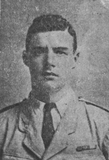
Albert George Halford, Regimental Sergeant Major, 13852, South Wales Borderers. Albert, known as George, was born in Monaghan, Ireland on 6 December 1871, the son of James Halford and Sarah Jane Halford (nee Moran). He enlisted into the 24th Regiment of Foot, South Wales Borderers, at Brecon on 24 September 1888 and served continuously with the regiment over the coming years, serving in Gibraltar, India and during the Boer War. Upon his return to England, he took up the position of Sergeant-Instructor at Brecon, where he played for the town football team. George married Elizabeth Norah Llewellyn, of Brecon, in London in 1904 and the couple had three children. George then transferred to the 7th Battalion, Royal Welsh Fusiliers at Newtown upon the formation of the Territorial Force on 1 April 1908 and became sergeant-instructor in the town. On 31 March 1914 George relinquished his position at Newtown, intending to retire, but when war erupted in August 1914 he re-joined his old regiment, and was posted to the 4th Battalion, South Wales Borderers. The battalion was formed at Brecon in August 1914, moving to Park House Camp, near Tidworth to join 40 Brigade, 13th (Western) Division. On 29 June 1915 the Division sailed from Avonmouth for Mudros, then on 15 July landed at Cape Helles, Gallipoli, relieving the 29th Division. After spending two weeks in the line at Helles, the Division was evacuated and returned to Mudros, before being landed at ANZAC Cove between 3 and 5 August 1915, to join up with the Anzac’s, with orders to take part in a diversionary offensive, to divert Turkish attention away from further landings at Suvla. George was wounded during the capture of Damakjelik Bair on 6 August and was evacuated by Hospital Ship to Alexandria. He died of his wounds there on 12 August 1915. The 43-year-old is buried in Alexandria (Chatby) Military & War Memorial Cemetery, Egypt. George is not commemorated on the Brecon war memorial, but is commemorated at Newtown, Montgomeryshire.
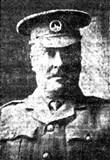
Albert Lewis Harding, Lance Corporal, 22867, Oxford and Bucks Light Infantry. Albert was born on 27 May 1886, the son of John Harding and Mary Anne Harding (nee Thresby), of 46a, Free Street, Brecon. His father had come to Brecon whilst working as a railway foreman and porter for the Midland Railway. Albert followed in his father’s footsteps, finding work as a clerk for the Midland Railway at Brecon, before taking up a position with the company in Leicester in 1907 and then at Bourneville by 1909. Albert enlisted at Birmingham into the 3rd Battalion, Oxfordshire and Buckinghamshire Light Infantry soon after the outbreak of war. Albert was then posted to the 7th Battalion, Oxfordshire and Buckinghamshire Light Infantry, which was in Salonika attached to 78 Brigade, 26th Division. The division was among a number of British and French units sent out to aid their Greek allies, following the invasion of neighbouring Serbia by a combined Austrian and Bulgarian offensive in 1915, and had taken up positions near Doiran. The first large-scale battle was fought there between 10 and 18 August 1916, during the Battle of Horseshoe Hill. The normal routines of trench warfare then ensued before the next large scale battle, the Battle of Doiran, was fought between 24-25 April. Albert was posted as missing during the fighting on 25 April 1917, and was later deemed to have been killed in action on that date. The 29-year-old has no known grave and is commemorated on the Doiran Memorial, Greece.
Eustace William Hardinge, Private, 267467, Monmouthshire Regiment. Eustace was born in Bath in 1897, the son of William George Hardinge and Rose Hardinge (nee Burchell). The family moved to Cardiff by 1901, but Eustace went to live with his grandmother, Mary Jane Hardinge, at 75, Lawn Road, Bristol. Eustace was lodging with Jane Campion at 4, Harp Terrace, Brecon by 1911, and was in school in the town. Eustace was working as a dental mechanic at Brecon when war broke out and enlisted at Brecon into the Brecknockshire Battalion, South Wales Borderers on 2 September 1914. He was posted to the 2/1st Brecknock’s, which was a reserve battalion, raised at Brecon in September 1914. In April 1915 the battalion moved to Dale, on the Milford Haven defences, then at the end of the year joined the 68th (2nd Welsh) Division at Bedford. On 30 July 1916 Eustace embarked for France, joining the Infantry Base Depot at Rouen before being posted to the 2nd Battalion, Monmouthshire Regiment. The battalion was by then the Pioneer Battalion to the 29th Division, which had just moved to Ypres following heavy losses on the Somme. Eustace took ill soon after arriving in France though, spending the coming weeks in hospital at Boulogne and Le Havre and by the time he re-joined the 2nd Monmouth’s on 5 September, the battalion was at work at Brandhoek. The Division held the line here over the coming weeks as it rebuilt its strength and the 2nd Monmouth’s worked hard on improving trenches and digging new communications trenches. The battalion then worked on the Menin Road, erecting elephant shelters, then on 4 October the Division was relieved and entrained south for the Somme once more, moving to Trônes Wood, before joining the latter stages of the Somme offensive. The Division wintered on the Somme, with the 2nd Monmouth’s working on road repairs around Montauban, then at Ginchy, Flers and Morval. The 2nd Monmouth’s moved into reserve at the end of December and moved to Fourdrinoy, where the men trained in infantry assault manoeuvres. On 12 January 1917 the battalion began marching back into the battle area, taking over positions near Morval, and began supplying working parties around Montauban once more. The Division then received orders to mount an attack, so at dawn on 27 January 1917 the 2nd Monmouth’s began work on two new communication trenches to connect the old front line to the new objectives. The division moved to the Arras sector in March and in the following month took part in a costly assault on the German positions around Monchy-le-Preux, during the Battle of Arras. At the end of May 1917 Eustace was hospitalised again for two weeks and re-joined the 2nd Monmouth’s at Le Meillard on 15 June. Towards the end of the month the division moved back to Ypres to relieve the 38th (Welsh) Division, which moved out of the line to begin training for the forthcoming assault on Pilckem Ridge. Eustace was killed in action here during a working party in the front line along the Yser Canal bank on 1 July 1917. The 29-year-old is buried in Bard Cottage Cemetery, Belgium. His landlady, Jane Campion’s, son, Charles Guest Campion, was also killed during the war.
Cyril John Hardwick, Ordinary Signalman, J/36512, Royal Navy. Cyril was born at Brecon on 25 December 1897, the son of Thomas John Hardwick and Rose Hardwick (nee Miffling). His father worked for the Midland Railway, so the family had moved to 32, Hargreaves Street, Colne by 1901, but maintained very close ties with their large family in Brecon over the coming years. Cyril followed his father into the Midland Railways and worked as a boy porter before enlisting into the Royal Navy on 25 December 1915 and was posted to HMS Vivid I at Devonport for training. He then spent a short while aboard HMS Ganges before being posted to join the crew of the Battlecruiser HMS Indefatigable, which was attached to the 2nd Battle Cruiser Squadron and was moored in Edinburgh. The 2nd Battle Cruiser Squadron was commanded by Rear Admiral Packenham and was part of Sir David Beatty’s Battlecruiser Fleet. The Fleet put to sea on 31 May 1916 following intelligence reports of the German High Seas Fleet being in the North Sea and steamed at full speed to engage the Germans in the North Sea off Jutland. The two forces met at around 15.30 and Beatty turned his fleet to the south, to gain time before the main Grand Fleet, commanded by Sir John Jellicoe and steaming from Northern Scotland and Scapa Flow, could enter the fight. At 15.48 the Germans opened fire, followed by the British, and twelve minutes later a salvo of German shells struck HMS Indefatigable, igniting her magazines and blowing the doomed ship apart. Only three of the crew of 1,019 survived. Cyril was 18 years old when he was killed in the sudden explosion that day, and is commemorated on the Portsmouth Naval Memorial, Devon. He is not commemorated on the Brecon war memorial. His uncle, William Emlyn Hardwick, was killed in 1918.
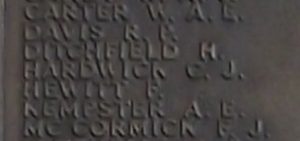
William Emlyn Hardwick, MC & Bar, Lieutenant, Australian Infantry. William was born at Brecon on 12 March 1885, the son of Thomas Hardwick and Mary Hardwick (nee Walters) of Avenue Road, Brecon. He had trained as a carpenter and was a member of the Brecon Church Lads’ Brigade prior to migrating to Australia aboard the SS Ortona on 16 November 1906. William easily found work and settled well into his new life over the coming years. He enlisted on 7 January 1915 into the 21st Battalion AIF, and embarked from Melbourne, Victoria, on board HMAT Ulysses on 10 May 1915. William served in Gallipoli as a Sergeant, and was mentioned in despatches: ‘For his courage and untiring energy during the last day of the withdrawal. By his devotion to duty he set a splendid example to the members of his battalion and was of great assistance during the final withdrawal.’ He then served in France with his battalion before being sent to an Officer Training battalion in Ayrshire and was commissioned on 25 February 1917, re-joining the 21st Battalion, AIF in France. William was awarded the MC within two months: ‘For conspicuous gallantry and devotion to duty. When his platoon was held up by fire from a mine crater he rushed forward with three men killing two of the enemy and dispersing the remainder. He set a fine example of courage and initiative.’ He was wounded during the action, before returning to England for treatment. He remained there until being posted back to France on 8 August 1918, joining his battalion near Villers-Bretonneux. He then gained the award of a Bar to his MC during an action near Herleville on 18 August: ‘For conspicuous gallantry and devotion to duty. When the flank of an advance was seriously hampered by machine gun fire, he led forward a party, drove the enemy from their position, captured a machine gun and six prisoners, and established a post on the captured ground under heavy fire. He showed great courage and skill.’ The Australians attacked and captured Montbrehain on 5 October in what was their last action of the war. Their strength had been severely depleted since the launching of the offensive on 8 August and they moved out of the line for a well-deserved rest after being relieved by the Americans. William was in the process of handing over his position to the relieving Americans on 5 October 1918 when he was killed. The 33-year-old was originally buried by the Germans in Ramicourt Communal Cemetery Extension, but in 1920 his grave was exhumed and he was re-interred in Tincourt New British Cemetery, France. His nephew, Cyril John Hardwick, was killed at sea in 1916.
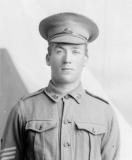
Philip Hargest, Private, 240, Lancashire Fusiliers. Philip was born on 23 June 1885, the son of Evan Thomas Hargest and Margaret Hargest (nee Williams), of 11, St. David Street, Llanfaes, Brecon. His father died in 1891, but Philip still followed in his footsteps, becoming a mason, as were some of his brothers. Philip enlisted at Pontypool into the Lancashire Fusiliers some years prior to the war and was posted to the 2nd Battalion, Lancashire Fusiliers. The battalion was at Dover when war broke out, attached to 12 Brigade, 4th Division, and embarked for France, landing at Boulogne on 20 August 1914, before rushing to reinforce the BEF and detrained at Bartry on 24 August. By now the BEF had lost the Battle of Mons and had begun to withdraw south, skirting the Forest of Mormal. The 4th Division reached the town of Ligny during the afternoon of 24 August and on the following day marched to Viesly under shellfire. During the night of 25 August the 2nd Lancashire Fusiliers marched to positions between Caudry and Ligny, near Le Cateau, and began to dig in. As dawn broke on 26 August 1914 the battalion came under heavy shellfire and after three hellish hours was forced to evacuate its battered positions and withdraw towards Haucourt. Philip was killed in action at some time during that morning. The 29-year-old has no known grave and is commemorated on the La Ferté-Sous-Jouarre Memorial, France.
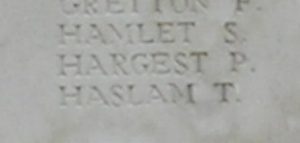
Leonard Augustus Hedge, Lance Corporal, 2471, Montgomeryshire Yeomanry. Leonard was born at Shelton, Stoke-on-Trent on 14 June 1888, the son of Charles Edward Hedge and Mary Ann Hedge (nee Mugliston). His father was a successful brewer, so Leonard was sent to be educated at Dean Close School, at Cheltenham. Upon leaving school he joined the staff of the United Counties Bank, first at Uttoxeter, and then at Brecon, after gaining the position of senior bank clerk. Leonard threw himself into his new life at Brecon and became well known as a sportsman, playing cricket, snooker and billiards and had gallantly attempted to rescue a man from drowning at Brecon. As soon as war broke out, he enlisted at Welshpool into the Montgomeryshire Yeomanry, and being a keen motorcyclist, was attached to the motorcycle section. On 16 June 1915 Leonard was riding his motorcycle from the direction of Pant up a steep hill in the border village of Llanymynech and over a canal bridge, when he crashed into a horse and cart and was seriously injured. The 27-year-old died at the scene. He was buried with full military honours in Christ Church Churchyard, Welshpool.
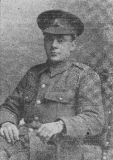
William Mostyn Hellard, Private, 58071, Welsh Regiment. William was born on 13 September 1898, the son of John Naish Hellard and Sarah Annie Hellard (nee Jones), of The Cock and Horse Inn, The Watton, Brecon. He worked as a timer haulier prior to enlisting into the 53rd (Young Soldiers) Battalion, Welsh Regiment at Brecon on 9 October 1917. William was drafted to France in July 1918 and was posted to the 9th Battalion, Welsh Regiment. The battalion was attached to 58 Brigade, 19th (Western) Division and was in the process of rebuilding at Ledingham following terrible losses during the three separate phases of the German Spring offensives of 1918. By 6 August 1918 the 9th Welsh was deemed as strong enough to go back into the line, so took up positions at Hinges, along the divisions front. Whilst this sector of the Western Front was relatively quiet, to the south the Allies launched their great offensive on 21 August 1918 and began to drive the Germans back towards the Hindenburg Line. The 19th Division then moved out of the line to train before moving back to positions near Le Touret. William was killed in action during a routine spell in the front line here on 29 September 1918. The 18-year-old was originally buried in Edward Road No. 4 Cemetery, near Factory Trench, but in February 1925 the cemetery was cleared and William was re-interred in Cabaret-Rouge British Cemetery, Souchez, France.
Bertie John Hodson, Lieutenant, Royal Irish Rifles. Bertie was born in Cardiff in July 1882, the son of George Marshall Hodson and Ellen Hodson (nee Gregory). He became a journalist for prior to enlisting into the Pembroke Yeomanry at Tenby on 12 February 1900 and served in South Africa during the Boer War with the Imperial Yeomanry. Upon his return from South Africa, Bertie took up a position as journalist for the Brecon County Times and lodged in the town for several years. Bertie married Anna Margarethe Laura Krapf at Cardiff on 6 December 1909 and soon afterwards the couple moved to Westminster, as Bertie had gained a position as chief reporter with the Central News Agency. Bertie left England for New Zealand to cover the amazing story of Captain Scott’s voyage to the Antarctic in 1910, then following the outbreak of war covered the fighting at Ostend and the siege of Antwerp before sailing to cover the fighting in Serbia and the Balkans as an official war correspondent. He then covered the fighting during the Easter Uprising in Ireland, where he sought a commission as Second Lieutenant into the 5th Battalion, Royal Irish Regiment soon afterwards. Bertie embarked for France soon afterwards and was wounded, returning home for a lengthy spell of treatment. Upon his recovery, he was drafted back out to France and was posted to the 1st Battalion, Royal Irish Rifles. The battalion was a regular army unit which was attached to 25 Brigade, 8th Division, then during the re-organising of the army was transferred to 107 Brigade, 36th (Ulster) Division on 3 February 1918 before taking over a sector of the line near Essigny. The battalion enjoyed a rare rest day on 17 March to celebrate St. Patrick and took part in a football competition together with Divisional sports at Ham. By now it was common knowledge that the Germans were preparing to launch an offensive, so the frivolities were short lived, and Bertie’s battalion went back into the line the following day, to prepare its defences. At 04.30 on the morning of 21 March 1918 the Germans opened an intense artillery barrage along a section of the line running south from Croisilles to La Fère, and behind thick fog launched an infantry attack. Fierce fighting raged throughout the day, before the survivors were withdrawn that night. Unfortunately, Bertie had been killed in action at sometime prior to the withdrawal. The 35-year-old has no known grave and is commemorated on the Pozieres Memorial, France. Bertie is not commemorated on the Brecon war memorial.
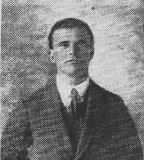
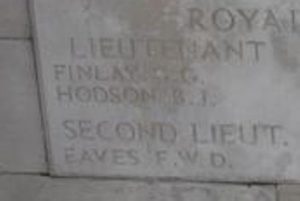
Lewis George Hodson, Private, SE/14518, Royal Army Veterinary Corps. Lewis was born at Boyle, Ireland on 24 October 1872, the son of George Hodson and Margaret Hodson (nee Lewis). His father had served in the army and as a result the family was well travelled, having lived at Gibraltar and Ireland, but following George’s retirement from the army moved to 1, Ffrwdgrech Road, Llanfaes, Brecon. Lewis enlisted into the South Wales Borderers at Brecon on 1 April 1892 and after several years service, including in the Boer War of 1899-1902, left the army, before finding work as a coal miner, first at Ystradgynlais and then at Brynamman. He married Kate Price at Brecon on 4 August 1907 and the couple set up home at Cwmgarw Road, Brynamman. Lewis re-enlisted into the Royal Army Veterinary Corps soon after the outbreak of war. There are no records of his service, but he was gassed on the Western Front at some time during the war and was brought home for treatment before being discharged as medically unfit on 18 August 1916. Lewis sadly died of wounds suffered from his gas poisoning at Brynamman on 11 July 1920. The remains of the 47-year-old were brought to Brecon and he was buried in St. David’s Churchyard, Brecon. His brother, Thomas John Hodson, died on active service in 1916. Lewis is not commemorated on the Brecon war memorial.
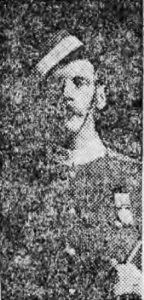
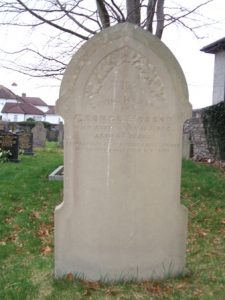
Thomas John Hodson, Sergeant, 8621, South Wales Borderers. Thomas was born in Brecon on 4 September 1885, the son of George Hodson and Margaret Hodson (nee Lewis). His father had served in the army and as a result the family was well travelled, having lived at Gibraltar and Ireland, but following George’s retirement from the army moved to 1, Ffrwdgrech Road, Llanfaes, Brecon. Thomas joined the South Wales Borderers as a young man and by 1911 was based in Brecon Barracks. He married Gwladys Evangeline May Webster at Brecon on 3 November 1912. Thomas left the army soon after his marriage and found work for the Midland Railway at Brynamman. As a Special Reservist, Thomas was called up soon after the outbreak of war and joined the 1st Battalion, South Wales Borderers. The battalion moved to France at the outbreak of war, attached to 3 Brigade, 1st Division. The Division had been one of the first to arrive in France, fighting at the Battle of Mons, and took part in the retreat to the Marne, where the Germans were stopped. The division then fought at the Aisne, and during the famous action at Chivy Ridge, before the BEF was moved north to Flanders, to hold the vital Belgian city of Ypres. Thomas never reached Ypres, as he was shot in the chest on 23 September, during the Battle of the Aisne, the bullet piercing his lung. He was taken prisoner by the Germans, but somehow managed to escape and eventually reached England for hospital treatment at Lincoln. Upon his release from hospital he was discharged as medically unfit on 2 April 1916 and returned home to Brecon. Thomas soon gained a position working for the Royal Mail at Twickenham, but became ill soon afterwards, due to his previous wounds, and died of tuberculosis at 73, Godstone Road, Twickenham on 4 July 1916. The remains of the 30-year-old were brought back to Brecon by rail and he was buried with full military honours in St. David’s Churchyard, Brecon on 8 July. His brother, Lewis George Hodson, died of sickness contracted on active service in 1920, while his brother-in-law, Douglas Gordon Webster, was killed in France in 1918.
Richard William Hooper, Corporal, 5951, South Wales Borderers. Richard was born in Awre, Forest of Dean on 30 September 1880, the son of Mary Ann Hall. His mother married his father, Thomas Hooper, on 31 January 1881, shortly after his birth. Richard moved to Newport to work as a young man, but in November 1897 enlisted there into the 3rd Battalion, South Wales Borderers and served in South Africa during the Anglo Boer War of 1899-1902. By 1908 Richard was living at the Barracks in Brecon and married Ethel Alice Brookes in Hereford that year. The couple then set up home at 56, The Watton, Brecon, where their four children were born over the coming years. On the outbreak of war, Richard was mobilised with the 3rd Battalion, South Wales Borderers and moved to Pembroke Dock with the battalion, on garrison duties. Four of its companies were sent to Edinburgh in November 1914, but by June 1915 had re-joined the battalion following its move to Hightown, near Liverpool where it remained, as part of the Mersey Garrison. Richard became ill soon after this move and was invalided to Fazackerly General Hospital, where he died of a perforated gastric ulcer and general peritonitis, whilst undergoing an operation. His body was transported to Brecon and the 35-year-old was buried with full military honours in Brecon Cemetery.
Henry Simpson Howcroft, Private, 8740, South Wales Borderers. Henry was born in Tadcaster, Yorkshire, in 1885 the son of David Howcroft and Mary Howcroft (nee Simpson). His parents both died young, and Henry went to live with his sister Sarah and her husband at Allerton Bywater, Yorkshire, where he had gained work as a pit pony driver at a coalmine. Henry had enlisted into the 1st Battalion, South Wales Borderers by 1911 and was based at Chatham Barracks in Kent. He married Eleanor Jane Youseman at St John’s Church, Brecon on 27 August 1912. Following the outbreak of war, Henry embarked for France with the 1st Battalion, South Wales Borderers and disembarked at Le Havre on 13 August 1914. The battalion was attached to 3 Brigade, 1st Division and entrained for the Belgian frontier, near the town of Mons. The Division then took part in the Battle of Mons on 23 August, following the German invasion of the low countries, and in the epic withdrawal from Mons to the River Marne, where the German drive on Paris was halted. The Germans then withdrew north and took up defensive positions north of the River Aisne, along the Chemin des Dames Ridge and the BEF advanced before launching a frontal attack upon the German positions. Harry was killed in action here on 26 September 1914, when the Germans launched a counterattack upon the BEF positions. The 29-year-old has no known grave and is commemorated on the La Ferté-Sous-Jouarre Memorial, France. One of his brothers, Ernest, was killed aboard HMS Black Prince during the Battle of Jutland on 31 May 1916, whilst another brother, William, also served with the South Wales Borderers and died at Brecon in 1955.
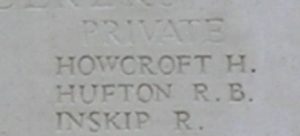
David Lewis Hughes, MM, Driver, 745274, Royal Field Artillery. David was born on 4 July 1896, the son of Lewis Hughes and Sarah Ann Hughes, of 29, Newgate Street, Brecon. His father was a warder at Brecon Jail, but by 1911 had moved the family to Cardiff after he had gained a job as an electric car driver, with the Cardiff Corporation Tramway. David enlisted into the Royal Field Artillery as soon as he left school and served with a Territorial unit, possibly the Welsh Divisional Royal Field Artillery. He embarked for the Mediterranean on 25 November 1915 to join 26 Battery, 17 Brigade, Royal Field Artillery, which was at Gallipoli attached to the 29th Division. The campaign was almost over by the time that David arrived, then on the night of 7 January 1916 the division began its evacuation off the peninsula to Egypt. In March the division was sent to France, sailing to Marseilles and travelling by train to the area east of Pont Remy, before taking over positions facing Beaumont Hamel, on the Somme. The Division suffered terribly on the Somme and was rebuilt before wintering on the Somme. In the spring of 1917 it saw further heavy fighting during the Battle of Arras, before moving to Flanders to take part in the Passchendaele offensive. The division then took part in the latter stages of the Battle of Cambrai, then in the spring of 1918 saw heavy fighting again during the German Spring offensive on the Lys. Following a relatively quiet summer, the division took part in the great advance from Flanders from the end of August 1918. David was wounded during the Battle of Courtrai and died of his wounds on 29 October 1918. The 22-year-old is buried in Lijssenthoek Military Cemetery, Belgium. David had been awarded the Military Medal just prior to his death. He is not commemorated on the Brecon war memorial.
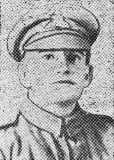
Pryce Hughes, Sergeant, 30, South Wales Borderers. Pryce was born in 1874, the son of Robert Hughes and Anne Hughes, of the Cross Keys Inn at 4, Orchard Street, Llanfaes, Brecon. Following his father’s death in 1891, his mother moved her young family to the Wheatsheaf Inn in Brecon, then the family moved to the New Inn at Merthyr by 1911. Pryce enlisted into the Brecknock Volunteers in 1893 and served with the regiment in South Africa during the Anglo-Boer War of 1899-1902. He continued to serve with the battalion after its conversion to a Territorial Army unit, the Brecknockshire Battalion, in 1908, rising to the rank of Sergeant by the time war erupted. The battalion was attached to the Welsh Division and moved to Pembroke Dock upon mobilisation. It was then withdrawn from the Division and on 29 October 1914 sailed from Southampton for Bombay, where the battalion transhipped and sailed for Aden, arriving on 16 December 1914. The climate in Aden was fearsome, with scorching heat during the day, and with little to do, the men spent much of their free time playing football. By June 1915 the Turks had become overconfident due to the lack of any incursions by the British into Yemen and moved forward to reoccupy fortifications at Sheikh Saad. They then began to shell the island of Perim, so the Allied troops in Aden were mobilised into the Aden Movable Company and ordered to prepare to join with local troops. 400 men of the Brecknocks were allocated to the column, the remainder stayed in Aden. Pryce became ill due to the inhospitable climate in Aden and died of heat stroke and heart failure on 19 June 1915. The 41-year-old was buried with full military honours in Maala Cemetery, Yemen. Pryce is not commemorated on the Brecon war memorial.
James Irons, Company Sergeant Major, 8719, South Wales Borderers. James was born in Fulham, London on 3 December 1884, the son of Henry Irons and Bridget Irons. He enlisted into the South Wales Borderers as a young man and by 1911 was residing at Brecon Barracks. James became well-0known in the town and was a gifted footballer, playing for the regimental team. Following the outbreak of war, James embarked for France with the 1st Battalion, South Wales Borderers and disembarked at Le Havre on 13 August 1914. The battalion was attached to 3 Brigade, 1st Division and entrained for the Belgian frontier, near the town of Mons. The Division then took part in the Battle of Mons on 23 August, following the German invasion of the low countries, and in the epic withdrawal from Mons to the River Marne, where the German drive on Paris was halted. The Germans then withdrew north and took up defensive positions north of the River Aisne, along the Chemin des Dames Ridge and the BEF advanced before launching a frontal attack upon the German positions. James was wounded during the fighting on the Aisne and after treatment in hospitals in France and England, returned to Brecon by November 1914. He married Bertha Atkin Smith, a schoolteacher, of 31, The Watton, Brecon, at the Priory Church in Brecon on 20 October 1915. Upon his full recovery, James was drafted out to Gallipoli to join the 2nd Battalion, South Wales Borderers in October 1915. The battalion was attached to 87 Brigade, 29th Division and had been there since the landings of 15 April 1915. The 29th Division was evacuated to Egypt on 11 January 1916, before being transferred to the Western Front, landing at Marseilles on 15 March and entraining for the Somme sector, taking up positions near Beaumont Hamel, facing Y-Ravine. The Division had an arduous time here too over the coming months, before taking part in a suicidal assault on 1 July 1916, on the opening day of the Somme offensive. The 2nd SWB alone suffered some 384 casualties on that day alone. Although severely depleted, the Division remained in the line here over the coming weeks, in trying conditions. The Division was then pulled out of the line to rest and rebuild before moving back into the line and taking part in the latter stages of the Somme offensive. The Division wintered on the Somme, taking part in the advance which followed the German withdrawal to the Hindenburg Line. At the beginning of April, the entire 29th Division moved out of the Somme sector to the Arras sector, and by 9 April took over a section of the line facing Monchy-le-Preux. The Division then began to prepare for the forthcoming Battle of Arras. At dawn on 23 April 1917, the Division launched an assault on Monchy-le-Preux. The Division moved to Ypres that summer, initially to hold the line whilst other units had been withdrawn for specialist training, in readiness for the Third Battle of Ypres, which opened on 31 July 1917. The 29th Division went into reserve whilst the first attacks, the Battle of Pilckem Ridge, took place, then on the night of 14-15 August the 2nd SWB moved into the line facing Langemarck, ready to launch another offensive. On the following day the battalion reconnoitred the ground in front of them, and laid white tapes in No Man’s Land, to guide the attacking troops, and at dawn on 16 August 1917 the 2nd SWB launched an attack on Langemarck. The battalion successfully took its two objectives, but had suffered 163 casualties. The Division then had another period out of the line to rest and refit before taking part in further fighting near Poelcapelle. Early in October 1917 the Division was relieved from the line at Ypres, and moved south to the Bellacourt area, to prepare to take part in the forthcoming Battle of Cambrai. The Division entrained for Péronne on 17 November, marching to a camp four miles out of the town at Haut Allaines, then by midnight on 18 November had reached Fins. On the following day the Division received its battle stores and detailed orders for the forthcoming battle, marching off via Gouzeaucourt to its assembly positions at Marcoing. The assault began at dawn on 20 November, but the Division suffered terrible casualties whilst attacking Masnières, on the Hindenburg Line. James was killed in action during this attack, on 20 November 1917. The remains of the 32-year-old were carried back behind the lines and he was buried in Villers-Plouich Communal Cemetery, France.
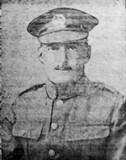
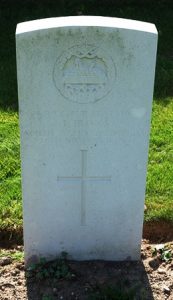
Cyril Isaac, Private, 2316, South Wales Borderers. Cyril was born on 9 November 1896, the son of Major William Thomas Isaac and Eleanor Maria Isaac (nee Bennett), of Castle Farm, Llanfaes, Brecon. He worked at a surveyor’s office in Newport prior to the war, when he enlisted into the Brecknockshire Battalion, South Wales Borderers. The battalion was attached to the Welsh Division and moved to Pembroke Dock upon mobilisation. It was then withdrawn from the Division and on 29 October 1914 sailed from Southampton for Bombay, where the battalion transhipped and sailed for Aden, arriving on 16 December 1914. The climate in Aden was fearsome, with scorching heat during the day, and with little to do, the men spent much of their free time playing football. By June 1915 the Turks had become overconfident due to the lack of any incursions by the British into Yemen and moved forward to reoccupy fortifications at Sheikh Saad. They then began to shell the island of Perim, so the Allied troops in Aden were mobilised into the Aden Movable Company and ordered to prepare to join with local troops. 400 men of the Brecknocks were allocated to the column, the remainder stayed in Aden. A small artillery column was built up to join it and on 3 July the force moved out to Sheikh Othman. Many men collapsed on the march, which was carried out during the full heat of the day, but by 7.30 pm the column had completed its six-mile advance. Percy was among thirteen men who died of heatstroke during the following day, 4 July 1915, during an even longer march. Cyril was among thirteen men of the battalion who died of heatstroke during the march that day. The 18-year-old was buried in Aden, but is commemorated on the Heliopolis Memorial, Aden.
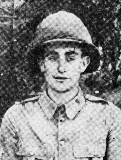
James Philip Arthur James, Sergeant, 10266, South Wales Borderers. James was born in Aldershot in 1893, the son of Evan Jenkin James and Ada James (nee Williams). His father was from Tredegar and was a colour sergeant in the South Wales Borderers. The family moved back to Brecon following the death of his mother in 1900 and the following year his father married Esther Anne Davies, before the family moved to Armoury House, Brynmawr, where James worked for the Ebbw Vale Iron and Coal Company. He was already a member of the 1st Volunteer Battalion, South Wales Borderers when he attested for the Brecknockshire Battalion on 1 April 1908, following the formation of the Territorial Army. He attended two annual TA summer camps before leaving the battalion and by 1911 was serving with the 1st Battalion, South Wales Borderers, which was by then at Chatham Barracks. Following the outbreak of war, James embarked for France with the 1st Battalion, South Wales Borderers and disembarked at Le Havre on 13 August 1914. The battalion was attached to 3 Brigade, 1st Division and entrained for the Belgian frontier, near the town of Mons. The Division then took part in the Battle of Mons on 23 August, following the German invasion of the low countries, and in the epic withdrawal from Mons to the River Marne, where the German drive on Paris was halted. The Germans then withdrew north and took up defensive positions north of the River Aisne, along the Chemin des Dames Ridge and the BEF advanced before launching a frontal attack upon the German positions. The BEF was then withdrawn from the Aisne and transferred to Flanders, taking up positions guarding the Flemish city of Ypres. On 19 October the Germans began attacking the city and over the coming weeks the 1st Division took part in such ferocious fighting that it was almost annihilated. The Division then moved south to the Festubert sector, where it was to remain over the coming months. James was killed in action here on 27 December 1914, just two days after the Christmas Truce. The 21-year-old has no known grave and is commemorated on the Le Touret Memorial, Richebourg-L’avoue, France. His uncle, Wilfred John Davies, was killed on the Somme in 1916. James is not commemorated on the Brecon war memorial.
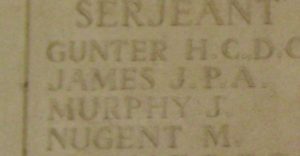
William John Jenkins, Rifleman, 2375, Monmouthshire Regiment. William was born on 10 August 1883, the son of Police Sergeant John Treflys Jenkins and Martha Mary Jenkins (nee Mayo), of 16, Free Street, Brecon. In November 1897 William took up a position as a junior clerk with the Midland Railway at Brecon and continued to work for the railways until leaving in the summer of 1902. By 1911 he was lodging at 39, Coronation Street, Tredegar, where he worked as a railway clerk for the Great Western Railway, then prior to the war he took up a position at the Tredegar Iron and Coal Company at Blackwood. William enlisted at Blackwood into the 1st Battalion, Monmouthshire Regiment soon after the outbreak of war. The battalion was at Stow Hill, Newport, attached to the Welsh Border Brigade, Welsh Division when war broke out and moved to its war station at Pembroke Dock. On 10 August the Division moved to Oswestry, before entraining for Northampton. By December 1914 the 1st Monmouth’s was at Bury St. Edmunds and moved to Cambridge the following month before leaving the Welsh Division and landed in France on 13 February 1915, joining 84 Brigade, 28th Division. The Division was holding a section of front line running from Wytschaete to the Ypres to Zandvoorde road, at Broodeseinde, just beyond Zonnebeke, on the extreme point of the Ypres Salient. On 22 April the Germans launched a poison gas attack at Gravenstafel, the first such attack of the war, and broke the line which was being held by a French Colonial Division. The Canadians rushed in to plug the gap, but this heralded the opening phase of the Second Battle of Ypres and soon afterwards 84 Brigade became dragged into the terrible fighting. William was killed in action during a terrible day on 8 May 1915. The 32-year-old has no known grave and is commemorated on the Ypres (Menin Gate) Memorial, Belgium.
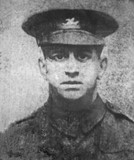
Ernest David Jones, Lieutenant, Royal Air Force. Ernest was born on 5 March 1899, the second son of Benjamin and Matilda Jones of George Street, Brecon. By the turn of the century the family were living at 38, Orchard Street, Llanfaes, Brecon. Jones was educated at Mount Street and Brecon County School before becoming a clerk with Barclays Bank at Newport and then Cardiff. He joined the Royal Flying Corps and served as an Air Mechanic 3rd Class before being commissioned on 12 September 1917, becoming a pilot with 52 Squadron. By the time that Ernest joined the squadron it had equipped with R.E.8s and was flying in support of the allied offensive at Ypres. The squadron suffered heavy losses flying ground attack sorties following the German Spring Offensive in March 1918 and on 1 April became part of the Royal Air Force when the Royal Flying Corps merged with the Royal Naval Air Service. Just two days after this, on 3 April, Ernest was flying R.E.8, serial A3868 on a ground attack mission east of Moreuil when his aircraft was attacked and shot down by Manfred Von Richthofen. Ernest and his navigator, Second Lieutenant Robert Francis Newton, were both killed in the crash and are commemorated on the Arras Flying Services Memorial, France. Ernest had only celebrated his nineteenth birthday on 5 March. A fellow officer wrote to his parents to inform them that he was missing and that he hoped had been taken prisoner but within weeks it became clear that the young man had been killed.
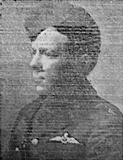
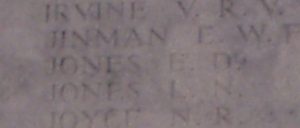
John Harold Jones, Second Lieutenant, Royal Welsh Fusiliers. John was born in 1889, the son of Benjamin Cledan Jones, and Mary Jones (nee Baynton), of 16, Alban Square, Aberaeron. He became a bank clerk at Porthmadog by 1911, but soon moved to Brecon to take up a post at the National and Provincial Bank in the town. John enlisted into the army soon after the outbreak of war and was initially posted to the East Kent Regiment. On 27 March 1917 he was discharged from the regiment upon being granted a commission as Second Lieutenant into the Royal Welsh Fusiliers and embarked for France, joining the 1st Battalion, Royal Welsh Fusiliers, which was attached to 22 Brigade, 7th Division. During March 1917 the 7th Division followed up the German Retreat to the Hindenburg Line and took part in Flanking Operations Round Bullecourt. The Division then saw terrible fighting at Bullecourt, a strongly fortified village on the Hindenburg Line, and alongside the Australians played a major role in penetrating the village defences. Later in the year the Division had a spell out of the line rebuilding and training before moving to Ypres and on 30 September took up positions to the east of Polygon Wood, relieving the 56th Battalion, AIF, which had suffered terrible casualties whilst clearing part of the wood over the previous days. Battalion HQ set up at the mound in the centre of the wood, while the men took over their positions in horrific conditions. The night passed quietly but at dawn on the following day, 1 October 1917, the enemy attacked en masse, and heavy fighting ensued. John was killed in action during the fighting that day. A contemporary newspaper report stated that he was struck by a bullet from a German aircraft which attacked the battalions’ positions and died instantly. The 28-year-old has no known grave and is commemorated on the Tyne Cot Memorial, Belgium.
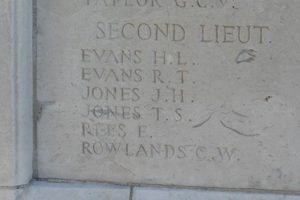
Richard Alun Jones, Second Lieutenant, Tank Corps. Richard was the son of Reverend Griffith Jones and Catherine Jones (nee Owen), of Capel Newydd, Hendy, Pontarddulais. He was educated at Llanelli County School and at The Congregational School, Caterham, Caterham Valley, before gaining a position as bank clerk for the National Provincial Bank at Brecon. He initially volunteered to serve with the Montgomeryshire Yeomanry in January 1916, before being commissioned on 6 March 1917 into the Heavy Branch, Machine Gun Corps. On 28 July 1917 the Heavy Branch was separated from the rest of the Machine Gun Corps to form the Tank Corps. The newly formed Corps saw action during the Battle of Passchendaele, where the tanks proved incapable of moving across the sodden ground. The tank would prove its worth towards the end of the year, when they were used en masse to break the Hindenburg Line, during the Battle of Cambrai. Richard was in command of Tank D41 ‘Demon II’, part of ‘D’ Battalion, Tank Corps. On 20 November 1917, ‘D’ Battalion was attacking toward Flesquières when a shell made a direct hit on D41, instantly killing all her crew. Richard was 20 years old, and was buried in Flesquières Hill British Cemetery, France, in Grave VIII. E. 10. His brother Griffith was lost at sea in 1918. The fascinating fact about this is that a Tank has recently been recovered off the Flesquières Battlefield, which was at first thought to be D41. The tank has since been identified as D47, and is now on display in Flesquières.
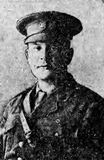
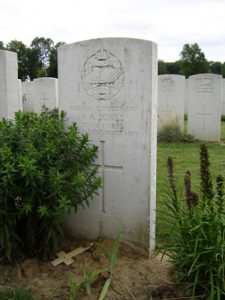
Russell Hafrenydd Jones, Second Lieutenant, Royal Welsh Fusiliers. Russell was born on 11 April 1894, the son of Reverend Canon Edmund Osborne Jones and Ada Jones (nee Howells), of the Vicarage, Llanidloes. The family had resided at Brecon for several years prior to Russell’s birth. He was educated at King Edward’s School in Bath and worked for Lloyds Bank at St. James’ Street, London prior to the war. Russell enlisted into the Queen’s Westminster Rifles, London Regiment soon after the outbreak of war, but was commissioned as Second Lieutenant into the 7th Battalion, Royal Welsh Fusiliers. The battalion was a Territorial unit, which mobilised for war at Newtown in August 1914, as part of North Wales Brigade, Welsh Division and moved to Conway until the end of the month, before moving to Northampton. In December the Division moved to Cambridge and then in May 1915 to Bedford, where the Division was numbered and the formation became 158 Brigade, 53rd (Welsh) Division. On 19 July 1915 the entire Division sailed from Devonport for Imbros and on 9 August 1915 landed at Suvla Bay. The infantry moved off the beaches across the Salt Lake, under shellfire, into the scrub covered Chocolate Hill, but due to a lack of maps and no knowledge of the terrain, many of the units became disorientated, and the situation became chaotic. Russell was killed in action on the following day, 10 August 1915. The 21-year-old has no known grave and is commemorated on the Helles Memorial, Gallipoli. His brother Titho Glynne Jones served with the same battalion, and was killed at Gaza in 1917. Russell is not commemorated on the Brecon war memorial.
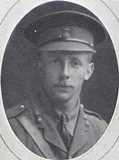
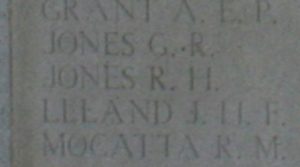
Titho Glynne Jones, Lieutenant, Royal Welsh Fusiliers. Titho was born at Soham, Cambridgeshire in 1887, the son of Reverend Canon Edmund Osborne Jones and Ada Jones (nee Howells). The family had moved to Brecon by 1891, but by the following year were residing at the Vicarage, Llanidloes. Titho was educated at Christ College, where he played for the Rugby XV and also played football for Brecon Town. Upon leaving Brecon, he became an articled clerk, to Mr. W. P. Jones, solicitor of Aberystwyth in 1906, passing his final law examination in 1910. Prior to the war Titho had emigrated to Canada and set up business in British Columbia but following the declaration of war returned to Britain aboard the SS Lusitania and enlisted into the Queen Victoria’s Rifles, London Regiment, serving in France with the battalion from 4 November 1914. On 20 March 1915 Titho was commissioned as Second Lieutenant into the 2/7th Battalion, Royal Welsh Fusiliers, before being posted to the 1/7th Battalion, Royal Welsh Fusiliers. The battalion was a Territorial unit, which mobilised for war at Newtown in August 1914, as part of North Wales Brigade, Welsh Division and moved to Conway until the end of the month, before moving to Northampton. In December the Division moved to Cambridge and then in May 1915 to Bedford, where the Division was numbered and the formation became 158 Brigade, 53rd (Welsh) Division. On 19 July 1915 the entire Division sailed from Devonport for Imbros and on 9 August 1915 landed at Suvla Bay. The infantry moved off the beaches across the Salt Lake, under shellfire, into the scrub covered Chocolate Hill, but due to a lack of maps and no knowledge of the terrain, many of the units became disorientated, and the situation became chaotic. After the fighting died down, the winter rolled in, and the men first had to endure torrential downpours, which flooded the trenches, before the snow hit, and many men began falling ill in the terrible conditions. The Division was eventually evacuated from Gallipoli in December 1915, moving to Egypt to join the EEF, and helped guard the Suez Canal before taking part in operations to drive the Turks out of the Sinai. The EEF then turned its attention onto driving the Turks out of Palestine, and on 26 March 1917 launched its first offensive against the coastal city of Gaza, which guarded the road to Jerusalem. Initial gains during the day were lost when the assaulting divisions lost touch with each other, and communication broke down when a thick fog cloaked the battlefield. A second attempt to force Gaza was launched on 17 April, which also failed. Titho was killed on the day after the battle ground to a halt, on 20 April 1917. The 30-year-old is buried in Gaza War Cemetery, Israel. His brother Russell Hafrenydd Jones served with the same battalion and was killed at Gallipoli in 1915. Titho’s youngest brother Russell was killed at Gallipoli. Titho is not commemorated on the Brecon war memorial.
William Jones, Private, L/11213, Queen’s (Royal West Surrey Regiment). William was born in Builth Wells in 1899 in Builth to Margaret Ann Jones. On 28 September 1907 Margaret married John Pritchard, a widower from Brecon, and the couple set up home with Margaret’s mother Mary at 41, The Struet, Brecon. William was living at Penmaenmawr, in North Wales, when he travelled to London to enlist at Camberley into the 10th Battalion, Queen’s (Royal West Surrey Regiment). William joined the battalion at Stanhope Lines, Aldershot, where it was attached to 124 Brigade, 41st Division. The battalion landed at Le Havre on 6 May 1916 and moved with the 41st Division to the areas of Ploegsteert and the Douve valley, south of Ypres for trench initiation. The Division remained here until the middle of August 1916, when it moved south to the Somme, and took over trenches north-east of Delville Wood, in readiness to take part in the Battle of Flers-Courcelette. William was wounded during an attack on 15 September and was evacuated to hospital at Rouen, where he died of his wounds on 25 September 1916. The 17-year-old is buried in St. Sever Cemetery, Rouen, France. His step-brother, Alfred Pritchard died at Malta in 1915 of dysentery contracted at Gallipoli, whilst two uncles, Philip and Arthur Pritchard, also fell during the war.
William Jones, Private, 54369, Royal Welsh Fusiliers. William was born at Glyn, Breconshire in 1889, the son of Morgan Jones and Elizabeth Jones (nee Thomas). He married Gladys Rose Bugby in 1914 and the couple set up home at Newmarch Street, Brecon, where their only child, a daughter, Margaret Elizabeth Jones, was born later that year. William enlisted into the Welsh Horse Yeomanry soon after the outbreak of war, but instead of embarking for Gallipoli with the regiment, was transferred to the 19th Battalion, Royal Welsh Fusiliers. The battalion was raised in March 1915 by the Welsh National Executive Committee as a bantam Battalion, originally attached to the 38th (Welsh) Division, but in September 1915 moved to Aldershot to join 119 Brigade, 40th (Bantam) Division. Early in June 1916 the division moved to France, initially to positions around Lillers before taking over the North Maroc Sector, near Loos, for trench initiation and once acclimatised was left to hold the sector itself over the coming months. The infantry battalions of the Division then began the usual routines of rotating for duty in the trenches: normally four days in the front line; four in support and four in reserve. Late in 1916 the Division moved south to the Somme, and fought at the Battle of the Ancre, before remaining in the sector over the winter. In March 1917 the Germans withdrew to their shortened line, called the Hindenburg Line, and the 40th Division was among the units which followed the withdrawal. Later in the year the Division took part in the Battle of Cambrai and launched an attack on Bourlon Wood on 23 November 1917. The attack was carried out by 119 Brigade, led by the 12th SWB and 19th RWF. The 17th Welsh was in support for the initial assault, but was soon ordered to advance, to support the two attacking battalions. Heavy fighting raged within the wood over the coming days, with the 18th Welsh also being thrown forwards into the fight, and the Division suffered terribly. William was killed in action in Bourlon Wood on 23 November 1917. The 28-year-old has no known grave and is commemorated on the Cambrai Memorial, Louverval, France.
James Kelly, Private, 45425, South Staffordshire Regiment. James was the son of John Kelly and Anne Kelly (nee Bullen), of 1, Bailey Glaes Court, Brecon. By 1901 James had left home and was lodging at Garth Road, Builth, where he worked as a fellmonger. By 1905 he had moved back to Brecon and married Theresa Watkins in 1905, but the marriage appears to have failed as by 1911 he was living back with his parents at 54, The Struet, Brecon. James enlisted into the army at Brecon and was initially posted to the King’s (Liverpool Regiment). Upon completing his training he was posted to the 4th Battalion, South Staffordshire Regiment, which was at Canterbury attached to the 67th Division. On 10 October 1917 the battalion landed at Le Havre and joined 7 Brigade, 25th Division, which was by then billeted near Bethune. After wintering in Flanders, the division then moved to positions around Bullecourt in reserve, where it was used to reinforce the badly depleted British units that were hit in the area by the German Spring Offensive of 21 March 1918. The division moved back to Flanders on the night of 30 March, taking up positions at Ploegsteert, where it received reinforcements, and rebuilt. However, on 9 April the Germans launched an offensive on the Lys, and the Division was caught up in the terrible fighting here, suffering terrible casualties over the coming days. The Division withdrew to Abeele on 17 April, but on 25 April was ordered back into the line, and took part in the Second Battle of Kemmel. On 9 May the Division moved to Fismes, 20 miles south-east of Soissons in the Champagne, to give it a chance to rest and rebuild again. On 26 May the division took up positions south of the Aisne, to guard against a predicted German Offensive, then on the following morning, 27 May 1918, the Germans attacked on the Aisne, and during the coming days the Division was virtually annihilated. James was killed in action here on 29 May 1918. The 37-year-old has no known grave and is commemorated on the Soissons Memorial, Aisne, France. His nephew, Thomas John Kelly, was killed in France in November 1918.
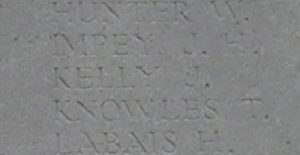
Thomas John Kelly, Private, 35479, Yorkshire Regiment. Thomas was born in Welshpool in 1899, the eldest son of Thomas Kelly and Annie Kelly (nee Watkins). By 1901 he was residing with his mother and her parents at Hackford Cottage, Staunton on Wye, but by 1911 the family had moved to 19, Newmarch Street, Llanfaes, Brecon. Thomas enlisted at Bargoed into the army and was posted to the 69th Training Reserve Battalion, then after completing his training was drafted to France, initially joining the 11th Battalion, West Yorkshire Regiment, before being transferred to the 2nd Battalion, Alexandra, Princess of Wales’s Own (Yorkshire Regiment), the Green Howards. The battalion was attached to 32 Brigade, 11th (Northern) Division and had a relatively quiet time stationed in the Ypres Salient during the last winter of the war. At the end of May 1918, the division was transferred to the Loos sector, where it remained over the final summer of the war. Just to the south, the Allies launched a great offensive on the Somme front on 21 August 1918 and began driving the Germans back towards the Hindenburg Line. Soon afterwards the 11th Division joined the offensive, passing through Vis-en-Artois, and the Division fought at the Battle of Drocourt-Queant, before fighting at the Battle of the Canal du Nord. The Hindenburg Line was broken on 29 September and the 11th Division took part in the advance northwest of Cambrai, following the German withdrawal to the River Selle. Thomas was killed in action during the Battle of the Selle, during an attack by his battalion upon the Bavai to Montigny road on 6 November 1918. The 19-year-old was buried in Bettrechies Communal Cemetery, France. His uncle, James Kelly, had been killed in France just months earlier.
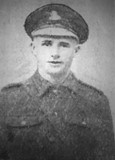
Herbert Wallis Kendall, Private, 23308, Welsh Regiment. Herbert was born in Gateshead, Durham in 1874, the son of John Hinton Kendall and Sarah Kendall (nee Wilson). His father was a dentist and Hernert followed him into the profession, before marrying Beatrice Mary Ann Piddington in Newcastle in 1897. The couple had two children during the coming years, but sadly one, a son Ernest, died in 1901, before the family moved to Wales, setting up home at 1, Dainter Street, Brecon. Herbert enlisted at Cardiff soon after the outbreak of war, into the 16th (Cardiff City) Battalion, Welsh Regiment. The battalion was raised at Cardiff in November 1914 by the Lord Mayor and Corporation, before moving to Colwyn Bay to join 130 Brigade, 43rd (Welsh) Division and trained in North Wales before moving to Winchester in the summer of 1915, where the formation became renumbered 115 Brigade, 38th (Welsh) Division. The Division moved to France on 2 December 1915 and moved to the Nursery Sector near Fleurbaix for trench initiation alongside the Guards Division. The Division then held a sector of the line near Cuinchy before marching south to the Somme sector in June 1916 to take part in the assault on Mametz Wood. The first attack on the wood was launched on a two-battalion front on 7 July, but failed, and the Divisional Commander, Sir Ivor Philipps, was replaced before the Division attacked again on a two Brigade front on 10 July 1916. Herbert had been killed in action during the divisions catastrophic first attack upon the wood, on 7 July 1916. The 42-year-old has no known grave and is commemorated on the Thiepval Memorial, France.
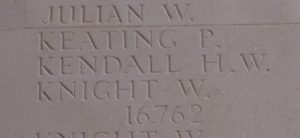
Patrick George Kennedy, Private, 200612, South Wales Borderers. Patrick was born in Chepstow in 1894 the son of James Kennedy and Elizabeth Kennedy (nee Stephens). Upon leaving school, Patrick began working for the Post Office in Newport, but had gained a position as a clerk at Brecon with the Post Office by September 1911. He enlisted at Brecon into the Brecknockshire Battalion, South Wales Borderers soon after the outbreak of war. The battalion was attached to the Welsh Division and moved to Pembroke Dock upon mobilisation. It was then withdrawn from the Division and on 29 October 1914 sailed from Southampton for Bombay, where the battalion transhipped and sailed for Aden, arriving on 16 December 1914. The battalion endured a torrid time in the heat of Aden, losing several men to heatstroke. In August 1915 the battalion moved to India on garrison duties and Patrick joined the battalion there, having embarked on 3 July 1915. The climate in India was almost as bad as in Aden, with many men becoming ill, through enteric fever and dysentery. Patrick took ill at the beginning of 1917 and died of enteritis at Cumballa Hospital, Bombay on 29 January 1917. The 22-year-old was buried in Sewri Cemetery, Bombay, but is commemorated on the Kirkee 1914-1918 Memorial, India.
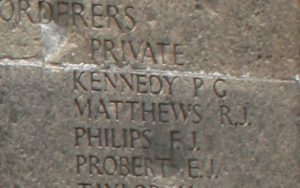
John Henry George Kingdon, Private, 200135, South Wales Borderers. John was born in Cardiff in 1893, the son of John Joseph Kingdon and Jane Kingdon (nee Day). The family had moved to Newport by 1901, then by 1911 were living at 1, Lion Yard, Brecon, where John worked as an apprentice cycle fitter. By 1912 John had moved to Cardiff, to work at Cardiff Railway Station. He had enlisted into the Brecknockshire Battalion, South Wales Borderers prior to the outbreak of war and on 4 August 1914 returned to Brecon for mobilisation. The battalion was attached to the Welsh Division and moved to Pembroke Dock upon mobilisation. It was then withdrawn from the Division and on 29 October 1914 sailed from Southampton for Bombay, where the battalion transhipped and sailed for Aden, arriving on 16 December 1914. The battalion endured a torrid time in the heat of Aden, losing several men to heatstroke. In August 1915 the battalion moved to India on garrison duties and Patrick joined the battalion there, having embarked on 3 July 1915. The climate in India was almost as bad as in Aden, with many men becoming ill, through enteric fever and dysentery. John served overseas for the remainder of the war, but sadly soon after the Armistice, took ill and died of pneumonia at Tehran on 22 November 1918. The 25-year-old was buried in Tehran War Cemetery, Iran.
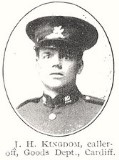
Michael William Knight, Private, 2962, Royal Army Medical Corps. Michael was born in Brecon in 1886, the son of Michael Knight and Annie Knight (nee Jones). His father, from Abergavenny, was serving with the South Wales Borderers and was based at the Barracks. David worked as a porter as a young man and by 1901 was lodging at 71, The Watton, Brecon, but by 1911 he was lodging at 62, Port Tennant Road, Swansea, where he worked as a cutter. Michael enlisted into the South Wales Borderers at Newport just prior to the outbreak of war, but, probably due to being unfit for infantry duty, transferred to the Royal Army Medical Corps. He embarked for France with the BEF on 15 August 1914 as a staff member of the 3rd General Hospital, but at some time afterwards transferred to the 27th Field Ambulance, which was attached to the 9th (Scottish) Division. The Division had moved to France during the summer of 1915 and saw its first major action during the Battle of Loos. It then took part in the Battle of the Somme the following year, fighting at the opening Battle of Albert, and then at the Battle of Bazentin, where it captured Longueval. The division then fought at the Battle of Delville Wood, and the Battle of Le Transloy, before wintering on the Somme. By April 1917 the division was at Arras, where it fought at the First Battle of the Scarpe and the Third Battle of the Scarpe. The Division then moved north to Ypres, and fought at the Battle of the Menin Road, and at the First Battle of Passchendaele, before being moved to Cambrai, and fought at the Action of Welsh Ridge. In March 1918 the division was still in the Cambrai area when it was hard hit by the Germans following the launching of their Spring Offensive on 21 March and after suffering terrible casualties moved to Flanders to rebuild. Unfortunately, the Germans launched another offensive along the Lys valley on 9 April 1918, and the Division was caught up in heavy fighting once more. Michael was killed in action during heavy fighting on 25 April 1918. The 32-year-old has no known grave and is commemorated on the Tyne Cot Memorial, Belgium.
George Thomas Knowles, Private, 11261, South Wales Borderers. George was born on 12 October 1893, the son of Frank Knowles and Charlotte Ann Knowles (nee Williams), of 18, Pendre, Brecon. His father Frank worked as a gardener. George worked as a bricklayer’s labourer prior to enlisting at Tonypandy into the South Wales Borderers. He was drafted to France on 29 November 1914, joining the 1st Battalion, South Wales Borderers, which was in Flanders attached to 3 Brigade, 1st Division. George was wounded and invalided home soon afterwards and upon recovering, was posted to the 2nd Battalion, South Wales Borderers, which had returned from China in January 1915. The battalion was at Rugby, attached to 87 Brigade, 29th Division. On 17 March 1915 the battalion sailed from Avonmouth with the Division, arriving at Alexandria on 29 March, before moving to Mudros. On 25 April 1915 the Division landed at Cape Helles, Gallipoli, as part of the original landing force which had been despatched to try and seize the Dardanelles Straits and force Turkey out of the war. The invasion forces failed to break the Turkish defences and the campaign became bogged down. George was killed in action at Gully Ravine on 11 June 1915. The 21-year-old has no known grave and is commemorated on the Helles Memorial, Gallipoli.
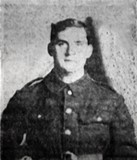
Benjamin Alec Lane, Private, 27502, South Wales Borderers. Benjamin was born in Kempley, Gloucestershire on 21 November 1886, the son of Allen Lane and Elizabeth Lane (nee Bevan). His father died when Benjamin was young, so he die not leave home until after marrying Rosina Sleeman, a domestic servant and nurse, at Kempley in 1913. The couple then moved to Brecon, where Benjamin had gained work at Penoyre Mansion. He enlisted at Brecon into the South Wales Borderers and after completing his training at the Barracks, was drafted to the Middle East to join the 4th Battalion, South Wales Borderers. The battalion was attached to 40 Brigade, 13th (Western) Division and had taken part in the Gallipoli campaign before being evacuated to Mudros on 8 January 1916. The division then moved to Egypt, and on 15 February 1916 embarked at Suez, arriving at Basra on 4 March to join the forces being assembled to attempt to relieve the besieged garrison of Kut-al-Amara. The attempt failed, and Townshend’s forces were marched into captivity, however the Mesopotamian forces were built up before beginning an arduous campaign to clear the country from the Turks. Benjamin was killed in action near Baghdad on 14 February 1917. The 30-year-old has no known grave and is commemorated on the Basra Memorial, Iraq.
Aaron Letton, Company Sergeant Major, 8198, South Wales Borderers. Aaron was born in 1885, the son of Company Quartermaster Sergeant Joseph Letton and Catherine Letton (formerly Barksby), of The Barracks. His mother was a widow when she married his father, to the late Colour Sergeant Edwin Barksby, of the South Wales Borderers, who had died in 1877. Aaron worked in the Barracks as canteen waiter as a young man, as his father had retired from the army and taken over the position of canteen manager. By 1911 he had enlisted into the 1st Battalion, South Wales Borderers and was stationed at Shornmead Fort near Gravesend, where he gave his occupation as a grocers assistant. Following the outbreak of war, Aaron embarked for France with the 1st Battalion, South Wales Borderers and disembarked at Le Havre on 13 August 1914. The battalion was attached to 3 Brigade, 1st Division and entrained for the Belgian frontier, near the town of Mons. The Division then took part in the Battle of Mons on 23 August, following the German invasion of the low countries, and in the epic withdrawal from Mons to the River Marne, where the German drive on Paris was halted. The Germans then withdrew north and took up defensive positions north of the river Aisne, along the Chemin des Dames Ridge and the BEF advanced before launching a frontal attack upon the German positions. Following the battle, the BEF was moved north to Flanders where it played a vital role in stopping the German drive towards the Channel Ports, by saving the vital city of Ypres. The division then moved slightly south and wintered in Flanders, north-east of Bethune, near Richebourg. The 1st Division took part in its first major action of 1915 here on 9 May 1915, during the Battle of Aubers Ridge, when it attacked alongside the Meerut Division. The Division then moved south to Loos, and saw heavy fighting during the Battle of Loos, and the action at the Hohenzollern redoubt. During July 1916 the Division moved south, to join the great Somme offensive, and reached Albert by 11 July, taking up billets in the town. On the morning of 15 July, the division received orders to proceed via the recently captured Mametz Wood to the new front line, facing Bazentin Ridge, and took over positions near Bazentin-le-Petit Wood, taking part in heavy fighting over the coming months. The division followed the German retreat to the Hindenburg Line in early 1917 and was then briefed for an operation on the Flanders Coast and moved to positions near Coxyde during the summer of 1917. Whilst preparing for this operation, the Passchendaele offensive had stalled in the mire, and the Division was transferred to the Ypres Salient, to help in the drive to capture Passchendaele Ridge. On the evening of 9 November 1917, the 1st SWB moved forwards to launch an assault alongside the Canadians against Passchendaele. Conditions by now were dire, with the battlefield reduced to thick mud and the 1st SWB suffered terrible casualties as it attacked on the following morning. Aaron was killed in action during the attack of 10 November 1917. The 32-year-old has no known grave and is commemorated on the Tyne Cot Memorial, Belgium.
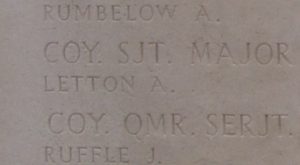
John Sydney Letton, Private, 2866, Montgomeryshire Yeomanry. John was born on 27 March 1890, the son of John Letton and Elizabeth Letton (nee Trigg), of 92, The Watton, Brecon. His father died in 1890 and his mother remarried to John Watkins. John enlisted into the Brecknockshire Battalion on 6 March 1909, by which time he was serving an apprenticeship as a carriage painter at Rich and Sons, The Watton. John attended the annual TA summer camps at Porthcawl, Aberystwyth, Haverfordwest and Hereford over the coming years, but then left the battalion. On 11 November 1914 he enlisted at Bargoed into the Army Service Corps and was sent to Aldershot, but within days he had been discharged on the grounds of ill-health. Undeterred, John travelled to Welshpool to enlist into the Montgomeryshire Yeomanry. The battalion had mobilised for war at Welshpool as part of the South Wales Mounted Brigade, before moving with the brigade to Hereford. On 29 August 1914 the brigade moved to Thetford and then to Buckling, where it joined the 1st Mounted Division at Holt. In October 1915 the battalion moved to Cromer, where it was dismounted and on 4 March 1916 sailed from Devonport for Egypt, to join the 4th Dismounted Brigade in the Western Frontier Force. John then saw service with the Montgomery Yeomanry during the defence of the Suez Canal over the coming months, before becoming ill and died of heart failure on 2 October 1916. The 26-year-old was buried in Cairo War Memorial Cemetery, Egypt.
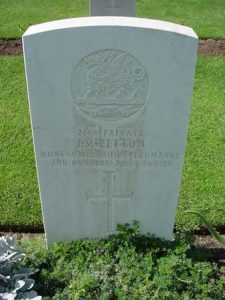
Ernest Clifford Lewis, Private, 2967, South Wales Borderers. Ernest was born in Llanelli, Carmarthenshire in 1899, the son of David Lewis and Anne Lewis (nee Jenkins). Within two years the family had moved to 37, Newmarch Street, Llanfaes, Brecon and his father had found work as an assistant prison warder at Brecon Jail. Ernest’s father died in about 1905 and in 1907 his mother remarried to William Francis Jones, of 10, Newmarch Street. Ernest worked as a school shop assistant prior to the war. He enlisted into the 2/1st Brecknockshire Battalion, South Wales Borderers in the winter of 1915-1916 and joined the battalion at Bedford, where it was attached to the 68th (2nd Welsh) Division. Ernest was then posted to Skipton with the battalion but had not been there long when he took ill and died of heart failure in hospital at Sheffield on 6 April 1916. The remains of the 17-year-old were brought home and he was buried with full military honours in St. David’s Churchyard, Brecon.
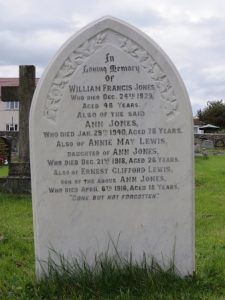
William Owen Lewis, Private, 34536, The Loyal North Lancashire Regiment. William was born in 1882, the son of John and Elizabeth Lewis, of Llanidloes and was baptised there on 6 August that year. The family moved to Brecon by 1891 and William married Annie Hargest at Bwlch in 1905. William enlisted into the army at Brecon and was drafted to France in the Spring of 1917, where he was posted to the 9th Battalion, The Loyal North Lancashire Regiment. The battalion was attached to 74 Brigade, 25th Division in the Ploegsteert sector, remaining here over the coming months leading up the Battle of Messines in June 1917. After fighting at Messines, the Division moved north, and fought at Pilckem, before moving south again, taking up positions around Bullecourt in reserve. Here the Division was used to reinforce the badly depleted British units that were hit in the area by the German Spring Offensive from 21 March 1918. The Division moved north to Flanders on the night of 30 March, where it took up positions at Ploegsteert again and over the coming days rested and refitted. Unfortunately, on 9 April the Germans launched an offensive on the Lys, and the Division was caught up in the terrible fighting here over the coming days. The battered Division withdrew to Abeele on 17 April, but on 25 April was ordered back into the line, and took part in the Second Battle of Kemmel. On 9 May the Division moved to Fismes, 20 miles south-east of Soissons in the Champagne, to give it a chance to rest and rebuild again. However, on 26 May the Division took up positions south of the Aisne, to guard against a predicted German Offensive and at dawn on the following day, 27 May 1918 the attack hit them, and during the coming days the Division was virtually annihilated. William had been taken prisoner during the fighting in the Champagne and was taken to a Prisoner of War camp in Germany, where he died of influenza on 14 October 1918. The 37-year-old is buried in Niederzwehren Cemetery, Kassel, Germany. William is not commemorated on the Brecon war memorial.
Albert Edward Lowe, Private, 267495, Monmouthshire Regiment. Albert was the son of Thomas Lowe and Alice Lowe (nee Hart), of 16, Newgate Street, Llanfaes, Brecon. Albert worked as a cow boy for the Morgan family at Ty Uchaf, Trawscoed prior to the war. He enlisted into the 2/1st Brecknockshire Battalion at Brecon on 6 November 1914 and was posted to Bedford to join the battalion, which was attached to the 68th (2nd Welsh) Division. On 30 July 1916 Albert embarked for France, joining the Infantry Base Depot at Rouen, and was then transferred to the 2nd Battalion, Monmouthshire Regiment. The battalion had only recently joined the 29th Division as the Divisional Pioneer Battalion when Albert joined its ranks and had just moved from the Somme to Ypres to rebuild following heavy losses. The Division held the line here over the coming weeks as it rebuilt its strength and the 2nd Monmouth’s worked hard on improving trenches and digging new communications trenches. The battalion then worked on the Menin Road, erecting elephant shelters, then on 4 October the Division was relieved and entrained south for the Somme once more, moving to Trônes Wood, before joining the latter stages of the Somme offensive. The Division wintered on the Somme, with the 2nd Monmouth’s working on road repairs around Montauban, then at Ginchy, Flers and Morval. The 2nd Monmouth’s moved into reserve at the end of December and moved to Fourdrinoy, where the men trained in infantry assault manoeuvres. On 12 January 1917 the battalion began marching back into the battle area, taking over positions near Morval, and began supplying working parties around Montauban once more. The Division then moved to the Arras sector and in April 1917 fought at the Battle of the Scarpe, which was part of the Arras Offensive, seeing heavy fighting around Monchy-le-Preux. Albert was hospitalised just afterwards, then returned to duty following the divisions move to the Ypres Salient. Albert had two weeks leave in August 1917, while the division took part in the Battle of Langemarck, and upon his return took part in the divisions further actions near Poelcapelle. Early in October 1917 the Division was relieved from the line at Ypres, and moved south to the Bellacourt area, to prepare to take part in the forthcoming Battle of Cambrai. The Division entrained for Péronne on 17 November, marching to a camp four miles out of the town at Haut Allaines, then by midnight on 18 November had reached Fins. On the following day the Division received its battle stores and detailed orders for the forthcoming battle, marching off via Gouzeaucourt to its assembly positions at Marcoing. The assault began at dawn on 20 November, but the Division suffered terrible casualties whilst attacking Masnières, on the Hindenburg Line. After wintering in the Cambrai sector, in January 1918 the 29th Division moved back to Ypres, taking up positions at Passchendaele Ridge again. To the south, the Germans launched the opening phase of their great offensive along the Somme front on 21 March 1918, then on 9 April launched the second phase along the Lys Valley. The 29th Division was relieved by the 41st Division that day and moved out of the line, before being rushed to positions at Les Haies Basses on the evening of 10 April. On the following morning the Division was hit by the Germans and the 29th Division was forced to withdraw, as they were flanked on the left. Albert was posted as missing during the terrible fighting of 11 April 1918 and was later declared as having been presumed killed on that date. The 21-year-old has no known grave and is commemorated on the Ploegsteert Memorial, Belgium.
Richard Aveline Maybery, MC & Bar, Lieutenant, Royal Flying Corps. Richard was born on 4 January 1895, the son of Henry Oxenford Aveline Maybery and Lucy Powys Maybery (nee Cobb), of The Priory, Brecon. He was educated locally and at Wellington College, Berkshire, before entering the Royal Military College at Sandhurst and after graduating was commissioned as Second Lieutenant into the 21st (Empress of India’s) Lancers on 17 September 1913. When war broke out, Richard was serving on the North West Frontier. He was wounded in action at Shabqadar on 15 September 1915 and had to undergo a lengthy spell in hospital, before returning home to recover. Bored of doing nothing he volunteered for the Royal Flying Corps and was appointed a flying officer on 10 October 1916. He was then trained as a pilot before being posted to France to join the famous 56 Squadron, RFC. The squadron was renowned as one of the finest fighter squadrons of the war and amongst its numbers boasted the likes of James McCudden, Arthur Rhys Davids and Keith Muspratt. Richard proved to be as fiercesome a pilot as his peers as he accumulated over 21 kills over the coming months. He was awarded the Military Cross on 26 September 1917: ‘For conspicuous gallantry and devotion to duty. After attacking two aerodromes in succession at very low altitudes, and inflicting considerable damage, he attacked and dispersed a number of mounted men and then attacked a goods train. He next attacked and shot down a hostile machine at 500 feet, and before returning attacked a passenger train. On numerous occasions he has attacked, single handed, large hostile formations and set a fine example by his gallantry and determination.’ And was then promoted to Captain, before gaining his second award of the Military Cross on 17 December: ‘For conspicuous gallantry and devotion to duty as leader of offensive patrols for three months, during which he personally destroyed nine enemy aeroplanes and drove down three out of control. On one occasion, having lost his patrol, he attacked a formation of eight enemy aeroplanes. One was seen to crash and two others went down, out of control, the formation being completely broken up.’ His final victory came whilst flying over Bourlon Wood on 19 December 1917, when he shot down a German Albatros D.V. Moments later Richard was shot down and killed, possibly the victim of a German anti-aircraft battery, and crashed near the village of Haynecourt. The 22-year-old was originally buried in Haynecourt German Cemetery, but in October 1920 his grave was exhumed and he was re-interred in Flesquières Hill British Cemetery, France.
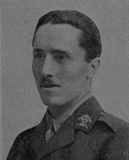
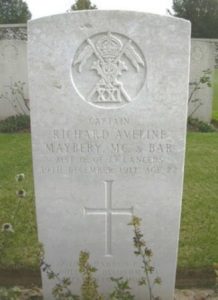
Michael Mines, Private, 15446, South Wales Borderers. Michael was born at Hugginstown, Kilkenny in 1855, the son of Laurence Mines and Margaret Mines (nee Hurley). He enlisted into the Royal Irish Regiment at Fermoy in 1876 and served for almost eight years, seeing service in South Africa during the Zulu War, before leaving the army in 1883. He married Maria McGrath at Lismore in 1881 and the couple had three children over the coming years, but due to the poverty at the time in Ireland, Michael re-enlisted at Kilkenny on 27 December 1888 into the 18th Foot (Royal Irish Regiment). Michael continued to serve for another twenty years and by 1901 was based in Aldershot, then after retiring in 1908 he went back to Ireland and worked as a servant in Monkstone, Dublin. At some time he appears to have married Margaret Leonard, and the couple had two children, Joseph and Eliza. When war erupted, Michael was working in South Wales. He enlisted into the South Wales Borderers in Brynmawr soon afterwards and was posted to the Depot at Brecon. On 7 February 1915 Michael became ill and was admitted into Brecon Military Hospital. He sadly died there six days later, of pneumonia, on 14 February 1915. The 60-year-old was buried with full military honours in Brecon Cemetery. Michael is not commemorated on the Brecon war memorial.
Cyril Stuart Moore, Lance Bombardier, 146600, Royal Garrison Artillery. Cyril was born in Malvern in 1894, the son of George William Moore and Constance Harriett Moore (nee Bent). His father ran his own butchers shop on Malvern for many years but by 1911 had moved his family to the Cwm Inn, at Avenue Road, Brecon. Cyril enlisted into the Army Service Corps at Pentre soon after the outbreak of war and embarked for France on 12 October 1914 to join the BEF. He must have been invalided home at some time, as he married Eleanor Mary Vaughan, of Abercynon, at Leominster in March 1917 after having been transferred to the Royal Garrison Artillery at No 2 Depot. The couple then set up home at Lichfield Vaults, Church Street, Hereford. Cyril returned to France for a while, but was wounded the following year and invalided back to England. He was eventually admitted to Beechwood Red Cross Hospital at Hereford, where he died on 6 July 1918. The 23-year-old was buried in Hereford Cemetery.
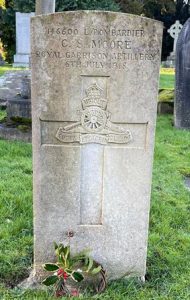
Christmas Morgan, Sergeant, 8014, South Wales Borderers. Christmas was born at Pentyrch on 25 December 1885, the son of Thomas Morgan and Hannah Morgan. By 1901 the family had moved to 59, Church Street, Thurnsco, between Barnsley and Doncaster, where Thomas was working as a railway labourer. Christmas left home soon afterwards to enlist into the South Wales Borderers and was posted to Brecon Barracks. He married Ada Matilda Rose Kate Skinner at Brecon on 8 February 1910 and the couple set up home at 5, John Street, Brecon. Where they had three children over the coming years. Christmas was drafted to France on 26 December 1915 and joined the 1st Battalion, South Wales Borderers, which was by then near Loos and was attached to 3 Brigade, 1st Division. The division had suffered heavy casualties during the Battle of Loos and also during the subsequent actions at the Hohenzollern Redoubt over the preceding months and was holding the line at Loos still when Christmas arrived at the front. On 7 January 1916 3 Brigade was relieved from the front line and entrained at Noeux-les-Mines for Lillers, before marching to billets at Ferfay. On 7 February the brigade began marching out of its rest area, as the 1st Division had been allotted a new section of front line and by 11 February took over the Maroc sector. On 19 February 1916 reports came in that parties of Germans were attempting to consolidate some craters in No Man’s Land, so the 1st SWB sent out a raiding party to destroy them. Christmas was killed by machine-gun fore during the fighting which ensued that day. The 32-year-old has no known grave and is commemorated on the Arras Memorial, France.
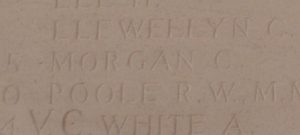
Reginald Tyndall Morgan, Private, 152, Royal Army Medical Corps. Reginald was born on 17 September 1896, the son of William Morgan and Catherine Ellen Morgan, of 2, St John’s Terrace, Pendre, Brecon. His father died when Reginald was just ten years old and the family moved to 91, The Struet, Brecon. After leaving school, Reginald worked as a clerk for J. A. Jebb, Solicitors. He enlisted at Brecon into the 2/1st Welsh Field Ambulance, Royal Army Medical Corps on 12 June 1915 and was posted to Bedford, where the 68th (2nd Welsh) Division was training. Reginald married Louisa Woodbury, at Newport, whilst home on leave later that year. On 4 April 1916 Reginald was hospitalised at Bedford after becoming ill and was diagnosed as suffering from bronchitis. Upon his release from hospital he returned to duty, but over the coming months he suffered three further bouts of sickness, so on 22 September 1916 Reginald was discharged from the army as medically unfit and returned home, to take up work as a clerk for Breconshire Education Authority. His condition continued to worsen and he was initially sent to the Builth Wells Cottage Hospital, but with his condition worsening even further, he was sent to Beechwood Sanatorium at Newport, where he died of pulmonary tuberculosis on 28 July 1918. The remains of the 21-year-old were brought home and he was buried in Brecon Cemetery. Reginald is not commemorated by the CWGC as a casualty of war, despite the authors best efforts, as there is insufficient evidence to link his death of TB with his wartime bronchitis.
William Edwin Morgan, Private, 27794, South Wales Borderers. William was born in Llanspyddid in 1898, the son of William Morgan and Annie Eleanor Morgan (nee Price). By 1902 the family had moved to Church Road, Llanfrynach and William worked as a newsboy. Prior to the war the family moved to Avenue Court, Brecon, then William left home to work for the Brecon and Merthyr Railway in Machen. He enlisted at Brecon into the 2/1st Brecknockshire Battalion, South Wales Borderers soon after the outbreak of war. William was posted to Bedford to join the battalion, then after completing his training was drafted to the Middle East on 3 July 1915, to join the 1st Brecknock Battalion at Aden. Soon afterwards the Brecknocks were transferred to India, to serve as garrison troops, but William wanted to see action, so he voluntarily transferred to the 4th Battalion, South Wales Borderers. The battalion was in Mesopotamia, attached to 40 Brigade, 13th (Western) Division and had been sent there to help in the attempt to relieve the besieged forces of General Townshend at Kut. William was killed in action during the drive on Baghdad on 30 April 1917. The 19-year-old has no known grave and is commemorated on the Basra Memorial, Iraq.
George Morris, Private, 29308, Royal Welsh Fusiliers. George was born at Cardiff in 1898, the illegitimate son of Margaret Ellen Morgan. His mother was from Brecon, but after giving birth to George, went to live at Cardiff Workhouse, before returning to Brecon to marry Morgan Morris, of 8, Mill Green, Brecon in 1902. George then returned to live with his mother and Morgan raised him as his own son. George worked as a baker prior to enlisting into the 19th Battalion, Royal Welsh Fusiliers at Welshpool on 31 June 1915. The battalion had been raised in March 1915 by the Welsh National Executive Committee as a bantam Battalion, originally attached to the 38th (Welsh) Division, but in September 1915 moved to Aldershot to join 119 Brigade, 40th (Bantam) Division. Early in June 1916 the division moved to France, initially to positions around Lillers before taking over the North Maroc Sector, near Loos, for trench initiation and once acclimatised was left to hold the sector itself over the coming months. The infantry battalions of the Division then began the usual routines of rotating for duty in the trenches: normally four days in the front line; four in support and four in reserve. George was wounded by a gunshot to his right hand on 3 August but re-joined the battalion three days later. Late in 1916 the Division moved south to the Somme, and fought at the Battle of the Ancre, before remaining in the sector over the winter. In March 1917 the Germans withdrew to their shortened line, called the Hindenburg Line, and the 40th Division was among the units which followed the withdrawal, advancing along the Somme valley, and by 7 April had reached Etricourt. The men were then put to work repairing roads and constructing billets, as the Germans had carried out a scorched earth policy during their withdrawal. On 17 April the 19th RWF moved into the new front line in front of Gouzeaucourt, relieving part of the 8th Division, which carried out an assault on Gonnelieu two days later. At dawn on 21 April 1917 the 19th RWF took part in an assault on Fifteen Ravine, in conjunction with the 12th SWB. George was killed in action during the attack that day. The 19-year-old has no known grave and is commemorated on the Thiepval Memorial, France.
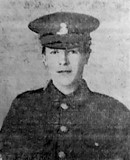
John Harold Morris, Sergeant, 200521, South Wales Borderers. John was born on 5 August 1881, the son of John Cape Bevan Morris, a chemist, and Rose Amelia Morris (nee White), of 2, High Street, Brecon. Upon leaving school, John worked as a chemist’s assistant to his father. On 26 December 1907 John married Mary Florence Sarah Price, of the Sarah Siddons Public House, and the couple set up home at 3, Lansdowne Terrace, Brecon. John enlisted at Brecon into the Brecknockshire Battalion, South Wales Borderers just prior to the outbreak of war. The battalion was attached to the Welsh Division and moved to Pembroke Dock upon mobilisation. It was then withdrawn from the Division and on 29 October 1914 sailed from Southampton for Bombay, where the battalion transhipped and sailed for Aden, arriving on 16 December 1914. The battalion endured a torrid time in the heat of Aden, losing several men to heatstroke. In August 1915 the battalion moved to India on garrison duties and remained there for the remainder of the war. John became ill during the summer of 1918 and died of pneumonia at the Mhow station hospital in India on 13 September 1918. The 37-year-old was buried in Mhow Military Cemetery, and is commemorated on the Kirkee 1914-18 Memorial, India.
Thomas Morris, Private, 244891, King’s Own (Loyal North Lancashire Regiment). Thomas was born on 10 December 1897, the son of William Morris and Susan Morris, of the Union House, Brecon. The family later moved to Silver Street, Brecon. Thomas worked as a coach painter prior to the war. He enlisted at Brecon into the 2/5th Battalion, Loyal North Lancashire Regiment on 6 June 1916 and was initially placed on the Army Reserve. Thomas was mobilised on 16 October that year and joined the battalion at Blackdown Camp, in Hampshire, where it was undergoing a strict training regime and was attached to 170 Brigade, 57th (West Lancs) Division. Thomas embarked for France with the battalion on 8 February 1917 and disembarked at Le Havre the following day, before the entire division moved into the Nursery Sector at Fleurbaix for trench initiation. Within weeks the division was left to hold the Cordonnerie Sector alone, and its infantry battalions began gaining vital experience before being transferred north to Ploegsteert Wood by the beginning of June. Just to the north, on 7 June 1917 a great Allied assault was opened on Messines Ridge, which was heralded by the blowing of a series of vast underground mines. Two mines were blown in front of the left company of the 2/5th Loyal’s, but the division did not take part in the following assault. The division was relieved the following month and spent several weeks at Armentieres before being transferred into the Ypres Salient, taking over position’s northeast of Poelcapelle by 24 October. On the following morning Thomas’s battalion moved into the front line here, with orders to prepare for an attack. During the early hours of 26 October 1917, the men arose from their trenches and attacked the German lines, but swiftly became bogged down in the sticky mud. Thomas was posted as missing during the futile attack that morning. The 19-year-old was later deemed to have been killed in action on that date. He has no known grave and is commemorated on the Tyne Cot Memorial, Belgium.
William James Morris, Sapper, 158273, Royal Engineers. William, known as James, was born at Aberbeeg in 1872, the son of James Morris and Mary Ann Morris (nee Griffiths). By 1881 the family was residing at 21, Red Lion Square, Tredegar, then ten years later at 15, Market Street, where James’s father ran his own undertaking business. James left home as a young man to enlist at Brecon into the South Wales Borderers. He married Margaret Florence Smith at Brecon in 1901 and the first of their five daughters was born in August 1903. James then left the army and moved his young family to 78, 6th Row, Sirhowey by 1911, where he had gained work as a coalminer. As a former soldier, James was an Army Reservist, so on 7 September 1914 he re-enlisted at Tredegar into the South Wales Borderers, joining the 3rd Battalion at Pembroke Dock. James only served 43 days before being discharged from the battalion as medically unfit and he returned home. Undeterred, he re-enlisted into the Royal Engineers, as the standards for fitness were lower than infantry units. With his mining experience, James was then posted to the 257th Tunnelling Company, Royal Engineers. The company had embarked for France in June 1916 and assembled at Rouen before being despatched to Bethune, to begin work on underground mines and deep dugouts in the Cuinchy Sector. One famous sector worked on by the company was the notorious Ducks Bill, which was the scene of horrific fighting at the time. At 3.30am on 8 August 1916 the men were at work when the Germans blew a huge underground mine. The Germans then attacked in large numbers and a terrible battle raged throughout the morning. James was killed by a German sniper, at the height of the fighting that morning. The 43-year-old was buried in Pont Du Hem Military Cemetery, La Gorgue, France. William is not commemorated on the Brecon war memorial.
Francis Alfred Ismay Musk, Private, 19747, Coldstream Guards. Francis was born on 13 March 1898, the son of Richard William Musk and Agnes Mary Musk (nee Summers), of 6, Bowen Terrace, Brecon. His father, Richard Musk, was an organist and music teacher at both Brecon County school and Christ College. Francis entered Christ College in 1912 and upon leaving school in 1915 found work as a bank clerk for the Union Bank of London at Bath. Soon after attaining the age of 18, in the summer of 1916 Francis enlisted into the Coldstream Guards. He took part in the guard of honour of the funeral procession in London for the Duchess of Connaught in March 1917. Francis was drafted to France in the summer of 1917, joining the 2nd Battalion, Coldstream Guards, which was attached to the 1st Guards Brigade, Guards Division. In March 1917 the Guards Division had taken part in the advance caused by the German Retreat to the Hindenburg Line. Later that year it moved north to Ypres and fought at the Battle of the Pilckem Ridge, the opening phase of the Passchendaele offensive. The Guards Division saw further fighting at Ypres, during the later stages of the offensive, before being moved south, taking part in the Battle of Cambrai and by 22 November was in the thick of the action, in support of the assault of the 40th (Bantam) Division on Bourlon Wood. The Guards Division was then caught up in the terrible, desperate fighting which ensued following the launching of the German counterattack at Cambrai on 30 November and suffered heavy casualties around Gouzeaucourt. The Guards Division had suffered terrible casualties at Ypres and Cambrai and was pulled out of the line for a well-deserved rest before entering the line about five miles east of Arras early in January 1918. On 21 March 1918 the Guards Division came under attack following the launching of the German Spring offensive and endured a torrid six days of desperate fighting during a rear-guard action which saw the Allies pushed back several miles. By the beginning of April, the line had stabilised, and the Germans had turned their attention elsewhere, so the Guards enjoyed a relatively peaceful four months of routine trench warfare. On 21 August 1918 a general advance was launched by the Allies and the Guards Division attacked the village of St. Leger before making the slow advance towards the Hindenburg Line. The Welsh Guards led the initial assault, before being relieved by the 2nd Coldstream Guards on 25 August. At 07.00 on 27 August 1918 the 2nd Coldstream’s launched an assault along a 1,500-yard front against a series of strong German defensive positions at St. Leger but suffered terrible casualties through machine-gun fire before being forced to retire, suffering over 330 casualties. Francis had been shot dead during the assault that day. His body lay on the battlefield until the ground was recaptured days later and the 20-year-old was buried on the battlefield by his comrades, with a simple wooden cross marking his grave. After the war the battlefield burials were cleared from the area and Francis was re-interred in Croisilles British Cemetery, France. Francis is also commemorated on a bronze plaque in St Mary’s Church, Brecon and also on the Christ College war memorial.
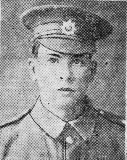
Samuel Robert Nesbitt, Lance Corporal, 3/12065, South Wales Borderers. Samuel was born in Tenby in 1887, the son of Samuel Robert Nesbitt, a soldier from Liverpool, and Alice Ann Nesbitt (nee Jenkins), a domestic servant from Laugharne. Alice died just after Samuel’s birth, whilst his father died of pneumonia whilst based on Guernsey in 1889, leaving Samuel and his elder brother Joseph orphaned. With no surviving family left in Laugharne, Samuel and Joseph were raised by Thomas and Susan Williams in Tenby. By 1911 Samuel was working as a groom at The Heath, Cardiff, then by 1913 he had moved to 54, The Watton, Brecon, where he had found work as a groom. On 27 April 1913 Samuel married Lilian Rose Eldred of Brecon and the couple had two daughters over the coming years. Samuel enlisted into the South Wales Borderers at Brecon on 28 October 1914, stating that he had four years prior service with the Pembroke Yeomanry, and was initially posted to the 3rd Battalion, South Wales Borderers. On 20 September 1915 he was posted to the 50th Provisional Battalion, then on 30 December 1916 was drafted to France, joining the 2nd Battalion, South Wales Borderers, which was on the Somme, attached to 87 Brigade, 29th Division. Within weeks of his arrival, Samuel was hospitalised, suffering from scabies and eczema, commonplace in the trenches, and by the time he re-joined the battalion, the division had moved to the Arras sector. Samuel would have then taken part in the ferocious assault carried out by the division against Monchy-Le-Preux, during the Battle of Arras, but soon afterwards scalded himself whilst cooking at the officers mess, during a brief respite out of the line. Samuel was treated at Arras before being sent to the 2nd Australian General Hospital at Wimereux, where he was found to be suffering from phthisis. He was sent back to England for treatment at a Military Hospital at Endells Street, London, but with no antibiotics available to cure his condition at that time, he was discharged from the army as medically unfit on 18 September 1917 and returned home to Brecon. Samuel’s health continued to deteriorate after being discharged and he died of phthisis at Brecon on 15 January 1921. The 35-year-old was buried in Brecon Cemetery. His widow, Lily, also lost her brother, Bertie Eldred in 1920, as a result of sickness contracted during the war. Samuel is not commemorated on the Brecon war memorial.
William Eustace Palk, DFC, Lieutenant, Royal Air Force. William was born in Birmingham in 1895, the son of Thomas Palk and Frances Palk (nee Broadhead). The family came to Brecon when Thomas was given the position of Governor of Brecon Prison, and set up home at The Governor’s House, in Brecon. He was educated in Handsworth Grammar School, Birmingham and then at Brecon County School, where he gained renown for saving a boy from drowning and received a Certificate from the Royal Humane Society. On leaving school, William found work at Messrs. Nott & Co. Motor Engineers. He enlisted into the 1/1st Brecknockshire Battalion, South Wales Borderers in September 1914. The battalion was attached to the Welsh Division and moved to Pembroke Dock upon mobilisation. It was then withdrawn from the Division and on 29 October 1914 sailed from Southampton for Bombay, where the battalion transhipped and sailed for Aden, arriving on 16 December 1914. The battalion endured a torrid time in the heat of Aden, losing several men to heatstroke. In August 1915 the battalion moved to India on garrison duties. William was then attached to a Wireless Signal Squadron in the Royal Engineers and saw active service in Mesopotamia in 1916. In May 1917, William transferred to the Royal Flying Corps and after gaining his pilot’s certificate, was commissioned as Second Lieutenant in January 1918, before being posted to 46 Squadron in France. The squadron was a fighter unit, which operated Sopwith Camels as part of No. 80 Wing RAF, at Serny, Pas-de-Calais. The wing specialised in large scale attacks on enemy airfields, but during October and November 1918 was heavily involved in attacks as the Germans were driven back towards the Hindenburg Line. William’s talents as a pilot were so noticeable, that after only 27 hours of operational flying, he was recommended for the award of the Distinguished Flying Cross. The citation for the award was published in the London Gazette of 7 February 1919 and read: ‘On 4th November 1918 after bombing enemy troops and transport, this officer attacked, from a very low altitude, two companies of enemy infantry, turning their orderly retirement into a rout. On numerous occasions the damaged state of his machine has born testimony to his boldness in pressing home his attack on various ground targets.’ He was decorated by King George V at Buckingham Palace in July 1919. Sadly the gallant airman was killed in a motorcycle accident near Gilwern, whilst returning to Brecon from playing in a football match for Hereford Thistle Football Club on 27 August 1921. The 26-year-old was buried in St. David’s Cemetery, Brecon. William is not commemorated on the Brecon war memorial.
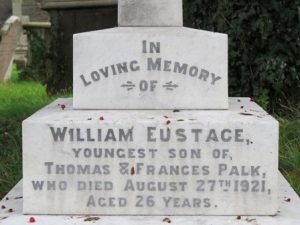
David Evan Parry, Gunner, W/3360, Royal Field Artillery. David was born on 8 September 1883, the son of James Parry and Jane Parry (nee Williams), of 9, Mill Street, Brecon. David left home as a young man and by 1911 was lodging at Llansamlet, where he worked as a railway platelayer. He enlisted at Swansea into the Welsh Divisional Royal Field Artillery soon after the outbreak of war and was posted to North Wales to begin his training. The 43rd (Welsh) Division had been formed as part of a planned Welsh Army Corps for the ‘New Army’, but recruitment was difficult, so just the one Welsh division was formed for the New Army, which was renumbered to the 38th (Welsh) Division, before it eventually embarked for France in December 1915. The division moved to the Nursery Sector near Fleurbaix for trench initiation alongside the Guards Division. The Division then held a sector of the line near Cuinchy before marching south to the Somme sector in June 1916 to take part in the assault on Mametz Wood. The first attack on the wood was launched on a two-battalion front on 7 July, but failed, and the Divisional Commander, Sir Ivor Philipps, was replaced before the Division attacked again on a two Brigade front on 10 July 1916. After two days of ferocious hand-to-hand fighting, the wood was cleared up to its northern edge, before the battered Division was relieved. David was wounded during the artillery battle for the wood and was evacuated to the massive casualty clearing station at Heilly, in the Somme Valley, where he died of his wounds on 18 July 1916. The 32-year-old is buried in Heilly Station Cemetery, Somme, France.
Charles James Robert Pawley, Private, 123633, Machine Gun Corps. Charles was born at Hempton, Norfolk on 23 February 1886, the son of Robert Pawley and Harriett Pawley (nee Lake). The family had moved to Middlesbrough by 1891 where Robert had gained work as a labourer in a steelworks, but by 1901 the family had returned to Norfolk. By 1911 Charles was lodging at 31, The Watton, Brecon, where he was working as a baker. He enlisted at Swansea into the Army Service Corps but was then posted to the 104th Training Reserve Battalion, at Edinburgh. Charles married Annie Elizabeth Price, of Brecon, whilst home on leave on 21 June 1917. Their only child, a son William, was born the following spring. After re-joining his unit, Charles was posted to the 267th Machine Gun Company. The unit sailed from Southampton for France on 13 January 1918 and disembarked at Le Havre, before entraining for Villers-Saint-Christophe, a small village north of the River Somme, near Ham, and then marched to billets at Foreste, where it joined the 61st (South Midland) Division. The machine-gunners began work constructing new gun emplacements and dug-outs over the coming weeks, then in February, during the re-organisation of the British Army, was redesignated as the 61st Battalion, Machine Gun Corps. Unbeknown to the men, this sector was to be hard hit within the coming weeks, as the Germans had been preparing to launch a massive offensive, along a section of the Western Front running south from Croisilles to La Fère. At dawn on 21 March 1918 the Germans opened up a terrific artillery barrage upon this front, shelling the British lines and the area immediately behind, then followed up the barrage with an assault by highly trained Stormtroopers. The 61st Division was hit by three enemy divisions, yet managed to hold its position during the first day, despite suffering terrible casualties. The Germans withdrew here for the night, then on the following morning, 22 March 1918, renewed their attack upon the divisional front. Charles was one of many men of the division killed in action during the day, as the machine-gunners gallantly maintained their fire until over-run. The 32-year-old has no known grave and is commemorated on the Pozieres Memorial, France.
Arthur George Payne, Sergeant, 7235, South Wales Borderers. Arthur was born in Portskewett, Newport in 1884, the son of George Payne and Elizabeth Payne (nee Haynes). The family had moved to Abertillery by 1901 and Arthur worked there with his father as a coalminer. Arthur enlisted into the South Wales Borderers at Brecon on 31 December 1901 and was posted to the 2nd Battalion, South Wales Borderers. He was stationed with the battalion in the south of England when he met his future wife, Alice Parsons, and married her at Farnborough on 26 June 1908. He must have been posted back to the Barracks at Brecon then, as their first child, Reginald, was born there on 15 March 1909. By 1911 Arthur was serving with the 2nd Battalion, South Wales Borderers in South Africa. Alice, by then pregnant with their second child, went back to her parents and gave birth to their daughter, Barbara, on 10 June 1911. A third child, Arthur George Payne, was born overseas. In October 1912 Arthur sailed from South Africa with his battalion to China. The battalion was in Tientsin, China at the outbreak of war and took part in a famous operation with the Japanese against the German held port of Tsingtao on 23 September. Arthur became one of just thirteen men of the battalion killed during the ensuing Siege of Tsingtao, when he was killed on 5 November 1914. The 30-year-old has no known grave and is commemorated on the Sai Wan Memorial in Hong Kong. Arthur is not commemorated on the Brecon war memorial.
Edgar Pearce, Private, 4/9946, Durham Light Infantry. Edgar was born on 7 June 1886, the son of Charles Pearce and Annie Pearce (nee Jones), of 46, The Struet, Brecon. He worked as a fitters labourer for the Midland Railway Company at Brecon prior to the war. Edgar enlisted into the 4th Battalion, Durham Light Infantry at Ferndale on 1 September 1914 and joined the battalion on the Tyne Defences. He embarked for France on 24 August 1915 and was posted to the 2nd Battalion, Durham Light Infantry, which was attached to 18 Brigade, 6th Division and was holding the Canal Bank sector at Ypres. Edgar joined the battalion at Potijze, where the men were resting after a spell in the trenches. The battalion then marched to billets at Poperinghe, to enjoy a week out of the line. The division held this sector over the coming months, its infantry battalions carrying out the by now routine spells of four days in reserve, four in support, and four in the front line. The men were worked hard at all times, carrying out trench and walkway repairs as well as providing carrying parties and often carried out patrols and trench raids into No Man’s Land. On 18 November the 2nd DLI moved out of the line for a rest and went into billets at Houtkerque before moving back into positions on the Yser Canal Bank by 5 December, where the usual routines of rotating in the trenches began once more. On the night of 15 December, the 2nd DLI moved back into the front line to begin a routine tour in the trenches. At 05.30 on the morning of 19 December 1915 the Germans opened up a barrage of phosgene gas shells upon the battalions’ positions, which carried on for several hours. Edgar was struck in the head by a piece of shrapnel from one shell and mortally wounded. He was carried by stretcher-bearers to the nearby 18th Field Ambulance post, where he died of wounds soon afterwards. The 29-year-old is buried in Hop Store Cemetery, Belgium.
Frederick John Pearce, Private, 15095, Oxfordshire and Buckinghamshire Light Infantry. Frederick was born on 3 October 1897, the son of Frederick Pearce and Alice Pearce (nee Jenkins), of 54, The Struet, Brecon. Frederick enlisted at Swansea into the 7th Battalion, Oxford and Buckinghamshire Light Infantry soon after the outbreak of war and joined the newly formed battalion at Oxford, just prior to its move to Codford St. Mary, to join 78 Brigade, 26th Division. Frederick embarked with his battalion on 21 September 1915 and the entire 26th Division concentrated at Guignemicourt, west of Amiens. After just a brief spell on the Western Front, the Division was selected to become part of a combined Anglo-French force to be sent to Salonika, to help the Greeks guard their frontier with Serbia, following the invasion of the latter by a combined Austro-Bulgarian force. On 26 December 1915 units began to move from Lembet to Happy Valley Camp, and all units were in place there by 8 February. The Division then took part in its first major action, the Battle of Horseshoe Hill, between 10-18 August 1916, which resulted in a stalemate. The next major action was during the Battle of Doiran between 24-25 April and 8-9 May 1917. Frederick was posted as missing during the latter battle and was later declared as having been killed in action on 9 May 1917. The 24-year-old has no known grave and is commemorated on the Doiran Memorial, Greece. A younger brother, Charles Miall Pearce, was killed in Normandy in 1944.
Thomas William Perry, Lance Corporal, 38230, Royal Welsh Fusiliers. Thomas was the son of James and Ellen Perry, of 25, Noble Street, Clerkenwell, London. He worked as a carman prior to enlisting into the 6th (Volunteer) Battalion, Middlesex Regiment (Militia) as a young man, then on 5 January 1906 applied to join the South Wales Borderers. Thomas was then posted to the Barracks at Brecon for training, before being posted to the 1st Battalion, South Wales Borderers at Tidworth. In January 1907 Thomas embarked for India with the battalion and served there for three years before the battalion returned to Britain, moving to barracks at Chatham. During 1912 he spent eight months on hospital duty, where he trained as a stretcher bearer and medic. He was then posted back to Brecon, to join the 3rd SWB and it was during this period that Thomas met his future wife, Elizabeth Davies. Following the outbreak of war, Thomas remained at Brecon, but following the arrival of the 2nd SWB back in Britain from China, Thomas entrained for Rugby to join its ranks. The battalion had joined 87 Brigade, 29th Division upon its arrival back home. On 17 March 1915 the battalion sailed from Avonmouth with the Division, arriving at Alexandria on 29 March, before moving to Mudros. On 25 April 1915 the Division landed at Cape Helles, Gallipoli, as part of the original landing force which had been despatched to try and seize the Dardanelles Straits and force Turkey out of the war. The invasion forces failed to break the Turkish defences and the campaign became bogged down. Thomas was wounded in the head by gunshot soon after the landings and was treated aboard a Hospital Ship offshore before making the slow journey back to Britain via Malta. After recovering from his wounds, Thomas returned to Brecon, where he married Elizabeth on 9 September 1915 and the couple set up home at 40, Walnut Square, Llanfaes. Their only child, Baden Thomas William Perry, was born at Brecon the following year, but sadly died in infancy. On 26 October 1915 Thomas was transferred to the 2nd Garrison Battalion, Royal Welsh Fusiliers, after being deemed as unfit for infantry duty. He then embarked for Egypt with the battalion at Devonport on 6 March 1916, disembarking at Alexandria ten days later. The battalion was then put to work on garrison duties in Egypt for the remainder of the war. Thomas unfortunately became ill less than two weeks prior to the Armistice and was hospitalised at Sollum. He died there of pneumonia on 4 November 1918. The 30-year-old was buried in Alexandria (Hadra) War Memorial Cemetery, Egypt. Thomas is not commemorated on the Brecon war memorial.
William Henry Ernest Pettifor, Private, 67638, Cheshire Regiment. William was born in Lamesley, Durham in 1899, the son of Richard Edward Pettifor and Catherine Pettifor (nee Forster). The family had moved to Wales by 1901 after Richard had gained a position as gardener at Treberfydd House, then in about 1912 the family moved to 3, Castle Street, Brecon. Upon leaving school at Brecon, William joined the Civil Service, but on 12 April 1917 left his job to enlist at Carmarthen into the 62nd Training Reserve Battalion. He joined the battalion at Kinmel Park, where it was being used for training young soldiers prior to them being drafted overseas. William embarked at Southampton for France on 31 March 1918, joining the Infantry Base Depot at Rouen. On 9 April 1918 he was posted to the 15th Battalion, Cheshire Regiment, which was attached to 105 Brigade, 35th Division and was rebuilding at Bouzincourt following heavy losses during the opening phase of the German Spring offensive on 21 March. By the time William joined the battalion, the Germans had switched the focus of their offensive further north, in Flanders, so the Somme front became bogged down into the usual routines of static trench warfare. William was accidentally wounded whilst at work with a wiring party at Bouzincourt on 12 June 1918, being shot in the leg and suffering a fractured femur. He was evacuated to the 3rd Casualty Clearing Station at Gézaincourt where he became so ill that he could not be moved to be sent to hospital. Sadly William died of his injuries sixteen days later, on 28 June 1918. The 19-year-old was buried in Bagneux British Cemetery, Gézaincourt, France. William is not commemorated on the Brecon war memorial.
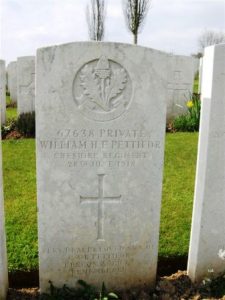
John Douglas Phelan, Bugler, PO/16860, Royal Marine Light Infantry. John was born at Brecon on 4 May 1899, the son of John Phelan and Ellen Alice Phelan (nee Chant). His father, an Irishman, was serving with the Royal Garrison Artillery and had married his mother whilst based at Gosport as a young man, before being posted to Brecon. The family lived at Brecon for three years before moving to Garndiffaith, Newbridge and back to Gosport. John enlisted at Gosport into the Royal Marine Light Infantry on 14 May 1913 and after passing out was posted to their Portsmouth Division. He had his first sea posting aboard HMS Topaze on 13 July 1914, before being posted aboard the battlecruiser HMS Invincible on 3 August. Invincible had been hurriedly refitted with war looming, and the work was incomplete when she joined the 2nd Battlecruiser Squadron. Her first action was as part of Admiral Beatty’s battlecruiser force during the Battle of Heligoland Bight on 28 August 1914. Invincible was then sent as flagship of a squadron despatched to the South Atlantic, to reap vengeance upon the German East Asia Squadron, commanded by Vice-Admiral Graf Maximilian von Spee, and took part in a mighty sea battle off the Falkland Islands on 8 December 1914, whish saw Spee’s squadron decimated. Invincible then underwent repairs at Port Stanley before heading for Gibraltar, for further repairs. Following a lengthy refit, where John remained aboard her, Invincible joined the 3rd Battlecruiser Squadron. At the end of May 1916, the 3rd Battlecruiser Squadron was temporarily assigned to the Grand Fleet for gunnery practice, however on 30 May, the entire fleet put to sea following reports that the German High Seas Fleet was heading into the North Sea. The two great fleets met off the coast of Jutland on 31 May 1916 and the greatest naval battle in history ensued. Invincible was more than holding her own in the great battle which followed and had inflicted heavy damage on several German ships, before a German shell penetrated her armour and set off a cataclysmic explosion in her magazines, tearing the ship in two. Only six men out of almost 1,000 crew were saved. John was just 17 years old when he was killed at Jutland on 31 May 1916. He has no known grave but the sea, so is commemorated on the Portsmouth Naval Memorial, Hampshire. John is not commemorated on the Brecon war memorial.
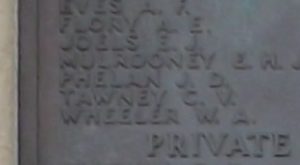
Charles Richard George Phillips, Private, 200950, South Wales Borderers. Charles was born at Sydenham, London on 22 June 1896, the son of William Phillips and Louisa Phillips (nee Colwill). His father died when he was young, so his mother took in two lodgers at their home at 1, Stanton Terrace, Kent House, Sydenham: Frederick John Bather and Benjamin Morris Bather. The Bather brothers were the sons of John Bather and Annie Bather, and following the death of their father John, moved back to their mothers native Brecon, bringing Charles Phillips with them. Their mother Annie then became known as Charles’ foster mother. Charles enlisted at Brecon into the Brecknockshire Battalion, South Wales Borderers on 26 January 1915. Upon completing his training, he was drafted to France, joining the 2nd Battalion, Monmouthshire Regiment, but after only a few months at the front his health broke down after being gassed and he returned to Britain before being discharged from the army as medically unfit on 10 March 1917. Charles returned to Brecon and began working as a bootmaker, which had had done prior to the war. Sadly his health continued to wane and Charles died as a result of his gas wounds, probably tuberculosis, at Brecon on 24 April 1920. The 23-year-old was buried in Brecon Cemetery. Charles is not commemorated on the Brecon war memorial.
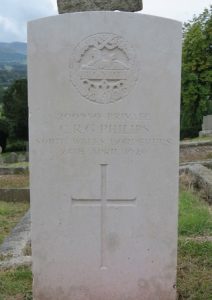
George Rhys Phillips, Private, 38925, Lincolnshire Regiment. George was born on 10 August 1897, the son of James Henry Phillips and Hannah Maria Phillips (nee Robbins), of 6, White Lion Terrace, Llanfaes, Brecon. George enlisted at Brecon into the army in about 1916 and after completing his training was drafted to France, joining the 1st Battalion, Lincolnshire Regiment. The battalion was by then attached to 62 Brigade, 21st Division and had been in France since August 1914, having originally been attached to the 3rd Division. It had been transferred to the 21st Division to bolster its strength, as the inexperienced division had been thrown into the deep end at the Battle of Loos, just weeks after landing in France. The division then took part in the Somme offensive in the summer of 1916, fighting throughout the entire battle, until its final throes at Le Transloy just as winter was setting in. In March 1917 the division followed the German Retreat to the Hindenburg Line, and in April fought at the Battle of Arras, seeing terrible fighting around Bullecourt. Later in 1917 the division moved to Ypres, and took part in the Battle of Polygon Wood, the Battle of Broodeseinde and the Second Battle of Passchendaele, before moving back south again, to take part in the Battle of Cambrai. The division wintered in the Cambrai sector and was holding the line near Heudicourt when the Germans launched their Spring Offensive on the Somme on 21 March 1918. The Allied line was hit by an overwhelming German artillery barrage at around 04.00 that morning. Mixed with the high explosives were gas and smoke shells, which lifted onto the rear areas soon afterwards, opening the door for the highly trained German stormtroopers to attack. The 1st Lincolns were almost annihilated during the terrible fighting that day. George was taken prisoner by the Germans during the attack and was taken to a prisoner of war camp at Kassel, in Germany. He died of his wounds there in captivity on 5 August 1918. The 20-year-old was buried in Niederzwehren Cemetery, Kassel, Germany.
Albert John Price, Private, 368420, Royal Army Medical Corps. Albert was born in 1883, the son of William Robert Price and Anna Maria Price, of 6, Orchard Street, Llanfaes, Brecon. After leaving school, Albert lodged at 102, Commercial Street, Tredegar, where he worked as a clothier and outfitter. He enlisted at Swansea into the 3/3rd Welsh Field Ambulance, Royal Army Medical Corps on 9 October 1915, giving his home address as 29, Bellevue Street, Swansea. Albert then married Mary Jane Burch, of Tredegar, at Swansea on 21 December 1915. Albert was then posted to Bedford to join the 68th (2nd Welsh) Division, but must have felt the need to see action, as he signed up for overseas service, before embarking for France on 3 June 1917, joining the 55th Field Ambulance, Royal Army Medical Corps at Coigneux. The unit was attached to the 18th (Eastern) Division and was in the Arras Sector when Albert arrived. At the beginning of July the division was relieved from Arras and entrained for the Ypres Salient, reaching Poperinghe soon afterwards before going into camps in the Wippenhoeke area. The 55th Field Ambulance set up at several locations by 7 July and began to prepare for the forthcoming Passchendaele offensive. By 25 July the division had moved in support of the 30th Division in the Zillebeke Sector and the 55th Field Ambulance set up again, ready to receive wounded when the great offensive opened on 31 July 1917. The 18th Division saw heavy fighting at Ypres over the coming months, and all its medical personnel were kept very busy, in dire conditions. Albert was wounded whilst operating as a stretcher bearer at some time between 9 and 10 October and was evacuated to the 3rd Canadian Casualty Clearing Station at Remi Sidings, where he died of his wounds on 12 October 1917. The 33-year-old was buried in Lijssenthoek Military Cemetery, Belgium.
Alfred Evan Price, Private, 119961, Machine Gun Corps. Alfred was born at the Barracks in Brecon on 9 July 1898, the son of Thomas Edward Price and Catherine Amelia Price. His father was from Montgomeryshire and was a serving private with the South Wales Borderers. Alfred was raised in Brecon but by 1911 had been sent away to school in Castleknock, Dublin. He enlisted at Dublin into the South Wales Borderers some years prior to the outbreak of war and was posted back to Brecon for training. Alfred then joined the 2nd Battalion, South Wales Borderers. The battalion was in Tientsin, China at the outbreak of war and took part in a famous operation with the Japanese against the German held port of Tsingtao on 23 September. On 4 December the battalion embarked at Hong Kong and landed at Plymouth on 12 January 1915, entraining for Rugby to join 87 Brigade, 29th Division. On 17 March 1915 the battalion sailed from Avonmouth with the Division, arriving at Alexandria on 29 March, before moving to Mudros. On 25 April 1915 the Division landed at Cape Helles, Gallipoli, as part of the original landing force which had been despatched to try and seize the Dardanelles Straits and force Turkey out of the war. The invasion forces failed to break the Turkish defences and the campaign became bogged down, so after an arduous eight months on the Peninsula the 29th Division was evacuated to Egypt on 11 January 1916, before being transferred to the Western Front, landing at Marseilles on 15 March and entraining for the Somme sector, taking up positions near Beaumont Hamel, facing Y-Ravine. The Division had an arduous time here too over the coming months, before taking part in a suicidal assault on 1 July 1916, on the opening day of the Somme offensive. The 2nd SWB alone suffered some 384 casualties on that day alone. Although severely depleted, the Division remained in the line here over the coming weeks, in trying conditions. Alfred must have been invalided home at some time, and upon recovering was transferred to the 18th Battalion, Machine Gun Corps. The battalion formed in France on 19 February 1918, attached to the 18th (Eastern) Division in the St. Quentin sector. Upon its formation the battalion took over positions in the line at Villequier-Aumont, south-east of Ham. On 21 March 1918 the division was hard hit when the Germans launched their great Spring offensive, along the section of Western Front running south from Croisilles to La Fère and became caught up in ferocious fighting over the coming days, being forced to carry out a strategic withdrawal. Most of the battalions’ machine-guns were lost or destroyed during the fighting and many casualties were suffered before the division was ordered to withdraw to positions south of Amiens on 29 March. By 1 April the 18th Battalion had reached Boves, where new guns arrived, and set up defensive positions. Unfortunately, the Germans attacked Villers-Bretonneux on 4 April 1918 and the battalion was caught up again in fierce fighting, in an attempt to save the strategically important village. Alfred was killed in action during the fighting that day. The 19-year-old has no known grave and is commemorated on the Pozieres Memorial, France.
David Richard Price, Private, 15610, Monmouthshire Regiment. David was born on 10 October 1897, the son of Evan Price and Frances Price (nee Evans), of The Lamb Inn, The Watton, Brecon. By 1911 the family was residing at Gardener’s Cottage, Dinas, Brecon after his father had become head gardener at Ffynnonau. David enlisted at Brecon into the Monmouthshire Regiment soon after the outbreak of war and was drafted out to France during the early weeks of 1916, joining the 2nd Battalion, Monmouthshire Regiment. On 30 January 1916 the 2nd Monmouth’s were put on Lines of Communication, then on 1 May 1916 joined the 29th Division, which had arrived from Egypt, becoming the Divisional Pioneer Battalion. The Division suffered terrible casualties at Beaumont Hamel, during its assault on Y-Ravine on 1 July 1916 and, although severely depleted, the Division remained in the line here over the coming weeks, in trying conditions. David was wounded by shrapnel during the early stages of the Somme offensive but returned to duty soon afterwards. On 27 July the Division entrained for Flanders, detraining at Proven before relieving the 6th Division at Ypres. The Division held the line here over the coming weeks as it rebuilt its strength and the 2nd Monmouth’s worked hard on improving trenches and digging new communications trenches. The battalion then worked on the Menin Road, erecting elephant shelters, then on 4 October the Division was relieved and entrained south for the Somme once more, moving to Trônes Wood, before joining the latter stages of the Somme offensive. The Division wintered on the Somme, with the 2nd Monmouth’s working on road repairs around Montauban. During the early hours of 23 November 1916, the men of the 2nd Monmouth’s were in their billets at Montauban when the camp was hit by enemy artillery fire. Despite this, the men were put to work as usual, with parties of men digging a new trench from Ginchy. David was killed when his working party was hit by enemy shellfire later that day. The 19-year-old was buried in A.I.F. Burial Ground, Flers, France.
Jeffrey Price, Sergeant, 6, South Wales Borderers. Jeffrey was the son of Jeffrey Price and Margaret Price (nee Williams), of Beiliau Farm, Llanfihangel Nant Bran. He left home as a young man and lodged at 13, Bridge Street, Llanfaes, where he worked as an ironmonger’s clerk, then by 1911 was lodging along with his brother Thomas at 2, Rhyd Bernard Terrace, Brecon. Jeffrey enlisted at Brecon into the Brecknockshire Battalion, South Wales Borderers soon after the outbreak of war. The battalion was about to leave the hostile climate of Aden for India when Jeffrey embarked for the Middle East on 3 July 1915. The Brecknocks had endured a torrid time in the heat of Aden, losing several men to heatstroke. In August 1915 the battalion moved to India on garrison duties. Jeffrey then volunteered to transfer to Mesopotamia and was posted to the Signal Service Park and Depot at Basra. He had not been in Basra long when he contracted fever and died there on 30 September 1916. The 31-year-old was buried in Basra War Cemetery, Iraq.
William Garner Price, Private, 15447, South Wales Borderers. William was born in Clerkenwell, London in 1874, the son of Mary Price. His mother married Charles Lewis soon afterwards and William was raised as his stepson. William left home as a young man and made his way to Wales, finding work as a steam roller driver at Aberystruth. He married the widowed Ellen Hickey there in 1902 and the couple set up home at 91, Alexandra Road, Abertillery, where William found work as a builders labourer. By the time that war had erupted, the couple had moved to 62, Orchard Street, Llanfaes, Brecon. William enlisted at Brecon into the 5th Battalion, South Wales Borderers soon after the outbreak of war. The battalion formed at Brecon in September 1914, before moving to Park House Camp, near Tidworth to join 58 Brigade, 19th (Western) Division. In December 1914 the battalion moved to Basingstoke in billets, then on 10 January 1915 became converted to the Pioneer Battalion for the 19th Division. The Division completed its training at Bulford and Perham Down, before embarking for France and landing at Le Havre on 16 July 1915. The entire 19th Division then moved to the Nursery Sector at Calonne for trench initiation alongside the Dehra Dun Brigade. The infantry battalions of the division then began carrying out the usual routines of rotating in the trenches: four days in the front line; four in support; and four in reserve, interspersed with training regimes and carrying out working parties and trench raids. Just south, the British launched a great offensive around the town of Loos on 25 September 1915, and the 19th Division was ordered to attack from its positions at the same time, to attempt to draw enemy attention away from the main battle area. The assault was a disaster, and heavy casualties were suffered by the 19th Division for no gain. The following year the Division moved to the Somme, where it took part in the second wave of the attack on Ovillers-La Boiselle on 1 July, capturing the village at heavy cost. Carrying parties from the 5th SWB were utilised as stretcher bearers during the battle, bringing in the wounded from No Man’s Land, often under heavy fire. Other parties began work on digging new communication trenches, to connect up the newly gained positions with the old front line over the coming days. After a week of hard work, the 5th SWB enjoyed a brief rest before moving back into the battle zone and began work around Mametz Wood and Fricourt Wood. William was wounded at Fricourt towards the end of July and was evacuated to hospital at Rouen, where he died of his wounds on 1 August 1916. The 42-year-old is buried in St. Sever Cemetery, Rouen, France.
Alfred George Pritchard, Private, 18783, South Wales Borderers. Alfred was the son of John Pritchard and Margaret Ann Pritchard (nee Healey), of 7, Prospect Close, Brecon. His mother died in 1902 and his father remarried to Margaret Ann Jones, a widow, at Brecon in 1907. The family then moved to 41, The Struet, Brecon. Alfred had left home to work as a miner at Pontypridd as a young man and in 1913 married Annie Williams, of Glyntaff. He enlisted into the South Wales Borderers at Pontypridd early in 1915 and was drafted to France on 2 May 1915, joining the 1st Battalion, South Wales Borderers. The battalion was attached to 3 Brigade, 1st Division and was by then in the Neuve Chapelle area. Alfred joined the battalion in time to take part in the divisions assault during the Battle of Aubers Ridge on 9 May 1915, when it attacked alongside the Meerut Division. The attack of 3 Brigade was held up by a flooded ditch, which the men forded, before being hit by heavy machine-gun fire, and a large number of casualties were suffered before the survivors withdrew. Alfred was probably wounded at Aubers Ridge and was evacuated home, and upon his swift recovery was drafted to Gallipoli to join the 2nd Battalion, South Wales Borderers, which was attached to 87 Brigade, 29th Division. By the time that Alfred landed on the Gallipoli peninsula, the main fighting had ceased and the campaign had bogged down into the stalemate of routine trench warfare. The main worry for the men by now was sickness and disease, due to the insanitary condition of the trenches and with No Man’s Land full of bloated corpses, the result of months of fighting. Alfred contracted dysentery at Gallipoli soon after his arrival and he was evacuated by Hospital Ship to a Hospital at Malta. He died there of dysentery on 25 December 1915. The 21-year-old was buried in Pieta Military Cemetery, Malta. His step-brother, William Jones, died of wounds at Étaples in 1917; a cousin, Arthur Pritchard, died in 1918; and a cousin Philip Pritchard, was killed at Ypres in 1917.
Arthur Pritchard, Stoker, 3649S, Royal Naval Reserve. Arthur was born on 7 March 1886, the son of Thomas Pritchard and Rachel Pritchard of 6, Chapel Street, Brecon. Arthur had worked as a coalminer at Merthyr as a young man and had enlisted into the Welsh Regiment Militia there on 29 August 1903. He then moved to Swansea where he worked as a drapery assistant for Jenkin Rees Evans. Arthur enlisted in Swansea into the 8th Battalion, Welsh Regiment on 12 August 1914, but just two months later was discharged as having been deemed unlikely to become an efficient soldier. A week later, on 19 October 1914, he re-enlisted at Swansea into the Royal Naval Reserve, naming his brother John as his next of kin. Arthur was attached to the Swansea Division, and posted to HMS Vivid I, the Royal Naval establishment at Devonport, for training. Over the coming years he served aboard several vessels: HMS Talbot; HMS Vindictive; HMS Egmont; and then aboard HMS Talbot again, before being posted back to HMS Vivid on 28 November 1917. Arthur took ill just a month prior to the Armistice and died of pneumonia in the Royal Naval Hospital at Plymouth on 17 October 1918. The 34-year-old was buried in Ford Park Cemetery (Pennycomequick), Plymouth. His brother, Philip Pritchard, was killed at Ypres in 1917, whilst a nephew, Alfred George Pritchard, died at Malta in 1915.
Philip Pritchard, Private, 19976, Welsh Regiment. Philip was born in Llandeilo, the son of Thomas and Rachel Pritchard. The family moved to his father’s native Brecon soon afterwards and Philip became a bricklayer. Philip worked as a bricklayer’s labourer as a young man, and had a long history of crime, being imprisoned several times over the years for offences ranging from poaching to theft. After leaving prison he enlisted at Llandovery under the false name of Philip Richards into the 15th Battalion, Welsh Regiment, which was known as the Carmarthen Pals battalion, attached to 114 Brigade, 38th (Welsh) Division. On 2 December 1915 the battalion moved to France, and the entire Division moved to the Fleurbaix sector, where it was initiated into trench warfare. During June 1916 the Division marched south to the Somme, and on 7 July 1916 attacked Mametz Wood. The initial attack failed, and it was three days later, on 10 July, that a fresh attack was mounted. After two days of heavy hand to hand fighting within the wood, the Germans withdrew, and the battered Welshmen moved via Hébuterne to Boesinghe, on the Yser Canal, where it remained until launching its attack on Pilckem Ridge on 31 July 1917. Philip was killed during the lead up to the assault on Pilckem Ridge, whilst the 15th Welsh was holding the front line on 28 July 1917. The 44-year-old was buried in Bard Cottage Cemetery, Belgium. His brother, Arthur Pritchard, died at Plymouth in 1918, whilst a nephew, Alfred George Pritchard, died at Malta in 1915.
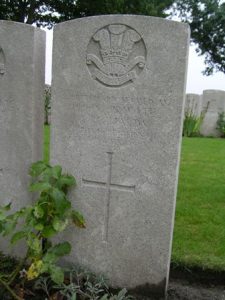
Charles Henry Prosser, Private, 25998, South Wales Borderers. Charles was born in Merthyr in 1896, the son of Robert Prosser and Catherine Prosser (nee Fifer). The family had moved to 41, The Struet, Brecon by 1899, but his father died in July 1900, so in 1902 his mother married Charles Price, and the family moved to 31, Silver Street, Llanfaes. Upon leaving school, Henry gained an apprenticeship as a railway wagon builder. He enlisted at Cefn-Coed into the South Wales Borderers in the summer of 1915 and after completing his training was drafted to France, joining the 2nd Battalion, South Wales Borderers. The battalion had fought in China and at Gallipoli during the early stages of the war and had moved to France from Egypt in March 1916 as part of 87 Brigade, 29th Division. The division took over positions near Beaumont Hamel, facing Y-Ravine. The Division had an arduous time here too over the coming months, before taking part in a suicidal assault on 1 July 1916, on the opening day of the Somme offensive. The 2nd SWB alone suffered some 384 casualties on that day alone. Although severely depleted, the Division remained in the line here over the coming weeks, in trying conditions. The Division was then pulled out of the line to rest and rebuild in the Ypres Salient, where it endured an arduous few weeks before being relieved again on 4 October and moved to billets at L Camp, Poperinghe. On 7 October the division marched to Hopoutre and entrained for the south, to take part in the latter stages of the Somme offensive, and by 10 October had reached Buire-sur-Ancre, before marching along the Bapaume Road to Fricourt prior to taking over a new sector at Gueudecourt on the evening of 19 October. The 2nd SWB took over Grease Trench during the night, relieving a battalion of the Hampshire’s. but suffered considerable casualties from enemy shelling during the relief. Charles was killed by shellfire during the early hours of 20 October 1916. The 19-year-old has no known grave and is commemorated on the Thiepval Memorial, France.
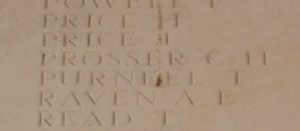
Alfred Gordon Quarrell, Private, 10969, Queens (Royal West Surrey Regiment). Alfred was born on 19 July 1896, the son of Alfred Quarrell and Ada Kate Quarrell (nee Greening), of Gardener’s House, Ffrwdgrech, Brecon, where his father worked as a gardener on the Ffrwdgrech Estate. His mother died in 1899 and the family moved to 34, High Street, Brecon, where his father had started his own business as a florist and fruiterer. In 1903 his father married Mary Margaret Jennett Probert, and the family then moved to 36, High Street. Upon leaving Brecon County School, Alfred was further educated at Colston School, in Bristol, before taking up a post as a trainee florist and nurseryman at the Wisley Horticultural Gardens, in Surrey. Alfred enlisted into the Queens (Royal West Surrey) Regiment early in 1915 and was drafted to France on 19 August 1915, to join the 6th Battalion, Queens (Royal West Surrey) Regiment, which was holding the line at le Touquet, in the Ploegsteert Wood Sector, attached to 37 Brigade, 12th (Eastern) Division. The division was relieved on 27 September and moved to Armentieres, preparatory to moving to the Loos Sector, to join the great offensive which had been launched there on 25 September. Alfred was wounded soon after the move to Loos and was evacuated back to Britain for treatment in a hospital in London. He returned to France in March 1916 to re-join the battalion. The 12th Division moved to the Somme in May and on 2 June 1916 took part in the attack on Ovillers. The division fought at Pozieres and Le Transloy before being moved to the Arras area during October 1916, where it remained over the winter, before taking part in the Battle of Arras in March 1917, helping to capture Roeux. The Division remained at Arras until taking part in the Battle of Cambrai in November 1917, then at the beginning of December moved to positions near Albert to rest. The Division relieved the 38th (Welsh) Division in the Fleurbaix front line in February 1918, but on 22 March was hurriedly moved back to the Somme sector to bolster the thinly stretched front line, following the launching of the German Spring offensive the previous day. The division suffered terrible casualties over the coming weeks before being relieved at the beginning of April, and moved to Toutencourt, where it rebuilt over the summer. On 1 July 1918 the Division carried out an attack at Bouzincourt but suffered heavily when the Germans counter-attacked. The division was relieved on 10 July and moved to positions south of the Somme, on Morlancourt Ridge. The coming weeks were relatively quiet, as the Allies built up their strength in readiness for a great offensive. On 12 August 1918 the 6th Queen’s were in the Morlancourt trenches when Alfred was mortally wounded by a German shell, a fragment of which hit him below the heart. He died within minutes whilst being carried to a nearby Aid Post. The 22-year-old was buried by his comrades in Morlancourt British Cemetery No. 2, France.
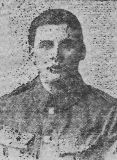
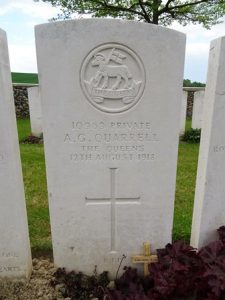
David John Rees, Private, 17827, Royal Welsh Fusiliers. David was born in Merthyr Tydfil on 24 April 1896, the son of William Rees and Elizabeth Rees (nee Harris), both of Brecon. By 1901 the family had moved to Cefn Cribwr, then by 1911 had moved back to 24, Silver Street, Brecon. David was educated at Llanfaes School prior to leaving home to work as a coal miner at Ystradgynlais. He enlisted at Bargoed into the Royal Welsh Fusiliers soon after the outbreak of war. He was drafted to France on 3 May 1915 and joined the 2nd Battalion, Royal Welsh Fusiliers, which was attached to 19 Brigade at Bois-Grenier. On 31 May 1915, 19 Brigade transferred to the 27th Division. The Brigade was then temporarily attached to the 2nd Division on 19 August, taking part in the Battle of Loos, and subsequent Action of Hohenzollern Redoubt, before joining the newly arrived 33rd Division on 25 November 1915. The Division endured a hard time during its first few months in the line, holding such notorious sectors as Cambrin and Cuinchy, where underground warfare was prevalent. On 22 June 1916 the Germans exploded a massive mine beneath the position held by B Company, 2nd RWF, which killed 54 men of the battalion, as well as trapping a number of British tunnellers underground. During the attempted rescue of one tunneller, a soldier of the 14th Welsh, Sapper Hackett was awarded the VC. At the beginning of June the 33rd Division moved out of the sector and began to move into the Somme area. By 16 July the 2nd RWF were bivouacked in the newly captured Mametz Wood, and moved to Bazentin-le-Petit two days later, to take part in the assault on High Wood. Battalion HQ set up in a deep dugout in Bazentin-le-Petit on 18 July whilst the battalion took over the front line. At 03.00 on 20 July the battalion came under heavy shellfire, which continued throughout the morning, and moved forwards into High Wood by 14.00 before launching an assault upon the German positions in the wood. David was killed in action in High Wood that day, 20 July 1916. The 19-year-old has no known grave and is commemorated on the Thiepval Memorial, France.

Ivor Rees, Private, 66147, Cheshire Regiment. Ivor was born on 27 September 1898, the son of Evan Rees and Ann Rees (nee Jones), of 70, The Struet, Brecon. He worked as a stonemason for Lewis Meredith prior to enlisting at Brecon into the army and was initially placed on the Army Reserve. Ivor was mobilised on 5 March 1917 and was posted to the 59th Training Reserve Battalion, which had been formed from the 13th Battalion, South Wales Borderers, and was at Kinmel Park. Ivor embarked for France on 19 January 1918 and after a brief spell at the Infantry Base Depot at Rouen, joined the 9th Battalion, Cheshire Regiment, which was in positions at Ribecourt, facing the Hindenburg Line in the Flesquières Salient, attached to 58 Brigade, 19th (Western) Division. Just after joining the battalion, the British reorganised the units in France and the 9th Cheshire’s transferred to 56 Brigade, in the same 19th Division on 7 February 1918. On 21 March 1918 the Germans launched the first of three offensives on to the section of the front running from Flesquières to St. Quentin, and the 19th Division was thrown into desperate fighting as it was pushed back over the coming days. The battered Division was then moved to the Messines sector to rest, but on 11 April became caught up in the second phase of the German offensive, which had been launched along the Lys Valley on 9 April, and again became caught up in desperate fighting around Kemmel. On 17 April 1918 the 9th Cheshire’s were holding the Kemmel Defences when the Germans opened up an intense artillery barrage upon their positions. Ivor was one of over thirty casualties suffered during the barrage when he was killed that day. The 19-year-old has no known grave and is commemorated on the Tyne Cot Memorial, Belgium.
David Richards, Lance Corporal, 17367, South Wales Borderers. David was born on 2 October 1891, the son of William Richards and Anne Richards (nee Rees), of the Drover’s Arms, 1, Newgate Street, Llanfaes, Brecon. His mother died on 1 December 1896 and by 1911 the family had moved to 6, Newgate Street, Brecon. David was by then working as a colliery labourer and living alone with his widowed father. David enlisted at Brecon into the 6th Battalion, South Wales Borderers soon after the outbreak of war. The battalion formed at Brecon in September 1914, moving to Codford to join 76 Brigade, 25th Division, before spending the winter in billets in Bournemouth. In February 1915 the battalion became the Pioneer Battalion to the 25th Division, before moving to Hursley Park and then to Tournay Barracks, Aldershot to complete its training. The battalion embarked for France and landed at Le Havre on 25 September 1915 before moving to the Vimy area with the Division, where they defended Vimy Ridge against a German attack in May 1916. They then moved to the Warloy area and attacked on 3 July near Thiepval. They fought throughout the Battle of the Somme, and then moved to Ploegsteert, where they held the line for the months leading up the Battle of Messines in June 1917. After fighting at Messines, the Division fought at the Pilckem Ridge, before moving south to the Arras Sector, taking up positions around Bullecourt in reserve. Here the Division was used to reinforce the badly depleted British units that were hit in the area by the German Spring Offensive of 21 March 1918. The Division then moved north to Flanders on the night of 30 March, where it took up positions at Ploegsteert again. On 9 April the Germans launched the second phase of their Spring Offensive along the Lys Valley, and the Division was caught up in the terrible fighting which ensued. The Division withdrew to Abeele to rest on 17 April, but on 25 April was ordered back into the line, and took part in the Second Battle of Kemmel. On 9 May the Division moved to Fismes, 20 miles south-east of Soissons in the Champagne, to give it a chance to rest and rebuild again. On 26 May the Division took up positions south of the Aisne, to guard against a predicted German Offensive. On the following morning, 27 May, the Germans hit the Division, and during the coming days the Division was virtually annihilated. The 6th SWB then transferred to the 30th Division, as the Divisional Pioneers. In August the Allies gained a huge victory over the Germans at Villers Bretonneux on the Somme, and from then on went on the offensive. The 30th Division, in Flanders, went on the offensive at the end of August and helped drive the Germans back towards Courtrai. After surviving the entire war, David came home on two weeks leave during October 1918, but sadly became ill and died of pneumonia in Brecon Military Hospital on 12 October 1918. The 26-year-old was buried with full military honours in St. Cattwg’s Churchyard, Llanspyddid.
Frank Northan Richards, Private, 12742, South Wales Borderers. Frank was born on 5 November 1885, the son of Frederick Charles Richards and Harriet Amelia Richards (nee Davies), of 15, Orchard Street, Llanfaes, Brecon. His fathers parents were from Laugharne. Frank worked as a carriage cleaner prior to enlisting into the Royal Navy on 5 November 1903 and was posted to Portsmouth for training. He served in the Royal Navy for the next twelve months, aboard HMS Northampton and HMS Cleopatra, before receiving a shore posting at HMS Victory. Frank then had a posting aboard HMS Duncan, but must had been injured in an accident as he was invalided out of the Royal Navy on 31 December 1904. He moved to Neath to find work as a coalminer, and married Elizabeth Annie Franks at Neath in 1908. The family set up home at 2, Duck Street, Neath, where four children were born over the coming years. Frank enlisted at Neath into the 4th Battalion, South Wales Borderers soon after the outbreak of war. The battalion formed at Brecon, before moving to Park House Camp, near Tidworth to join 40 Brigade, 13th (Western) Division, then moved to billets in Cirencester before moving to Woking in March 1915 for final training. On 29 June 1915 the Division sailed from Avonmouth for Mudros, before landing at Cape Helles, Gallipoli on 15 July 1915. Two weeks later the Division was moved to Anzac, to reinforce the Australian and New Zealand troops there, in readiness for a great assault on the Sari Bair Ridge, in conjunction with fresh Allied landings at Suvla Bay. The assault began on 6 August 1915 and raged over the coming days. The 4th SWB reached the Achyl Dere before assaulting, and seizing Damakjelik Bair, one of the ridges held by the Turks. The Turks counter-attacked on 9 August and terrible fighting raged throughout the day. Frank was killed in action during this fighting on 9 August 1915, being shot in the head and instantly killed. The 29-year-old was buried in Hill 60 Cemetery, Gallipoli. His brother, William Osmond Richards, was killed on the Somme in 1916, whilst his widow Elizabeth also lost a brother-in-law, Alfred James Edwards, of Cwmavon, killed at Ypres in 1917.
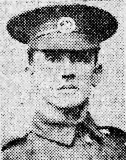
William Oswald Richards, Private, 11444, Royal Welsh Fusiliers. William was born on 22 January 1895, the son of Frederick Charles Richards and Harriet Amelia Richards (nee Davies), of 15, Orchard Street, Llanfaes, Brecon. His father’s parents were from Laugharne. William worked as a locomotive engine cleaner prior to the war. He enlisted into the Royal Engineers soon after the outbreak of war, but quickly transferred to the Royal Welsh Fusiliers, the same regiment as his eldest brother, Harry Alwin Richards. William was drafted to France on 4 December 1914, joining the 2nd Battalion, Royal Welsh Fusiliers. The battalion was attached to 19 Brigade and had taken part in the retreat to the Marne with the BEF. Following the Battles of the Marne and the Aisne, 19 Brigade moved to Flanders with the BEF, and eventually took over the La Boutillerie sector after becoming attached to the 6th Division. The Division then spent several months at Bois-Grenier, then on 31 May 1915, 19 Brigade transferred to the 27th Division. The Brigade was then temporarily attached to the 2nd Division on 19 August, taking part in the Battle of Loos, and subsequent Action of Hohenzollern Redoubt, before joining the newly arrived 33rd Division on 25 November 1915. The Division endured a hard time during its first few months in the line, holding such notorious sectors as Cambrin and Cuinchy, where underground warfare was prevalent. On 22 June 1916 the Germans exploded a massive mine beneath the position held by B Company, 2nd RWF, which killed 54 men of the battalion, as well as trapping several British tunnellers underground. During the attempted rescue of one tunneller, a soldier of the 14th Welsh, Sapper Hackett was awarded the VC. At the beginning of June, the 33rd Division moved out of the sector and began to move into the Somme area. By 16 July the 2nd RWF were bivouacked in the newly captured Mametz Wood and moved to Bazentin-le-Petit two days later, to take part in the assault on High Wood. The battalion suffered heavy casualties at High Wood and moved back into reserve at Buire-sur-L’Ancre until 6 August and then spent several days at Becordel before moving back into the line at High Wood on 18 August and helped beat off a German counter-attack. William was killed in action during the fighting that day, 18 August 1916. The 20-year-old has no known grave and is commemorated on the Thiepval Memorial, France. His brother, Frank Northan Richards, had been killed at Gallipoli the previous year, whilst their eldest brother, Harry, survived the war.
James Rimmer, Private, 482574, Labour Corps. James was born in Southport, Lancashire in 1888, the son of George Rimmer and Bettie Rimmer (nee Jones). He married Edith May Milner at Ormskirk in 1908 and the couple set up home at 48, Tithebarn Road, Southport, where James worked as a carter. By the time war broke out, the couple had moved to 42, Land Lane, Crossens. James enlisted at Southport into the 12th Battalion, The King’s (Liverpool) Regiment on 31 August 1914, stating that he had previously served for three years. He was discharged as medically unfit on 26 January 1915 due to having been diagnosed as suffering from cardiac disease. James later re-enlisted into the Royal Army Service Corps as a driver and served on the Western Front for almost two years until his health caused him to be sent home, and James was then posted to the 569th Company, Labour Corps, which was working on agricultural work in the Brecon area. Soon after arriving at Brecon, James began work as a haulier for the Breconshire Coal and Lime Co., and suffered a nasty accident near Llandefaelog in January 1918, when the horse he was leading bolted, and knocked him down, a cartwheel going over part of his body. He was conveyed by motor car to the Depot Hospital at Brecon where he recovered. He returned to work after recovering from his injuries, but ill-fortune was to follow him. On 17 April 1918 James was ploughing a field at Cerrigcochion, Brecon, when the Titan motor tractor he was driving slid down a slope into a hedge. James got off to clear some mud from the wheels of the tractor but got caught up in the flywheel and was thrown around, wounding his scalp, fracturing his hip and breaking an arm. He was conveyed to the Depot Hospital at Brecon again but died of shock soon afterwards that same day. The remains of the 30-year-old were conveyed back to his home, and he was buried in St. John Churchyard, Crossens, in Southport. James is not commemorated on the Brecon war memorial.
John Stanley Robinson, Lieutenant, Royal Navy. John was the son of Walter Stanley Robinson and Janet Robinson, of Malta. He was educated at St Paul’s School, London and Sidney Sussex College, Cambridge, before coming to Christ College in September 1911 to teach Mathematics. John proved to be a fully committed and popular teacher, who also coached cricket, hockey, golf and rugby, as well as being a member of the school Cadet Corps. During the Spring of 1916, John enlisted into the Royal Navy and became a Naval Instructor, gaining a temporary commission as Lieutenant, Royal Navy. He was then posted aboard the newly built Revenge-class battleship, HMS Royal Oak. Upon completion and commissioning, Royal Oak joined the Grand Fleet in time to take part in the Battle of Jutland, where her mighty guns were fired in anger for the first time. Royal Oak was then transferred to the First Battle Squadron and was deployed on several occasions following raiding parties by the German fleet. On 5 November 1918, in the final week of the First World War, Royal Oak was anchored off Burntisland in the Firth of Forth accompanied by the seaplane tender Campania and the light battlecruiser Glorious. A sudden gale caused Campania to drag her anchor, colliding with Royal Oak and Glorious. Both battleships suffered only minor damage, but Campania sunk. By now John had taken ill, contracting influenza. He was taken to the Royal Naval Hospital at South Queensbury, where he died of meningitis on 13 November 1918. The 30-year-old was buried in Queensferry Cemetery, Scotland. John is commemorated on the Christ’s College war memorial, but not on the Brecon war memorial.
Willie Ross, Captain, South Wales Borderers. Willie was born at Bradford on 16 October 1879, the son of William Ross and Ann Ross (nee Corlett). He left home as a young man to enlist into the South Wales Borderers and served in South Africa during the Anglo-Boer War of 1899-1902. Willie was a very capable soldier and during the coming years he rose slowly through the ranks. He was stationed at the Depot at Brecon when he married Mary Caroline Victoria Hooton, the daughter of Sergeant Major Samuel Hooton, on 28 September 1907. By 1911 Willie, now a Color Sergeant, was stationed in South Africa with the 2nd Battalion, South Wales Borderers, whilst his wife Mary was residing in the married quarters in the battalions barracks in South Africa. The battalion was in Tientsin, China at the outbreak of war and took part in a famous operation with the Japanese against the German held port of Tsingtao on 23 September. By now Willie had been promoted to Company Sergeant Major. On 4 December the battalion embarked at Hong Kong and landed at Plymouth on 12 January 1915, entraining for Rugby to join 87 Brigade, 29th Division. Willie was commissioned as Second Lieutenant into the 2nd SWB on 11 February 1915. On 17 March 1915 the battalion sailed from Avonmouth with the Division, arriving at Alexandria on 29 March, before moving to Mudros. On 25 April 1915 the Division landed at Cape Helles, Gallipoli, as part of the original landing force which had been despatched to try and seize the Dardanelles Straits and force Turkey out of the war. The invasion forces failed to break the Turkish defences and the campaign became bogged down, so after an arduous eight months on the Peninsula the 29th Division was evacuated to Egypt on 11 January 1916, before being transferred to the Western Front, landing at Marseilles on 15 March and entraining for the Somme sector, taking up positions near Beaumont Hamel, facing Y-Ravine. The Division had an arduous time here too over the coming months, before taking part in a suicidal assault on 1 July 1916, on the opening day of the Somme offensive. The 2nd SWB alone suffered some 384 casualties on that day alone. Although severely depleted, the Division remained in the line here over the coming weeks, in trying conditions. The Division was then pulled out of the line to rest and rebuild before moving back into the line and taking part in the latter stages of the Somme offensive. The Division wintered on the Somme, taking part in the advance which followed the German withdrawal to the Hindenburg Line. At the beginning of April, the entire 29th Division moved out of the Somme sector to the Arras sector, and by 9 April took over a section of the line facing Monchy-le-Preux. The Division then began to prepare for the forthcoming Battle of Arras. At dawn on 23 April 1917, the Division launched an assault on Monchy-le-Preux. The 2nd SWB captured the front-line German trench and advanced some 300 yards beyond before consolidating its gains. During the summer the division moved further north to Ypres, initially to hold the line whilst other units had been withdrawn for specialist training, in readiness for the Third Battle of Ypres, which opened on 31 July 1917. The 29th Division went into reserve whilst the first attacks, the Battle of Pilckem Ridge, took place, then on the night of 14-15 August the 2nd SWB moved into the line facing Langemarck, ready to launch another offensive. On the following day the battalion reconnoitred the ground in front of them, and laid white tapes in No Man’s Land, to guide the attacking troops, and at dawn on 16 August the 2nd SWB launched an attack on Langemarck. The battalion successfully took its two objectives but had suffered 163 casualties. Willie was among the men killed that day, 16 August 1917. The 38-year-old is buried in Artillery Wood Cemetery, Belgium.
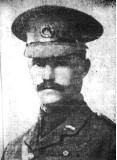
Thomas Edward Rowlands, Private, 114207, Machine Gun Corps. Thomas was born at Argoed Mill, Nantmel, Radnorshire in 1897, the son of Richard Rowlands and Mary Ann Rowlands (nee Worthing). His father was a miller, but had taken over the Crown Inn, at Rhayader after Thomas’s birth. Sadly his father died in 1906, so his mother moved with her young family to the King’s Head Inn, Kensington Place, Brecon by 1911, where she was the landlady. Thomas was educated at Brecon before becoming an apprentice for Nott and Co, Ironmongers. He enlisted into the Brecknockshire Battalion, South Wales Borderers in March 1915, and was posted to Pembroke Dock to join the 2/1st Brecknocks, which was at Dale. At the end of 1915 the battalion moved to Bedford to join the 68th (2nd Welsh) Division. Thomas was drafted to Egypt in 1917, joining the Machine Gun Corps. By February 1918 he was in France and joined the newly formed 30th Battalion, Machine Gun Corps, which was attached to the 30th Division. At the beginning of 1918 the Division was stationed near St. Quentin, and when the Germans launched their Offensive here on 21 March, the Division took part in the desperate Menin action across the Somme Crossings, and the Battle of Rosieres. The battered division was then pulled from the line to rest and rebuild, and moved to Flanders, but was caught up in the action again here when the Germans launched a fresh offensive along the Lys on 9 April. After a relatively quiet summer, on 8 August 1918 the Allies gained a huge victory over the Germans at Villers Bretonneux on the Somme, and from then on they were on the offensive. The 30th Division took part in the Advance in Flanders, which began at the end of the month, taking part in the final Battle of Ypres and in the Battle of Courtrai. Sadly Thomas took ill just after the Armistice and was sent to the 10th Casualty Clearing Station, where he died of influenza on 17 November 1918. The 21-year-old was buried in Tourcoing (Pont-Neuville) Community Cemetery, France.
Fred Russell, Private, 27811, South Wales Borderers. Fred was born on 20 January 1887, the son of Harry Russell and Annie Russell (nee Price), of Brecon. Following the death of their mother, Fred and his brother Arnold lodged with Rees Jones at Brecon before Fred enlisted into the South Wales Borderers. Prior to the war Fred had left the army and was lodging with his sister, Mrs William Williams, at 11, Church Terrace, Ystradgynlais. He re-enlisted at Llanfaes soon after the outbreak of war, joining the Brecknock Battalion, South Wales Borderers. He was temporarily transferred to the 6th Battalion, Devonshire Regiment. Both the Brecknocks and the 6th Devon’s were sent to the Middle East early in the war, the former to Aden and the latter to India and newspaper reports state that Fred embarked with the Brecknocks in October 1914, however his surviving records state that he embarked for India on 3 July 1915. He was then posted to the 4th Battalion, South Wales Borderers, which was attached to 40 Brigade, 13th (Western) Division and fought with the battalion in Mesopotamia. Fred was killed in action in Mesopotamia on 30 April 1917. The 30-year-old has no known grave and is commemorated on the Basra Memorial, Iraq.
Frank Sadler, Private, G/19126, The Buffs (East Kent Regiment). Frank was born in Droitwich in 1887, the son of Frank William Sadler and Emma Sadler (nee Sewell). His father was a schoolmaster and had moved the family to Oxfordshire just after the turn of the century, before finally moving to The Elms, Ramsgate. Upon leaving school, Frank joined the staff of Lloyds Bank and became a Bank Clerk at Cardiff. In June 1914 he transferred to the Brecon branch of Lloyds Bank and lodged in the town for twelve months before travelling to Cardiff to enlist into the Royal Fusiliers in June 1915. Early in 1916 Frank was drafted to France and was transferred to the 7th Battalion, The Buffs (East Kent Regiment, and posted to A Company. The battalion was attached to 55 Brigade, 18th (Eastern) Division and had been in France since May 1915. The division didn’t see its first major action until July 1916 when it took part in the Battle of Albert. It then fought at the Battle of Bazentin, where it captured Trônes Wood, and then took part in the terrible fighting for Delville Wood. In October the division took part in the Battle of the Ancre Heights, and captured Schwaben Redoubt, before assisting in the capture of Regina Trench. The division then fought at the Battle of the Ancre, and during the subsequent Operations on the Ancre, before spending the winter on the Somme. In March 1917 the division followed the German Retreat to the Hindenburg Line, then enjoyed a brief rest in Flanders before transferring to the Arras Sector in April 1917, to take part in the Third Battle of the Scarpe, which was part of the Arras Offensive. On 1 May 1917 the 7th Buffs moved into the front line at Neuville Vitasse, to relieve the 7th Queen’s and with orders to launch an attack. At just after midnight on 3 May 1917 the battalion moved into its assembly positions and at 03.45 the men climbed out of their trenches to mount the first of a three-wave attack. The first troops reached the eastern edge of the village of Cherisy, before being hit by an intensive German artillery barrage. Frank was killed in action at sometime during the days fighting. The 29-year-old has no known grave and is commemorated on the Arras Memorial, France. Frank is not commemorated on the Brecon war memorial.
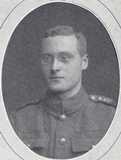
Henry St John Saunders-Jones, Lieutenant, Indian Army. Henry was born on 24 June 1895, the son of Reverend Saunders Jones, the Vicar of St David’s, Brecon, and of Mary Grace Jones (nee Thomas). He entered Christ College in September 1906 and appeared to be more interested in sports than studying. Henry left school in 1910 to train as a motor engineer with Messrs. Rich of Brecon. In September 1914 he enlisted into the Brecknockshire Battalion, South Wales Borderers as a Private. The battalion was attached to the Welsh Division and moved to Pembroke Dock upon mobilisation. It was then withdrawn from the Division and on 29 October 1914 sailed from Southampton for Bombay, where the battalion transhipped and sailed for Aden, arriving on 16 December 1914. The battalion endured a torrid time in the heat of Aden, losing several men to heatstroke. In August 1915 the battalion moved to India on garrison duties. Whilst in India his skills as a motorist made him a favourite with his CO, which helped Henry gain a commission as Second Lieutenant into the Indian Army on 15 November 1915. In July 1916 Henry became attached to the 21st Punjabis, before joining the 30th Punjabis in German East Africa in December 1916. He then took part in the British Advance on Rufigi. Henry was promoted to Lieutenant in June 1917. He left the regiment’s camp at Lindi on 25 July to reconnoitre the land in front of the enemy lines at Tandamuti Hill. On 3 August 1917 he led a column of troops through the thick African bush to attack the enemy. The Germans saw the approaching Indian troops and attacked themselves, surrounding them. Henry was badly wounded during the fighting and was last seen alive firing his revolver at the enemy. It was nine days later that his death was officially confirmed. The 22-year-old was originally buried on the battlefield, but after the war his grave was exhumed and he was re-interred in Dar Es Salaam War Cemetery, Tanzania. Henry is commemorated at Christ’s College, but not on the main Brecon war memorial.
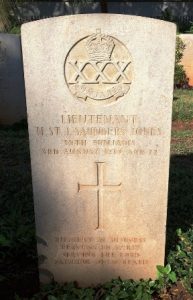
John Joseph Sessarago, Lance Corporal, 42136, South Wales Borderers. John was born in 1896, the son of John Sessarago and Emily Sessarago (nee Williams), of 65, The Struet, Brecon. The family ran their own pawnbrokers and second-hand store at The Struet, but his father died in 1911 and his mother in 1913, leaving John and his siblings to fend for themselves. John enlisted at Llandrindod Wells into the Hereford Regiment, before being drafted to France together with a large number of other men of the Herefordshire Regiment as reinforcements for the South Wales Borderers. John was initially posted to the Infantry Base Depot at Étaples before being posted to the 11th Battalion, South Wales Borderers. The battalion was attached to 115 Brigade, 38th (Welsh) Division and had suffered terrible casualties during the assault by the division upon Mametz Wood in July 1916. The division then took over a section of the front at Hébuterne before moving to the Ypres Salient and taking over the Canal Bank sector at Boesinghe. The infantry battalions of the Division then began carrying out the normal pattern of rotation in the trenches, four days in the front, four in support and four in reserve, whilst also working on trench improvement, digging new trenches, and carrying out regular patrols and trench raids. On 31 July 1917 the Division launched its famous assault on the Pilckem Ridge, capturing Iron Cross and reaching its objective of the Steenbeek, then played a supporting role in the Battle of Langemarck. The Division was transferred to the Sailly-sur-la-Lys sector in September, and remained in the area over the winter. At the beginning of February 1918, due to a lack of men, the British army on the Western Front reorganised and many battalions were disbanded, to allow their troops to be used to build up the complement of others. The 11th SWB disbanded on 6 February 1918 and John was among a number of men posted to its sister battalion, the 10th SWB, in the same 115 Brigade. The division was still in the Armentieres sector at Wez Macquart, but was moved to positions north of Albert, at Bouzincourt Ridge, at the end of March 1918, relieving the battered 2nd and 47th Divisions. By 7 April the 10th SWB had reached Toutencourt, then three days later marched to Warloy-Baillon, where it remained until moving into support trenches facing Bouzincourt Ridge on 16 April, to begin its first tour back in the Somme trenches. John was wounded by enemy shellfire here at the end of April and was evacuated to hospital at Doullens, where he died of his wounds on 30 April 1918. The 21-year-old is buried in Doullens Communal Cemetery Extension No. 2, France.
Alfred Thomas Tedstone, Private, 17976, The Sherwood Foresters (Notts & Derby Regiment). Alfred was born at Audlem, Cheshire in 1885, the illegitimate son of Lydia Thomas. His mother married David Henry Tedstone the following year, and the family moved to Hanley for two years before settling at New Radnor by 1891, where David worked as a saddler. Alfred’s mother, Lydia, died in 1894 and the following year his father married Martha Minton. David then gained a position as an insurance agent and moved his family to 10, park Street, Ledbury by 1901. Soon afterwards David gained the position as Superintendent of the Refuge Assurance Company at Brecon, so moved his family to 16, Alexandra Road, Brecon. Alfred left home as a young man after gaining work at Hayfield, Derbyshire, and soon after the outbreak of war enlisted at Chapel-en-le-frith, Derbyshire into the Sherwood Foresters as Alfred Thomas. Alfred embarked for France on 15 December 1915, to join the 11th Battalion, Sherwood Foresters, which was at Steenbecque, attached to 70 Brigade, 8th Division. Alfred became a specialist machine-gunner with the battalion upon his arrival. The 8th Division was holding the La Boutillerie sub-sector and wintered here before moving south to the Somme at the end of March 1916. The division then took part in the opening attacks of the Battle of the Somme on 1 July, seeing heavy fighting during its attack from the Albert to Bouzincourt line, where it was almost annihilated. The 8th Division was then forced to rebuild in the Ploegsteert Sector during the summer before moving south again, taking part in the latter stages of the Somme offensive before moving to the Ypres Salient for the winter, taking over positions near Hill 60. Alfred was among some thirty men wounded by German artillery fire upon the Hill 60 trenches on 1 June 1917 and was evacuated to hospital at Boulogne, suffering from shrapnel wounds to his arm and leg. He was then transferred to hospital in England for further surgery, and came back to Brecon on leave in August. By the time that Alfred had recovered and been posted back to France, the Battle of Passchendaele had begun and he was posted to the 17th Battalion, Sherwood Foresters, which was at Ypres attached to 117 Brigade, 39th Division. Alfred joined the battalion in trenches at Ridge Wood, where it was holding the Klein Zillebeke Defences. The division then moved to the Shrewsbury Forest sector and took part in the Battle of the Menin Road, before seeing heavy fighting around Polygon Wood. On 10 November 1917 the battalion was in the trenches near Chippewa Camp when it was hit by a salvo of German gas shells. Alfred was killed during the barrage that day. The 32-year-old has no known grave and is commemorated on the Tyne Cot Memorial, Belgium.
Arthur Thomas, Private, 3121, The Queen’s Royal West Surrey Regiment. Arthur was born in 1888, the son of William Mitchell Thomas and Elizabeth Maria Thomas, of 66, Standish Road, Hammersmith. He worked as a clerk prior to the war. Arthur married Etheldean May Gordon Gall at Dartford in 1916, just after having enlisted at Hammersmith into the 4th Battalion, Queen’s Royal West Surrey Regiment. He must have been medically downgraded, as late in 1917 he was posted to the 569th Agricultural Company, Labour Corps, his service number changing to 430680. The company was based in the Brecon area and provided labour to help local farmers who were suffering from a lack of manpower. Arthur was put to work on timber felling in the local forestries and became well known in the town due to his passion for preaching in the Calvinistic Methodist Chapel, and also in Sunday Schools, which he had done for many years whilst living in London. Unfortunately, he took ill early in October 1918 and was taken to the Depot Hospital at Brecon where he died of pneumonia on 28 October 1918. The 30-year-old was buried in Brecon Cemetery following a memorial service in Velindre. Arthur is not commemorated on the Brecon war memorial.
David Thomas, Sergeant, 200014, South Wales Borderers. David was born at Cwmcar, Llanddetty in 1887, the son of David Thomas and Mary Thomas. His father worked as a railway platelayer and by 1901 had moved the family to Machine House, The Watton, Brecon. David worked as a haulier at Brecon prior to the war and was a serving member of the Brecknockshire Battalion, South Wales Borderers, when war was declared. The battalion was attached to the Welsh Division and moved to Pembroke Dock upon mobilisation. It was then withdrawn from the Division and on 29 October 1914 sailed from Southampton for Bombay, where the battalion transhipped and sailed for Aden, arriving on 16 December 1914. The climate in Aden was fearsome, with scorching heat during the day, and with little to do, the men spent much of their free time playing football. By June 1915 the Turks had become overconfident due to the lack of any incursions by the British into Yemen and moved forward to reoccupy fortifications at Sheikh Saad. They then began to shell the island of Perim, so the Allied troops in Aden were mobilised into the Aden Movable Company and ordered to prepare to join with local troops. 400 men of the Brecknocks were allocated to the column, the remainder stayed in Aden. A small artillery column was built up to join it and on 3 July the force moved out to Sheikh Othman. Many men collapsed on the march, which was carried out during the full heat of the day, but by 7.30 pm the column had completed its six-mile advance. David embarked for the Middle East on 3 July 1915, the same day as this fatal march in the Aden desert, so luckily missed out on the misfortunes suffered by many of his friends and contemporaries. In August 1915 the battalion moved to India on garrison duties and remained there for the duration of the war. David returned home to Brecon with the Brecknocks in November 1919, but by now his health was failing. He became ill and died of pneumonia at the Brecon Infirmary on 15 May 1920. The 33-year-old was buried in Brecon Cemetery with full military honours. David is not commemorated on the Brecon war memorial.
Rees Thomas, Private, 37062, The King’s Own (Royal Lancaster Regiment). Rees was born in 1899, the illegitimate son of Mary Thomas, of Tybach, Libanus, Brecon. He was raised by his grandparents, Rees and Anne Thomas, at Bolgoed Maen, Libanus, Brecon. Rees was educated at Tairbull Council School and then at Brecon County Intermediate School before gaining work as a farm hand and went to live with his mother, who had become Mrs Mary Davies, at Pontlottyn. Rees enlisted into the army at Bargoed at some time in 1917 and after completing his training was drafted to France, where he was posted to the 8th Battalion, King’s Own (Royal Lancaster Regiment), which was attached to 76 Brigade, 3rd Division. Rees probably joined the battalion as it was rebuilding following heavy losses sustained during the German Kaiserschlacht offensive of 21 March 1918. The 3rd Division had been in the Wancourt area when the Germans attacked and were forced to slowly withdraw under intense pressure over the coming weeks, before being relieved and moving to Flanders. Unfortunately, the division was hit again when the Germans switched their attention to the Lys Valley on 9 April and the division became caught up in heavy fighting along the La Bassée Canal. In May the Germans switched their attention further south, to the Champagne region, so the 3rd Division enjoyed a relatively peaceful summer as it rebuilt its strength in the Chocques area. On 8 August the Allies enjoyed a great victory at Villers-Bretonneux and on 21 August went on the offensive along the Somme sector. By now the 3rd Division had been transferred south to join this great offensive, attacking from the area of Courcelles that day. Rees and his fellow comrades of the 8th King’s Own spent the following day collecting bodies from the battlefield, then at 22.00 that night moved into assembly positions, ready to attack on the following day. At 04.00 on 23 August 1918 the 8th King’s Own launched an assault against the strongly defended village of Gomiecourt. The attack was a success, with the village captured and 300 prisoners taken, but Rees was among six men and one officer killed from his battalion. The 19-year-olod has no known grave and is commemorated on the Vis-En-Artois Memorial, France.
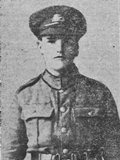
Edward James Tonge, Private, 77457, Royal Welsh Fusiliers. Edward was born in 1899, the son of William Tonge and Ellen Tonge (nee Evans), of Llanfihangel Talyllyn. The family had moved to 6, Bridge Street, Brecon by 1911 and Edward was in school in the town. Edward enlisted into the army as soon as he left school and was drafted to France in the summer of 1918, before being posted to the 2nd Battalion, Royal Welsh Fusiliers. The battalion had been in France with 19 Brigade for most of the war but in February 1918 had transferred to 115 Brigade, 38th (Welsh) Division. Edward joined the battalion on the Somme, probably in time to take part in the divisions opening assault of the great offensive on 21 August 1918. The opening assault, across the flooded Ancre valley, was led by 114 Brigade, who consolidated a bridgehead ready for the rest of the division to follow. On the following day 115 Brigade crossed the Ancre, securing their own bridgeheads, before the division assaulted Thiepval Ridge and advancing to Pozieres. Over the coming days the division advanced across the old Somme battlefields, taking Mametz Wood, Bazentin and Longueval before clearing High Wood and Delville Wood and pushing on towards Lesboeufs. On 1 September 1918 the 38th Division launched an attack from the direction of Lesboeufs against Morval and Sailly-Saillisel: 114 Brigade attacked Morval; whilst 115 Brigade assaulted Sailly-Saillisel. Edward was killed in action during the fighting that day. The 19-year-old has no known grave and is commemorated on the Vis-en-Artois Memorial, France.
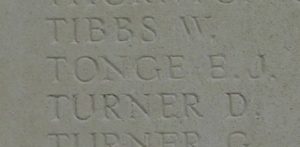
James Victor Trevelyan, Rifleman, S/23328, Rifle Brigade. James was born in Hackney on 1 August 1880, the youngest son John Edmund Trevelyan and Jane Trevelyan (nee Williams). His mother was from Brecon, the daughter of William Williams, so when her husband died in 1899, she moved with her children to 8, Lion Yard, Brecon, to live with her widowed mother. James worked as a private secretary at Brecon, but had moved back to London before 1911, when he was lodging with his eldest brother Eion at 37, Durham Road, Manor Park, Essex, and worked as a jewellers assistant at Oxford Street. By now James had an illegitimate wife, Mary Nightingale, of Preston, who gave birth to three sons and a daughter by him over the coming years. James enlisted into the Rifle Brigade at Lambeth on 12 December 1915 and was initially placed on the Army Reserve. He was mobilised on 20 June 1916, joining the Depot before being posted to the 6th Battalion, Rifle Brigade on 29 June for training. On 14 November 1916 James embarked for France at Southampton, initially joining the 8th Battalion, Rifle Brigade, which was attached to 41 Brigade, 14th (Light) Division. On 10 December James was attached to the 185th Company, Royal Engineers, remaining with them for over nine months before being posted to the 1st Battalion, Rifle Brigade, which was attached to 11 Brigade, 4th Division. The division had just moved to the Ypres Salient when James joined the battalion on 20 September and was preparing to join the battle for Polygon Wood. On 1 October the 1st Rifle Brigade relieved the 12th King’s Own in the front-line east-north-east of Langemarck and endured a torrid two days before taking part in an assault at 06.00 on 4 October 1917 upon a number of objectives north of Poelcapelle. James was killed in action during the fighting that day. The 37-year-old has no known grave and is commemorated on the Tyne Cot Memorial, Belgium.
Edwin Charles Trew, MM, Private, T/242015, The Buffs (East Kent Regiment). Edwin was the son of Thomas Edward Trew and Martha Elizabeth Trew (nee Thomas), of 13, Ship Street, Brecon. He entered Christ College in 1890 and left two years later to take up work as a Bank Clerk for Lloyd’s Bank in Stafford. By 1911 he was working at their Tamworth branch, and by the outbreak of war had transferred to Swansea. Edwin enlisted into The Buffs at Swansea on 10 December 1915 and spent just under two years on home service. He embarked for France on 21 September 1917, joining the 1st Battalion, The Buffs (East Kent Regiment), which was at Cite St. Pierre, attached to 16 Brigade, 6th Division. The Division had been chosen to take part in the forthcoming Battle of Cambrai, so on 15 November entrained for Péronne, before moving to positions by Bois Dessart. The Cambrai offensive began at dawn on 20 November 1917. The 6th Division, in the centre of the line, captured Ribécourt and Marcoing but when the cavalry passed through late, they were repulsed from Noyelles, but retook it two days later. The offensive had ground to a halt by 20 November and on 30 November the Germans launched a counterattack, recapturing most of the lost ground and forming a salient around Flesquières. By 7 December 1917 the line had stabilised, and the troops settled down for the winter and the 6th Division took over positions facing the Hindenburg Line at Bellacourt. Edwin was awarded the Military Medal for Bravery in the Field on 19 March 1918, for rescuing a wounded soldier from No Man’s Land whilst under fire. On 21 March the Division was hit hard when the Germans opened their Spring offensive, along a section of the front running south from Croisilles to La Fère, and the 6th Division, by then at Beugnatre, was hit hard, being forced into a fighting withdrawal over the coming days. The battered Division was relieved and moved north to Zonnebeke at the end of the month, then on 9 April the Germans opened the second phase of their offensive along the Lys, and the 6th Division was dragged into action once again. The fighting died down by the end of the month, as German attention turned to the Champagne sector and the 6th Division settled back into the normal routines of trench warfare. Edwin was wounded in the thigh by shrapnel whilst in the line at Dickebusch on 1 August and was evacuated to hospital at Esquelbecq, where he died of his wounds on 3 August 1918. The 42-year-old was buried in Esquelbecq Military Cemetery, France. His younger brother, Melville George Trew, had been killed at Ypres on 18 September 1917.
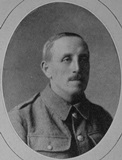
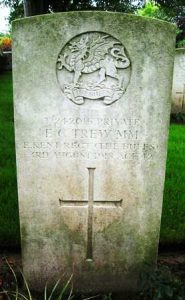
Melville George Trew, Private, 235417, Lancashire Fusiliers. Melville was the son of Thomas Edward Trew and Martha Elizabeth Trew (nee Thomas), of 13, Ship Street, Brecon. He had worked as a draper and then as a bookkeeper prior to the war. Melville enlisted at Brecon into the South Wales Borderers in June 1916, but after completing his training was drafted to France in the spring of 1917 and transferred to the 15th Battalion, Lancashire Fusiliers. The battalion was attached to 96 Brigade, 32nd Division and had just arrived at Zuydcoote, on the Belgian coast, when Melville joined its ranks. The division then took over a sector of the coastal defences near Coxyde. This sector was relatively peaceful, compared to the rest of the Western Front, but a potential offensive here had been planned if there was to be a breakthrough at Ypres. The Third Battle of Ypres, or Passchendaele, was launched on 31 July 1917, but the Allies failed to make any significant breakthrough, so the channel operation was called off and the sector continued in its state of stagnant trench warfare. On 18 September 1917 Melville’s battalion was holding dugouts in the Redan sector at Nieuwpoort when Melville was killed by enemy artillery fire. The 36-year-old was buried in Coxyde Military Cemetery, Belgium. His elder brother, Edwin Trew, died of wounds in France in 1918.
Ernest Frederick Tricker, Lance Corporal, 8322, South Wales Borderers. Ernest was born at St. Helens, Ipswich in 1888, the son of James Tricker and Alice Tricker (nee Turner). Ernest left Ipswich as a young man to enlist into the South Wales Borderers, joining the 3rd SWB at Brecon prior to 1911, where he became well known as a footballer, playing for the Depot team in the Mid Wales league. As soon as war broke out, the 3rd SWB was posted to Pembroke Dock on coastal defence duties. Four Companies were sent to Edinburgh in November 1914, then in June 1915 the entire battalion moved to Hightown Camp, near Liverpool, to join the Mersey Garrison. Ernest married Ellen Lewis, the daughter of George and Ann Lewis, of 1, Newmarch Street, Llanfaes, Brecon at St. David’s Church on 25 August 1915 and the couple honeymooned in Liverpool. Ernest returned to duty on the Mersey after his honeymoon, but during the winter his health began to fail. He was found to have contracted tuberculosis, so was sent to a nursing home in Bristol for treatment but died there of tuberculosis on 27 May 1916. The remains of the 27-year-old were conveyed home to Brecon, and he was buried in St. David’s Churchyard, Brecon with full military honours on 1 June.
William Charles Turner, Sergeant, 1022, Royal Flying Corps. William was born in Kingston on Thames, Surrey on 19 October 1891, the son of Charles Turner and Sarah Jane Turner (nee Price). His mother was from Brecon and had married his father, a footman from Kent, at Brecon on 16 March 1891. The family spent several years in Surrey before returning to Brecon by 1898 after his father had gained a position as a butler. William was educated at Brecon County School before leaving home to become an apprentice as a motor engineer in Cardiff. William enlisted into the Royal Flying Corps on 8 January 1914 and embarked for France in August 1914 following the outbreak of war. He returned to England in November 1915 to train as an aero engineer mechanic and upon passing his exams volunteered for pilots training. William was then posted to 38 Training Squadron at the Rendcomb Aerodrome at Cirencester, to learn how to fly. On 3 June 1917 William took off from Rendcomb flying an Avro 504A. After being forced to abort his landing, he was forced to climb again, but the aircraft went into a spin which rapidly went out of control and crashed into the ground, killing William instantly. The remains of the 25-year-old were conveyed home and he was buried with full military honours in Brecon Cemetery soon afterwards.
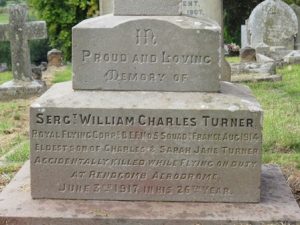
William Samuel Watkins, Private, 5176, Devonshire Regiment. William was born in 1894, the son of Samuel William Watkins and Hannah Maria Watkins (nee Bevan), of 12, Priory Hill, Brecon. Samuel served an apprenticeship as a cabinet maker at Brecon as a young man, but left his job to work for the Midland Railway. He enlisted at Brecon into the Brecknockshire Battalion, South Wales Borderers soon after the outbreak of war and was posted to the 2/1st Brecknocks. In April 1915 the battalion moved to Dale, in Pembrokeshire, to join the Milford Haven defences. William was drafted to the Middle East on 3 July 1915 to join the 1/1st Brecknocks, which had left Britain for Aden soon after the outbreak of war. The battalion had endured a torrid time in the arid deserts of Aden and in August 1915, soon after William’s arrival, embarked for India to be put on garrison duties. William volunteered to transfer to the 1/6th Battalion, Devonshire Regiment soon after his arrival, as the battalion was under orders to move to Mesopotamia with the 36th Indian Brigade and on 5 January 1916 landed at Basra, before joining the 14th Indian Division to take part in the campaign to drive the Turks out of Mesopotamia. William survived the first few months in Mesopotamia but in November 1916 became ill, contracting dysentery, and was hospitalised. He gradually became weaker and died in hospital on 30 December 1916. The 22-year-old was buried in Amara War Cemetery, Iraq.
Albert Webster, Sergeant, 35010, South Wales Borderers. Albert was born on 28 August 1879, the son of George Webster and Ellen Webster (nee Vaughan), of 92, The Watton, Brecon. His father, an army pensioner, later ran the Prince of Wales Inn, next door. Albert had left home as a young man and enlisted into the Royal Welsh Fusiliers. He served in China during the Boxer Rebellion of 1900 and was also present at the Relief of Peking. Albert was discharged from the Royal Welsh Fusiliers in 1904 and returned home to Brecon, where he married Annie Matilda Boxhall on 2 September 1907. By now Albert was living at 88, The Watton, Brecon and working as an insurance agent. By 1911 the couple had moved to 282, Caerleon Road, Newport where Albert still worked as an insurance agent. He enlisted into the South Wales Borderers early in 1916 and upon being drafted to France was posted to the 10th Battalion, South Wales Borderers. The battalion was attached to 115 Brigade, 38th (Welsh) Division and had probably moved to the Ypres Salient by the time that Albert arrived, taking over the Canal Bank sector at Boesinghe. The infantry battalions of the Division then began carrying out the normal pattern of rotation in the trenches, four days in the front, four in support and four in reserve, whilst also working on trench improvement, digging new trenches, and carrying out regular patrols and trench raids. On 31 July 1917 the Division launched its famous assault on the Pilckem Ridge, capturing Iron Cross and reaching its objective of the Steenbeek, then played a supporting role in the Battle of Langemarck. The Division was transferred to the Sailly-sur-la-Lys sector in September and remained in the area over the winter before being moved to positions north of Albert, at Bouzincourt Ridge, at the end of March 1918, relieving the battered 2nd and 47th Divisions. It held this sector, again carrying out minor operations and trench raids, over the coming months. On 6 June 1918 the 10th SWB was holding the support line in the Mesnil Sector when the Germans opened up a ferocious artillery barrage upon some neighbouring gun positions. Albert was badly wounded by a shrapnel burst from a German shell which fell short, hitting the battalions positions. He was evacuated to a nearby dressing station where he died of his wounds soon afterwards. The 38-year-old was buried in Varennes Military Cemetery, France. A younger brother, Douglas Gordon Webster, was killed near Ypres in 1918, whilst his brother-in-law, Thomas John Hodson, died in 1916.
Douglas Gordon Webster, MC, Lieutenant, Machine Gun Corps. Douglas was born on 25 November 1891, the son of George Webster and Ellen Webster (nee Vaughan), of 92, The Watton, Brecon. His father, an army pensioner, later ran the Prince of Wales Inn, next door. After leaving Brecon County School, Douglas began work as a clerk for the Midland Railway at Brecon, where he became one of the mainstays for the towns football team. By 1911 he was lodging at 16, Bowman Street, Carlisle where he still worked as a railway clerk for the company. He had been a member of the Brecknockshire Battalion, South Wales Borderers prior to the war, so was mobilised with the battalion in August 1914, returning home to Brecon to join the battalion. The battalion was attached to the Welsh Division and moved to Pembroke Dock upon mobilisation. It was then withdrawn from the Division and on 29 October 1914 sailed from Southampton for Bombay, where the battalion transhipped and sailed for Aden, arriving on 16 December 1914. The battalion endured a torrid time in the heat of Aden, losing several men to heatstroke. In August 1915 the battalion moved to India on garrison duties. Douglas only spent a short while in India as he was discharged for a commission as Second Lieutenant in the East Surrey Regiment on 15 November 1915, and returned back to England for officer training. Douglas then served on the Western Front with a battalion of the East Surrey Regiment. He returned home on leave early in 1918 and on 11 February 1918 married Edith Elizabeth Hutchings at Llangattock, who he had met whilst at the regimental canteen at Grantham. Upon his return to France, Douglas joined the newly formed 21st Battalion, Machine Gun Corps. The battalion had been formed from the merging of the Machine Gun Companies of the 21st Division, which was in positions stretching from Épehy to Vaucelette Farm, facing the Hindenburg Line. At dawn on 21 March 1918 the Germans opened up an overwhelming offensive along a section of the Western Front running south from Croisilles to La Fère, and the 21st Division found itself under heavy attack and over the coming days was forced to withdraw. On 1 April the battered division was relieved and entrained for Flanders, detraining at Locre, to rebuild in a quieter sector, but on 9 April the Germans opened up the second phase of their offensive along the Lys Valley, and the division was once more caught up in desperate fighting. Douglas, in command of a gun section during the heavy fighting which ensued, kept his gun crews in action against overwhelming odds before the survivors were forced to withdraw. For this act, he was awarded the Military Cross later that year. The citation, published in the London Gazette of 24 September 1918, read: ‘For conspicuous gallantry and devotion to duty during an enemy attack. He kept his guns in action under heavy shell and rifle fire until forced to leave by enemy bombers at close range. Later, he gave great assistance to troops defending a village, and was instrumental in checking the enemy’s advance. He set a fine example of courage and determination.’ The Germans switched their attention further south in May 1918, so the 21st Division was transferred back to the Somme sector to rest and rebuild, remaining here over the coming months. The division then took part in the opening of the great Allied offensive on the Somme on 21 August 1918, helping break the Germans lines, before taking part in the great advance which followed. Douglas was killed during a day of heavy fighting near Fins on 29 September 1918. Although originally buried on the battlefield by his men, the 29-year-old has no known grave and is, oddly, commemorated on the Tyne Cot Memorial, Belgium, whereas he should be commemorated on the Vis-en-Artois Memorial, in France. An elder brother, Albert Webster, died of wounds in France in 1918, whilst his brother-in-law, Thomas John Hodson, died in 1916.
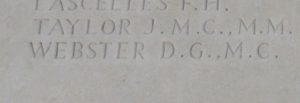
Arthur James Whatley, Company Sergeant Major, 4680, South Wales Borderers. Arthur was born near Warminster in 1875, the son of William Whatley and Grace Whatley (nee Hobbs). He left home as a young man to work as a haulier at Bedwellty, then on 4 July 1894 enlisted at Bedwellty into the 4th Battalion, South Wales Borderers. Arthur continued to serve with the regiment over the coming years, slowly rising through the ranks, and by 1911 had reached the rank of Sergeant. He had lived at the Depot in Brecon for several years and on 8 October 1913 married Caroline Mary Elizabeth Annie Skinner of 5, John Street, Brecon. Their only child, a daughter, Annie Mary Tudora, was born the following year. Following the outbreak of war Arthur, now a Company Sergeant Major, embarked for France with the 1st Battalion, South Wales Borderers and disembarked at Le Havre on 13 August 1914. The battalion was attached to 3 Brigade, 1st Division and entrained for the Belgian frontier, near the town of Mons. The Division then took part in the Battle of Mons on 23 August, following the German invasion of the low countries, and in the epic withdrawal from Mons to the River Marne, where the German drive on Paris was halted. The Germans then withdrew north and took up defensive positions north of the River Aisne, along the Chemin des Dames Ridge and the BEF advanced before launching a frontal attack upon the German positions. The BEF then began moving to Flanders on 17 October, before advancing from Poperinghe past endless numbers of refugees and took up positions guarding the strategically vital city of Ypres, the 1st Division taking up positions near Langemarck by 21 October. Later that day the division was attacked by hordes of Germans, mainly young student-soldiers, who were mown down by the highly trained British soldiers. The Germans maintained their attacks over the coming days but were held at bay, sustaining terrible losses, and the line here stabilised, so by 27 October the 1st Division moved to positions near Zandvoorde, guarding the Menin Road. On 31 October 1914 the 1st Division faced its sternest test so far, when the Germans attacked its positions on the Menin Road, behind a fearsome artillery bombardment. Arthur was killed in action during the day, in an epic stand by 3 Brigade, which saw all its three infantry battalions virtually annihilated. The 39-year-old has no known grave and is commemorated on the Ypres (Menin Gate) Memorial, Belgium.
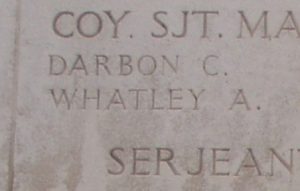
James Richard Wheeler, Private, 5280, Royal Welsh Fusiliers. James was born on 8 September 1895, the son of Eli William Wheeler and Esther Wheeler (nee Morris), of 12, Mill Street, Brecon. He had enlisted at Newport into the Royal Welsh Fusiliers just prior to the war and was drafted to France on 23 November 1914, joining B Company of the 1st Battalion, Royal Welsh Fusiliers, which was in Flanders attached to 22 Brigade, 7th Division. The entire division was rebuilding following terrible losses during the First Battle of Ypres, when it had helped stop the Germans capturing the vital city. The division was in the Neuve-Chapelle sector when James arrived, and he would have taken part in the Christmas Truce that year. On 10 March 1915 the 7th Division took part in the disastrous Battle of Neuve Chapelle, which lasted three days for little or no gain. The 1st RWF then moved to billets at Fort D’Esquin, where it enjoyed several weeks rest behind the lines. By 7 April the 1st RWF had moved to reserve billets at Rue du Bacquerot, and four days later relieved the Royal Scots in the trenches to begin a routine tour in the line, being relieved on 14 April. The battalion enjoyed another period out of the line until 6 May, when it moved forwards again, to take part in the Battle of Aubers Ridge, where the Division launched an assault against the village of Aubers on 9 May 1915. The 1st RWF remained in the assembly trenches, in support of the assault, but the attacking troops made no gains, so the battalion was not called upon, and marched to billets in Essars. On 15 May 1915 the 7th Division took part in another assault, against the village of Festubert. The 1st RWF moved from its billets at Essars that day, marching via Bethune to its starting positions at Rue Cailloux, and at dawn on 16 May 1915 launched its assault on the German lines opposite, ordered to seize the line running from the Rue Quinque to Rue D’Ouvert. The battalion swept through the German front and 2nd lines, before becoming held up, suffering very heavy casualties. James was killed in action during the fighting that day, 16 May 1915. The 19-year-old has no known grave and is commemorated on the Le Touret Memorial, Richebourg-L’avoue, France.
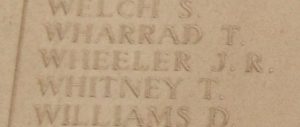
Frederick Alfred Whitcher, Private, 527714, Labour Corps. Frederick was born at Bashley, Hampshire in 1880, the son of Alfred Whitcher and Lucy Whitcher (nee James). His father, a farm labourer, died when Frederick was just five years old and his mother remarried to Edward Lawrence, an estate worker. Frederick worked as a labourer on the same estate as his stepfather as a young man, then in 1908 married Jessie Haywood Payne, a domestic servant from Trowbridge. The couple set up home at Bashley, where Frederick was by now working as a carter at a nursery. Frederick enlisted into the Hampshire Regiment soon after the outbreak of war, with the service number 4326, and was initially posted to the 3/7th Battalion, Hampshire Regiment, which was at Bournemouth. Frederick was drafted to France in the summer of 1916, joining one of the battalions of the South Wales Borderers. He was wounded in France at some time afterwards and was invalided back to England, before being transferred to the 420th Labour Company, Labour Corps, his service number changing to 527714. Frederick was then posted to Brecon to join an Agricultural Company and was billeted in the Barracks. He took ill during the spring of 1918 and died of pneumonia at the Barracks Hospital on 15 March 1918. The 37-year-old was buried with full military honours in Brecon Cemetery. Frederick is not commemorated on the Brecon war memorial.
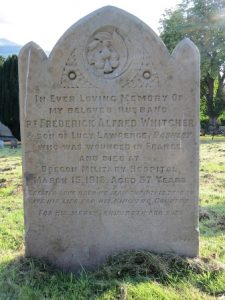
Ernest Whittall, Private, 2935, Montgomeryshire Yeomanry. Ernest was born at Beguildy in about 1882, the son of Richard Whittall. He was raised by his aunt, Hannah Brick, at Acton, Lydbury, before becoming a farm worker at Gunridge, Clunton. Ernest enlisted at Shrewsbury into the 4th Battalion, King’s Shropshire Light Infantry on 12 October 1914, but within less than a month had been deemed unfit and discharged. Undeterred, he re-enlisted into the Montgomeryshire Yeomanry at Knighton and was posted to Slwch Camp, near Brecon. Sadly, he became ill and was taken into the Depot Hospital at Brecon, where he died of pneumonia on 25 February 1916, aged 33. He was buried with full military honours in Brecon Cemetery. Ernest is not commemorated on the Brecon war memorial.
Arthur John Williams, Lance Corporal, 11541, South Wales Borderers. Arthur was born at Llangwm, Pembrokeshire in 1896, the son of Thomas Williams and Mary Jane Williams (nee Probert). The family was residing at 15, Newgate Street, Llanfaes, Brecon by 1901. Arthur enlisted at Brecon into the South Wales Borderers soon after the outbreak of war. After completing his training, he was drafted to France on 4 January 1915, joining the 1st Battalion, South Wales Borderers, which was attached to 3 Brigade, 1st Division. Arthur joined the battalion at Festubert, as part of a large draft of 240 men. The 1st Division, holding the line near Givenchy, took part in its first major action of 1915 here on 9 May 1915, during the Battle of Aubers Ridge, when it attacked alongside the Meerut Division. The attack of 3 Brigade was held up by a flooded ditch, which the men forded, before being hit by heavy machine-gun fire, and a large number of casualties were suffered before the survivors withdrew. The Division then saw further heavy fighting at the Battle of Aubers, before moving South to Loos, and saw heavy fighting during the Battle of Loos, and the action at the Hohenzollern redoubt from 25 September. The 1st Division wintered in the Loos sector, before moving south to the Somme at the beginning of July 1916. Arthur came home on leave whilst his battalion was on the move but returned to France in time to take part in the heavy fighting for Bazentin Ridge, where he was wounded. He was eventually invalided home, suffering from multiple wounds, and spent several months recuperating before being drafted back out to France, joining the 2nd Battalion, South Wales Borderers. The battalion was in the Arras sector, attached to 87 Brigade, 29th Division, and Arthur probably arrived in time to take part in the heavy fighting for Monchy-le-Preux. The division then moved further north to Ypres, initially to hold the line whilst other units had been withdrawn for specialist training, in readiness for the Third Battle of Ypres, which opened on 31 July 1917. The 29th Division went into reserve whilst the first attacks, the Battle of Pilckem Ridge, took place, then on the night of 14-15 August the 2nd SWB moved into the line facing Langemarck, ready to launch another offensive. On the following day the battalion reconnoitred the ground in front of them, and laid white tapes in No Man’s Land, to guide the attacking troops, and at dawn on 16 August 1917 the 2nd SWB launched an attack on Langemarck. The battalion successfully took its two objectives but had suffered 163 casualties. The Division then had another period out of the line to rest and refit before taking part in further fighting near Poelcapelle. Arthur was mortally wounded here and was evacuated to the Casualty Clearing Station at Dozinghem where he died of his wounds on 6 October 1917. The 21-year-old was buried in Dozinghem Military Cemetery, Belgium.
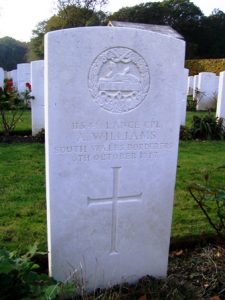
David Price Williams, Lance Corporal, 11199, South Wales Borderers. David was born at Llanrug, Caernarvonshire in 1890, the son of John Williams and Mary Williams. The family moved to Llanberis when David was young, as his father and eldest brother worked there in the slate mines. David moved in with an elder brother to 46, Fron Goch, Llanberis by 1911 and worked as a driver, but at sometime after that moved to Brecon to work. He enlisted at Brecon into the South Wales Borderers soon after the outbreak of war, under the alias of David Price. He was drafted to France on 9 February 1915, joining the 1st Battalion, South Wales Borderers, which was attached to 3 Brigade, 1st Division at Festubert. The 1st Division, holding the line near Givenchy, took part in its first major action of 1915 here on 9 May 1915, during the Battle of Aubers Ridge, when it attacked alongside the Meerut Division. The attack of 3 Brigade was held up by a flooded ditch, which the men forded, before being hit by heavy machine-gun fire, and a large number of casualties were suffered before the survivors withdrew. The Division then saw further heavy fighting at the Battle of Aubers, before moving South to Loos, and saw heavy fighting during the Battle of Loos, and the action at the Hohenzollern redoubt from 25 September. David was probably wounded at some time, as he was later transferred to the 2nd Battalion, South Wales Borderers. The battalion was attached to 87 Brigade, 29th Division and had been evacuated from Gallipoli to Egypt on 11 January 1916, before being transferred to the Western Front, landing at Marseilles on 15 March and entraining for the Somme sector, taking up positions near Beaumont Hamel, facing Y-Ravine. On 3 April 1916 the 2nd SWB took over a section of front-line trenches here for the first time, to begin a routine tour in the line. The battalions first experience of trench life in France was to prove very difficult as over the coming days the battalion endured almost constant enemy artillery fire. David was killed in action during one such artillery bombardment on 6 April 1916. The 26-year-old is buried in Mesnil Ridge Cemetery, Mesnil-Martinsart, France. His brother, Owen Williams, was killed with the 14th Welsh at Mametz Wood in 1916. Both brothers are commemorated on the Llanberis war memorial.
David Thomas Williams, Private, 315646, Cheshire Regiment. David was born on 10 February 1895, the son of David Williams and Elizabeth Williams (nee Hinks), of 3, London Row, Brecon. His father died in 1903, and the young David went to live in Christ College, where he worked as a bootboy. He enlisted at Brecon into the Brecknockshire Battalion, South Wales Borderers soon after the outbreak of war and was posted to Dale, to join the 2/1st Brecknocks. David was drafted to the Middle East on 3 July 1915 to join the 1/1st Brecknocks. The battalion had suffered a torrid time in the arid desert s of Aden, before being posted to India on garrison duties in August 1915. David then transferred to the Cheshire Regiment and returned to England before being drafted to France to join the 10th Battalion, Cheshire Regiment, which was attached to 7 Brigade, 25th Division. The Division had landed in France on 26 September 1915, and was posted to the Vimy area, where it defended Vimy Ridge against a German attack in May 1916. It then moved to the Warloy area and attacked on 3 July near Thiepval. The division fought throughout the Battle of the Somme, before moving to the Ploegsteert sector, where it held the line for the months leading up the Battle of Messines in June 1917. After fighting at Messines, the Division saw further fighting during the early stages of the Passchendaele offensive, before moving south to take up positions around Bullecourt in reserve. Here the Division was used to reinforce the badly depleted British units that were hit in the area by the German Spring Offensive which was launched on 21 March 1918. The division moved north to Flanders on the night of 30 March, taking up positions at Ploegsteert again, where it received reinforcements, and rebuilt. However, on 9 April the Germans launched an offensive on the Lys, and the Division was caught up in the terrible fighting which ensued, suffering heavily as it was forced to withdraw towards Abeele. After just a week’s respite, on 25 April the division was ordered back into the line and took part in the Second Battle of Kemmel. On 9 May the Division moved to Fismes, 20 miles south-east of Soissons in the Champagne, to give it a chance to rest and rebuild again. However, on 26 May the division was ordered to take up positions south of the Aisne, to guard against a predicted German Offensive. On 27 May 1918 the attack hit them, and during the coming days the Division was virtually annihilated. David was posted as missing, believed killed in action during heavy fighting here on 30 May 1918. The 23-year-old has no known grave and is commemorated on the Soissons Memorial, France.
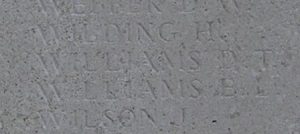
Josiah Rees Williams, Private, 2285, South Wales Borderers. Josiah was born in 1896, the son of Josiah Williams, and Anne Williams (nee Davies), of Garthbrengy. The family later moved to Forge Villa, Brecon. Josiah worked on his parent’s farm prior to the war. He enlisted at Brecon into the Brecknockshire Battalion, South Wales Borderers soon after the outbreak of war and was posted to Dale, in Pembrokeshire, to join the 2/1st Brecknocks. Josiah was drafted to Aden in the summer of 1915 to join the 1/1st Brecknocks, which was on garrison duty there. The climate in Aden was fearsome, with scorching heat during the day, and with little to do, the men spent much of their free time playing football. By June 1915 the Turks had become overconfident due to the lack of any incursions by the British into Yemen and moved forward to reoccupy fortifications at Sheikh Saad. They then began to shell the island of Perim, so the Allied troops in Aden were mobilised into the Aden Movable Company and ordered to prepare to join with local troops. 400 men of the Brecknocks were allocated to the column, the remainder stayed in Aden. A small artillery column was built up to join it and on 3 July the force moved out to Sheikh Othman. Many men collapsed on the march, which was carried out during the full heat of the day, but by 7.30 pm the column had completed its six-mile advance. Josiah was among thirteen men who died of heatstroke during the following day, 4 July 1915, during an even longer march. The 22-year-old is commemorated on the Heliopolis Memorial, Aden, Egypt.
William Morgan Williams, Private, 9337, Welsh Regiment. William was born in Battle, Breconshire in 1897, the son of John Williams and Hannah Williams (nee Morgan). By 1891 the family had moved to Llangrannog, on the Cardiganshire coast, where William’s father had gained work as a gardener. The family had moved to 9, Lion Terrace, Brecon by 1911, and later moved again to 9, Bethel Terrace, Lion Yard, Brecon. William left home to find work as a young man, and then decided to enlist at Penygraig into the Welsh Regiment. By the time that war broke out, he was stationed in Pembroke Dock with the 2nd Battalion, Welsh Regiment. The battalion entrained for the south coast within days of war breaking out and on 13 August 1914 landed in France. The battalion was attached to 3 Brigade, 1st Division and entrained for the Belgian frontier, near the town of Mons. The Division then took part in the Battle of Mons on 23 August, following the German invasion of the low countries, and in the epic withdrawal from Mons to the River Marne, where the German drive on Paris was halted. The Germans then withdrew north and took up defensive positions north of the River Aisne, along the Chemin des Dames Ridge and the BEF advanced before launching a frontal attack upon the German positions. After several weeks of desperate fighting, the BEF began moving to Flanders on 17 October, before advancing from Poperinghe past endless numbers of refugees and took up positions guarding the strategically vital city of Ypres, the 1st Division taking up positions near Langemarck by 21 October. Later that day the division was attacked by hordes of Germans, mainly young student-soldiers, who were mown down by the highly trained British soldiers. The Germans maintained their attacks over the coming days but were held at bay, sustaining terrible losses, and the line here stabilised, so by 27 October the 1st Division moved to positions near Zandvoorde, guarding the Menin Road. On 31 October 1914 the 1st Division faced its sternest test so far, when the Germans attacked its positions on the Menin Road, behind a fearsome artillery bombardment. During the day, 3 Brigade was almost annihilated, being overwhelmed and surrounded by the Germans, but a counterattack by the Worcester’s saved the day and the survivors withdrew to Sanctuary Wood, near Hooge, where they began to dig new support lines. The 2nd Welsh had no time to rest, however, as the Germans maintained a constant artillery bombardment over the coming days, before 3 Brigade was ordered forward again on 6 November to support the 7th Cavalry Brigade as it unsuccessfully attempted to recapture Zwarteleen. The fighting then calmed down, but on 11 November the Germans attacked along the whole nine miles from Messines to Polygon Wood, in an action known as the Battle of Nonne Boschen, and the 2nd Welsh were caught up in desperate fighting once more, around Shrewsbury Forest. William was killed in Shrewsbury Forest on 13 November 1914. The 27-year-old has no known grave and is commemorated on the Ypres (Menin Gate) Memorial. Interestingly, William appears to have had a daughter, Hannah Williams, with a servant girl, Mary Emma Stoneman, from Saltash. Mary married another soldier, Thomas James Debnam, in 1913 and he died on active service in 1915.
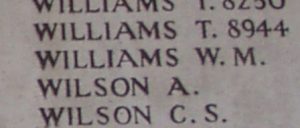
Charles William Henry Winstone, Private, 29521, Border Regiment. Charles was born on 31 July 1899, the son of Penry William Winstone and Jessie Annie Winstone (nee Probert), of 24, The Struet, Brecon. Upon leaving Brecon County School, Charles began working for Coppage and sons, ironmongers in Brecon. He enlisted in Brecon into the Training Reserve in 1917 and was initially posted to a Training Battalion affiliated to the Cheshire Regiment. Upon being drafted to France, Charles was to have joined a battalion of the Manchester Regiment, but was instead posted to the 8th Battalion, Border Regiment. The battalion was attached to 75 Brigade, 25th Division and had been in France since September 1915. The division had fought at Passchendaele at the end of 1917 before being moved south to Bullecourt in reserve, where it wintered. Here the Division was used to reinforce the badly depleted British units that were hit in the area by the German Spring Offensive, which was launched on 21 March 1918, counter-attacking towards Vaux Wood before being forced to withdraw with the rest of the line. The division moved north to Flanders on the night of 30 March, taking up positions at Ploegsteert, where it received reinforcements, and rebuilt. However, on 9 April the Germans launched an offensive on the Lys, and the Division was caught up in the terrible fighting here, taking part in a gallant rear-guard action as it withdrew over the coming days. The Division withdrew to Abeele on 17 April, but on 25 April was ordered back into the line, and took part in the Second Battle of Kemmel. On 9 May the Division began entraining for Fismes, 20 miles south-east of Soissons in the Champagne, to give it a chance to rest and rebuild again. However, on 26 May the division took up positions south of the Aisne, to guard against a predicted German Offensive. On 27 May 1918 the attack hit the division, and during the coming days the Division was virtually annihilated. Charles was posted as missing following the fighting of 27 May and was later reported as having been taken prisoner of war and being safe in Germany. Sadly, he was being kept in squalid conditions in a German POW camp near Laon. He contracted dysentery whilst in the camp and died in a German Hospital there on 16 August 1918. The 19-year-old was initially buried in St. Vincent German Military Cemetery at Laon, but in December 1920 the British graves within the cemetery were exhumed and re-interred in Vendresse British Cemetery, France.
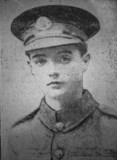
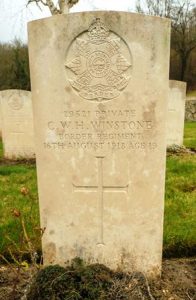
David Joseph Wood, Private, 267198, Royal Warwickshire Regiment. David was born on 6 December 1892, the son of Richard Wood and Sarah Ann Wood (nee Jenkins), of 29, Newgate Street, Llanfaes, Brecon. He worked as a miner prior to enlisting at Wrexham in March 1914 into the 3rd Battalion, South Wales Borderers. David was discharged at Pembroke on 23 October 1914 as being medically unfit. He married Ellen Thomas on 24 April 1915, and the couple resided at Fern Cottage, Johnston. David re-enlisted at Milford into the Welsh Regiment, and was one of several local men posted to the 2/7th Battalion, Royal Warwickshire Regiment, part of 182 Brigade, 61st (2nd South Midland) Division. The Division had been in France since 21 May 1916, moving to positions at Fromelles, where it was virtually decimated. Such was the damage to the Division that it was not used again other than for holding trench lines until 1917, when it followed the German withdrawal to the Hindenburg Line, capturing Chaulnes and Bapaume. Later that year it fought at Battle of Langemarck, as part of the Third Battle of Ypres, and in late August and early September it was involved in the efforts to push the line forward at positions around Schuler Farm and Aisne Farm near Kerselaar. The Division then moved south, where it was to take part in the Battle of Cambrai. 61st Division was initially held in reserve and was still in the area when the enemy made a determined counterattack on 30 November. The Division was ordered up to reinforce the units under attack in the area of La Vacquerie and for some days was involved in a hard fight to stem the enemy attack. During March 1918 the Division was holding the forward zone of defences in the sector northwest of Saint Quentin, in the area of Ham and lost many men as it fought a chaotic but ultimately successful withdrawal back over the Somme crossings over the next ten days. David was one of many men lost in the first days of this terrible fighting. He was killed in action on 22 March 1918, aged 25, and is commemorated on the Poziéres Memorial, France. David is also commemorated on the Steynton war memorial, in Pembrokeshire.
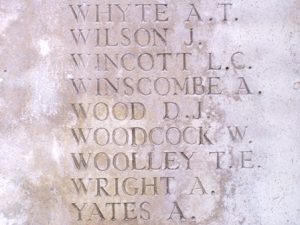
Milton Horace Wood, Private, 5841, Royal Army Medical Corps. Milton was born as Milton Horace Hoyland in Dewsbury, Yorkshire in 1888. By 1891 he was residing with his Aunt Zilpah Wood (nee Hoyland), and her husband Harry Wood at 38, Thomas Street South, Halifax. Milton had gained work as a Brewer’s Clerk by 1911, but following the death of his adopted mother the following year enlisted into the Cardiff City Police Force. Milton enlisted into the Royal Army Medical Corps as soon as war was declared and on 15 August 1914 embarked for France with the staff of the 3rd General Hospital, RAMC. He married Frances May Davies, of Brecon, on 12 December 1915 whilst home on leave, and their only child, a daughter Sybil Iris Wood, was born on 11 September 1916. Milton returned to duty on the Western Front after his marriage, but in May 1917 was transferred to another unit in Egypt. On 3 May 1917 he boarded the requisitioned steamer HMT Transylvania at Marseilles and later that day the ship set sail for Alexandria with an escort of two Japanese destroyers, the Matsu and the Sakaki. At 10.00 on the following day, Transylvania was struck in the port engine room by a torpedo from the German submarine U-63 whilst off the Cape Vado in the Gulf of Genoa. The damaged ship headed for land, whilst the Matsu came alongside to take off the troops. Soon afterwards a second torpedo hit Transylvania which sank within 30 minutes. Milton was among some 400 men and women who drowned during the sinking of the Transylvania that day, 4 May 1917. The 29-year-old has no known grave and is commemorated on the Savona Memorial, Italy. His widow Frances lost her brother Wilfred John Davies during the war, when he was killed on the Somme in 1916. After the war she married Charles Lewis Davies, the owner of the Wheatsheaf Inn at Brecon.
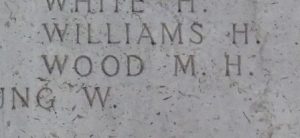
William Thomas Wood, Private, 115810, Machine Gun Corps. William was born on 6 May 1898, the son of Henry Wood and Hannah Wood (nee Watkins), of 8, London Row, Brecon. His father, originally from Hardwick in Herefordshire, was a carpenter in the town who also served with the Brecknocks. William enlisted into the Army Service Corps, but was then transferred to the 237th Company, Machine Gun Corps, training as a specialist machine-gunner. The company had been formed at Grantham and after completing its training embarked for France at Southampton on 13 July 1917, joining the 21st Division at Moyenville on 17 July. The division had seen heavy fighting during the Battle of Arras over the preceding months, especially during the terrible fighting around Bullecourt and the 237th Company, MGC was immediately sent into the line, taking over positions in front of Moyenville. At the beginning of September, the division began withdrawing from here and started making the move northwards, into the Ypres Salient, to take part in the great Passchendaele offensive. Upon reaching Ypres, the division was then transferred south again, to join the Cambrai offensive, which was in danger of collapsing following the launching of a German counterattack on 30 November. The division moved to Hamel before going into position at Villers-Faucon by 17 December and remained in the area over the New Year. William had by now began to suffer from poor health and was evacuated to the 12th General Hospital at Rouen early in January 1918. He died there of disease on 29 January 1918. The 19-year-old is buried in St. Sever Cemetery Extension, Rouen, France.
Leonard Woolford, Private, 3238, South Wales Borderers. Leonard was born in Walworth, London in 1893, the son of Theresa Woolford, a domestic servant from Oxfordshire. His mother married Alfred Ernest Miles, a Welshman, in London just prior to the turn of the century and Leonard was raised as his son. Leonard left home as a young man and by 1911 was lodging at 8, The Postern, Brecon with the Thomas family, whilst he worked as a printer’s apprentice at the Brecon County Times. Prior to the war he lived at Cadmore House, St John’s Road Brecon. Leonard enlisted at Brecon into the Brecknockshire Battalion, South Wales Borderers soon after the outbreak of war and was probably initially posted to the 2/1st Brecknocks. He was drafted to India at the beginning of 1916 to join the 1st Brecknocks, which had moved to Mhow on garrison duty following a tortuous time in the arid deserts of Aden. Leonard took ill soon after arriving Mhow and was hospitalised with a fever. Sadly, he died soon afterwards, of septicaemia, on 19 July 1916. The 22-year-old was buried in Mhow New Cemetery, India. He is also commemorated on the Kirkee Memorial.